Playing the violin is one thing ... performing on it is another skill entirely! The reason for this is that physiologically, everything changes when you start to play music to somebody else ... and that requires a set of skills all its own!
When you join ViolinSchool for the first time, we take you through comprehensive performance training during your first term, so that you can play with confidence from the very first time you perform.
“To rely on muscular habit, which so many of us do in technique, is indeed fatal. A little nervousness, a muscle bewildered and unable to direct itself, and where are you? For technique is truly a matter of the brain.” Fritz Kreizler, violinist and composer 1875 -1962
Visualisation, the process of creating compelling images in the mind, is one of the most valuable tools for learning and integrating skill, building confidence and achieving success, yet we constantly underuse it in our lives and our violin practice.
Visualisation accelerates the learning of any skill by activating the power of the subconscious mind, focussing the brain by programming the reticular activating system - the filter which mediates information and regulates brain states - to seek out and use available resources, and by raising the level of expectation, motivating a better result.
Scientists have found that the same regions of the brain are stimulated when we perform an action and when we visualise performing that action: If you vividly imagine placing your left hand fingers on the fingerboard of your violin, your brain activates in exactly the same way as if you were actually doing it – your brain sees no difference between visualising and doing. This research is used to great effect to help stroke patients reactivate muscles that have lost their facility: It has been found to be possible to build strength in a muscle that is too weak to move by simply repeatedly imagining the movement.
[MM_Member_Decision isMember='false']You will need to register for ViolinSchool membership in order to read the rest of this article! Click here to see all the benefits of becoming a member, and to join today![/MM_Member_Decision][MM_Member_Decision membershipId='1']You currently have a free account! To read the rest of this article, you will need to register for ViolinSchool membership. Click here to see all the benefits of becoming a member, and to join today![/MM_Member_Decision][MM_Member_Decision membershipId='2|3']The process of visualisation, which was initially dismissed by many as unfounded, is described in W Timothy Gallwey’s 1974 book, The Inner Game of Tennis.
“There is a far more natural and effective process for learning and doing almost anything than most of us realize. It is similar to the process we all used, but soon forgot, as we learned to walk and talk. It uses the so-called unconscious mind more than the deliberate "self-conscious" mind, the spinal and midbrain areas of the nervous system more than the cerebral cortex. This process doesn't have to be learned; we already know it. All that is needed is to unlearn those habits which interfere with it and then to just let it happen.
Visualisation simply makes the brain achieve more. Sports psychologists and peak performance experts have been popularising the technique since the 1980s, and it has been integrated into almost all mainstream sports and performance coaching, success programmes and business training.
Athletes using guided imagery and mental rehearsal techniques can enhance their performance by creating mental images to intend the outcome of a race. With mental rehearsal the body and mind become trained to actively perform the skill imagined. Repeated use of visualisation builds experience and confidence under pressure, maximising both the efficiency of training and the effectiveness of practice. This principle applies to learning anything new. According to Jack Canfield, in his 2004 book, The Success Principles, Harvard University researchers found that students who visualised tasks before performing them, performed with nearly 100% accuracy, where those who didn’t use visualisation achieved only 55% accuracy. This is also true when applied to the process of learning the violin, both during practice time and performance.
“Fortune favours the prepared mind.” Louis Pasteur, chemist and microbiologist, 1822 - 1895
Most of us are familiar with the idea of reading ahead in the music, or of hearing a note or pitch before playing it. Visualisation - not only conceiving of a phrase before playing it, but vividly imagining the sound, how it feels, where the fingers will fall, how the hand will move in a certain shift and even how the performance will go - is a much deeper way of mentally absorbing and preparing the information. It is also one of the best ways to rid your practice of monotonous repetition and develop awareness of your musical actions.
It’s all very well knowing how great visualisation can be, but how do you go about it? What happens if you close your eyes and don’t seem to be able to see anything?
There are two different ways of visualising, depending on your brain type, both of which are absolutely legitimate. Some people are what psychologists refer to as eidetic visualisers. When they close their eyes they see things in bright, clear, three-dimensional, colour images. The majority of people, however, are noneidetic visualisers. This means they don’t really see an image as much as think it. THIS WORKS JUST AS WELL!
Before we look at how we can apply visualisation techniques in violin practice, let’s look at an example exercise from The Inner Game of Tennis, in which the aim is to hit a stationary target with a tennis ball:
“Place a tennis-ball can in the backhand corner of one of the service courts. Then figure out how you should swing your racket in order to hit the can. Think about how high to toss the ball, about the proper angle of your racket at impact, the proper weight flow, and so forth. Now aim at the can and attempt to hit it. If you miss, try again. If you hit it, try to repeat whatever you did so that you can hit it again. If you follow this procedure for a few minutes, you will experience what I mean by "trying hard" and making yourself serve. After you have absorbed this experience, move the can to the backhand corner of the other service court for the second half of the experiment. This time stand on the base line, breathe deeply a few times and relax. Look at the can. Then visualize the path of the ball from your racket to the can. See the ball hitting the can right on the label. If you like, shut your eyes and imagine yourself serving, and the ball hitting the can. Do this several times. If in your imagination the ball misses the can, that's all right; repeat the image a few times until the ball hits the target. Now, take no thought of how you should hit the ball. Don't try to hit the target. Ask your body, Self 2, to do whatever is necessary to hit the can, then let it do it. Exercise no control; correct for no imagined bad habits. Having programmed yourself with the desired flight of the ball, simply trust your body to do it. When you toss the ball up, focus your attention on its seams, then let the serve serve itself. The ball will either hit or miss the target. Notice exactly where it lands. You should free yourself from any emotional reaction to success or failure; simply know your goal and take objective interest in the results. Then serve again. If you have missed the can, don't be surprised and don't try to correct for your error. This is most important. Again focus your attention on the can; then let the serve serve itself. If you faithfully do not try to hit the can, and do not attempt to correct for your misses, but put full confidence in your body and its computer, you will soon see that the serve is correcting itself. You will experience that there really is a Self 2 who is acting and learning without being told what to do. Observe this process; observe your body making the changes necessary in order to come nearer and nearer to the can, Of course, Self 1 is very tricky and it is most difficult to keep him from interfering a little, but if you quiet him a bit, you will begin to see Self 2 at work, and you will be as amazed as I have been at what it can do, and how effortlessly.”
You can already see how this same exercise might be applied to practising a particular shift or bow stroke, any specific element of your piece that requires a certain physical movement to gain a result.
Here are some more practice and performance ideas from The Musician’s Way, A Guide to Practice, Performance and Wellness by Gerald Klickstein, 2009
Start using visualisation in your practice. You will find you achieve much better results and increased confidence, you can practice at antisocial hours of the day or night, you can save tired muscles, and you will develop a much deeper, intuitive understanding of the instrument and the music. Visualise, imagine and mentally prepare at least as much as you physically play. As you practice visualising it will become easier to integrate it at speed and under pressure.
Visualisation is counter-intuitive in a culture where we are taught to try, try, try again, but it is without doubt the single most powerful practice technique that most of us don’t use!
“If you cannot visualise what it is you wish to become, then the brain doesn’t have the first clue how to get you there." Chris Murray, Author of The Extremely Successful Salesman’s Club
London String School is a violin school in the heart of London that offers lessons to adult learners of all ages and levels. The school is dedicated to providing a supportive and nurturing environment for adult learners who are passionate about playing the violin.
Formerly known as the 'London' branch of ViolinSchool.com, the London String School has evolved into a specialised education centre catering exclusively to adult learners.
With a renewed focus on violin, viola, cello, and double bass, the school now has its own identity, operating independently with a dedicated website at https://london.stringschool.uk/.
The school offers a range of classes, courses, and ensembles to suit adults of all ages and levels, including beginner, intermediate, and advanced.
Learners range in age from 16 to 80+, including many busy professionals who work in London and love playing the violin when not at work. People come from a wide range of backgrounds and experience levels - it’s a diverse community of passionate musicians, where everyone is welcome!
All tuition is carefully designed to cater to the needs of adult learners, regardless of their prior musical experience. The school’s experienced teachers provide personalised instruction to each student, ensuring that they receive the guidance and support they need to achieve their goals.
A Supportive Musical Community
At London String School, the emphasis is not only on individual growth but also on fostering a sense of community among adult learners. The school boasts world-class tutors and provides a friendly environment where musicians of all levels can come together.
From group settings to ensembles and performance groups, the school creates opportunities for like-minded individuals to connect, make friends, and share the joy of making music.
Specialist Education for Adult Learners
The tutors at London String School are experienced at understanding the unique challenges faced by adult learners.
This can include issues as diverse as muscle flexibility, busy lifestyles, preferred learning styles, differences in primary music knowledge (such as do-re-mi-fa-so-la-ti-doh versus a-b-c-d-e-f-g!), and much more.
Whether you are taking your first steps into the world of music or seeking new challenges as an advanced player, the school understands the subtle differences that high quality adult learning requires, and builds these principles into their well-established curriculum.
World-Class Tuition
London String School is built on a long legacy of high quality instrumental tuition, dating back to 2008 when it started as 'London Violin Studio' and later became 'ViolinSchool London.' In 2023, it evolved into London String School and deepened its focus on adult learners.
The school offers a range of tuition formats, including private lessons, group courses, and ensembles. The renowned 10-week courses provide a structured curriculum, based on curricular research that originated at the Royal Academy of Music.
Passionate About String Instruments
The school encourages students to tap into their deepest motivations, guiding them through repertoire that aligns with their musical interests. London String School believes in the power of a vibrant community, where students can connect with knowledgeable experts and fellow enthusiasts. As a result, music becomes a tool for bringing people together, allowing students to explore their creativity and musicianship.
Learning in London
Acknowledging the busy life in London, the school offers flexible scheduling, convenient central locations, and world-class resources. Students have control over their musical development, with the flexibility to practice sheet music and class activities at their own pace. Learning an instrument becomes a therapeutic antidote to the stress of city life, providing a unique way to relax and meet like-minded people.
Tuition Formats to Suit Busy London Lifestyles
The academic year consists of three 10-week terms, starting in September, January, and April. The school offers a variety of learning formats, including classes, courses, ensembles, one-to-one lessons, and concerts. This ensures continuous opportunities for growth and a well-rounded musical experience. The options include:
Classes - one-off group tuition sessions
Courses - a series of group tuition sessions, usually as part of a 10-week course
Ensembles - group performance opportunities, where learners work together to prepare for a performance
Lessons - one to one personal coaching, organised privately between learner and tutor
Concerns and Events - opportunities to perform in front of a real, live audience!
You can browse the full list of tuition options, including all classes and course types, on the ‘Tuition’ section of the LSS website:
https://london.stringschool.uk/collections/tuition
First-Time Beginners and Restarters
In addition to a full program of sequenced courses through to intermediate and advanced levels, London String School offers a popular Introductory ‘Fundamentals’ Class which is an ideal way for adults to try the violin for the first time.
The class is ideal for:
You don’t need a violin, as there are violins available in the studio for this introductory class. You also don’t need to read music, as the whole session is taught by ear - no experience is needed!
The Introductory ‘Fundamentals’ class runs regularly throughout the year. You can find a list of upcoming dates, and book the class online here:
https://london.stringschool.uk/products/introductory-fundamentals-violin-class
Get in Touch with London String School Today
If you’re an adult who would like to develop your violin playing to the next level, then you can get in touch with London String School via email, website livechat, or phone (+44 (0) 20 3051 0080) for an informal chat about the available tuition options, and how LSS can help you reach your learning goals.
Browse the full range of Classes and Courses on the website:
https://london.stringschool.uk/
Breaking down a piece of music to improve coordination, especially for a string instrument like the violin, is a valuable practice.
It’s particularly helpful to do this when learning a new piece of music, to avoid becoming overwhelmed by all the different pieces of information that you need to process simultaneously.
Here's a more detailed breakdown of the steps:
Step One: Master Individual Elements
Step Two: Combining Skills
Combine clapping the rhythms with simulating bowing motions. This helps you connect the timing of your bow strokes to the music.
Simulate both finger movements and bowing at the same time, connecting the left and right hand coordination.
Step Three: Incorporating the Violin
Sing or say the rhythms as you play!
Verbalise the bowings as you play!
Sing or say the finger numbers as you play!
Sing or say the notes as you play!
Step Four: Increasing the Tempo
At each step, use a metronome to identify the fastest tempo at which you can CONSISTENTLY complete the task - in time, in tune and (when you are playing the violin) with a good sound.
Once each task is secure, you can incrementally increase the speed until you reach the tempo you wish to use for performance.
**
By following these steps, you’ll improve your coordination, making it easier to play the piece on the violin.
Remember that practice and repetition are key to mastering any musical piece!
Learning to play a musical instrument is a rewarding endeavour that knows no age limits, so it’s never too late to realise your dreams of playing the violin!
For adult learners, there are few better places to get started than in London, England, because of the wide number of learning options available for beginner violin tuition tailored specifically for adults.
London also boasts a world-class music scene with live music concerts featuring the violin and other string instruments almost every day of the week … so you’ll never be short of inspiration!
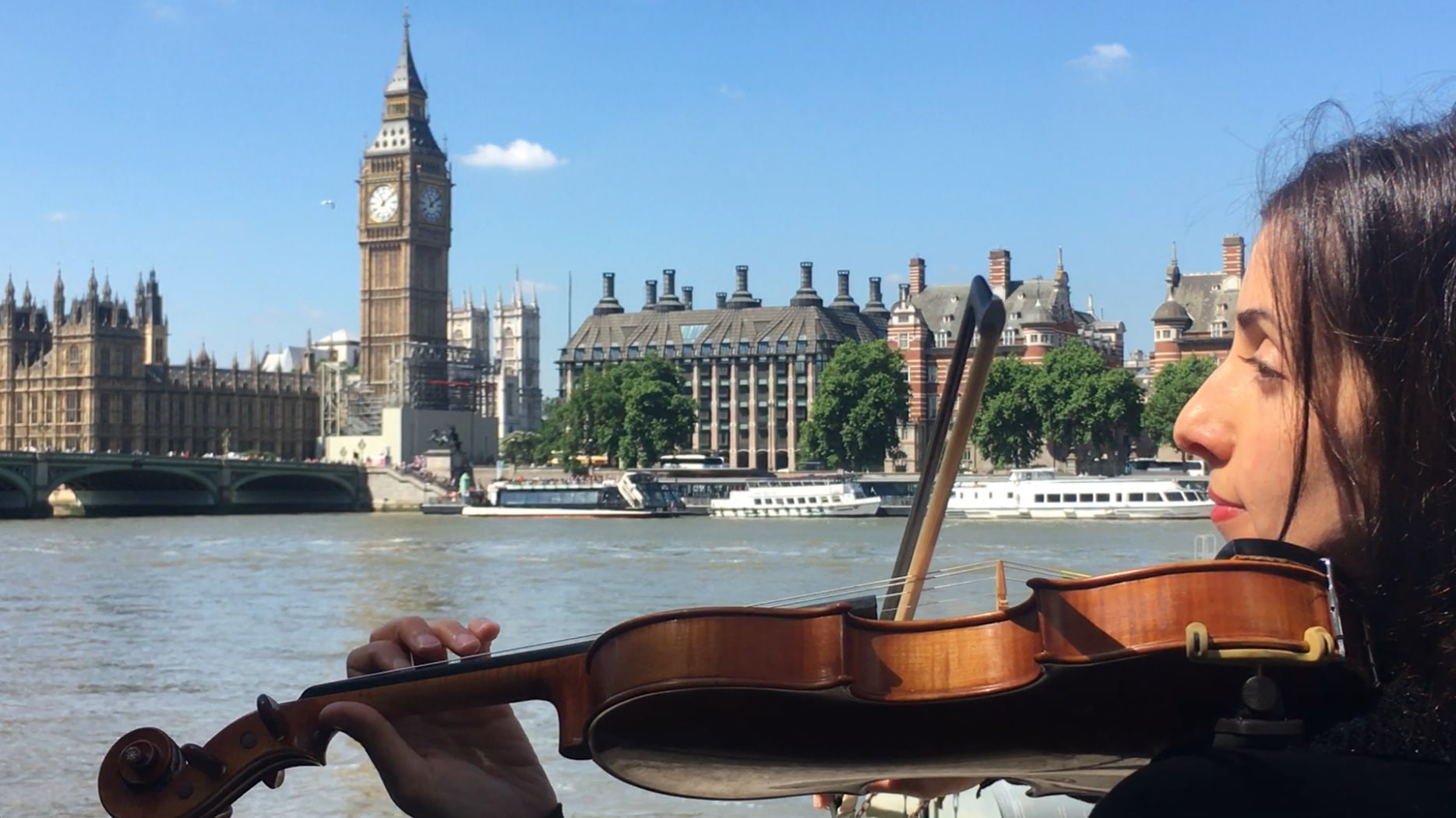
Why Choose Violin?
The violin is often considered one of the most enchanting and versatile instruments.
Its expressive melodies and intricate techniques make it a popular choice for individuals of all ages looking to explore their musical interests.
Learning to play the violin can be a fulfilling way to challenge yourself, enhance your cognitive abilities, and cultivate a lifelong appreciation for music.
It can also be a wonderful social experience, and a great opportunity to meet new friends who share your love of music!
However, the violin is an intricate instrument to learn, so it can be easy to pick up bad habits or make a bad sound if you don’t get the right advice from the start.
Therefore, it’s important to find a high quality tuition option from the very beginning.
Tailored Tuition for Adults
Fortunately, London offers several options for adults who are interested in learning the violin.
Although many music schools and private tutors in London specialise in teaching children, there are also some teachers and schools who understand the unique needs and requirements of adult learners too.
As an adult learner, your considerations for a choice of tutor can include practical issues such as availability, and flexibility of schedule - this is especially important for adult learners who have a busy work schedule during the week!
But teaching violin to adults is very different from teaching children, so a professional teacher will also understand issues such as:
Muscle flexibility and physical movement considerations - older learners can be highly capable, but may require more specific muscle flexibility exercises than younger learners, in order to develop certain technical skills
Previous musical experience (if any), and how this affects the learning process - often adult learners will have very little memory of music theory, and will not know how to leverage their intuitive musical ability. Some adult learners may have very minimal musical experience.
Cultural differences - often, adults who have travelled to London from another country to study or work, will have learnt some music skills through a non-western system such as Solfeggio (doh-re-me), an Indian musical tradition such as Hindustani or Carnatic violin, or class music lessons at school.
Motivation - adult learners in London will often have a variety of reasons for learning, ranging from the need to relax and rejuvenate after busy working week, to personal development and goal setting, to connecting with new friends and becoming part of a musical community.
**
In all of these different areas, a skilled violin teacher who specialises in adult learning will be able to bridge these gaps quickly and effectively as possible for each individual adult learner.
Group Tuition or Private Lessons?
One of the first decisions you need to make as an adult learner in London, will be whether to seek a private tutor for one-to-one lessons, or a group class or course where you can learn alongside fellow students.
There are advantages to both formats, so it is sensible to consider both options.
In our experience, a blend of group tuition and some supplementary personal tuition is the right balance of the majority of adult learners in London.
Cost-conscious learners on a tight budget can also achieve great results through group tuition alone, especially through intelligent use of quality learning resources.
Group Tuition specifically designed for adults, provides:
Private Lessons offer benefits including:
Additional considerations:
Private lessons from an experienced, high quality teacher are usually more expensive than group tuition, so this should always be considered if your budget is tight.
Also, music is social. So if you choose primarily to learn through one to one lessons, then it’s important also to find a group, ensemble or orchestra appropriate to your experience level, so that you can play with other musicians regularly and build up your rehearsal and performance experience.
If you’re unsure about which format is right for you, we recommend joining the Violin Fundamentals class run by our colleagues at London String School.
This one-off class takes place frequently in London and is suitable for first-time beginners, restarters, or for learners who want to revise the first principles of good playing technique.
It’s taught by ear, so you don’t need to read music in order to participate. A violin can also be provided for the class if you don’t already have an instrument of your own.
To learn more, take a look at the London String School website for more information:
It’s never too late … get started today!
It's never too late to embark on a musical journey, and learning the violin as an adult in London can be an incredibly rewarding experience.
With a range of options available, from traditional lessons to online resources, you can choose the path that best suits your preferences and lifestyle.
So, pick up that violin, and let the music begin!
When we listen to music, we enter an expressive world full of soaring melodies and flowing emotions. But as with any language, there’s an essential technical foundation that underpins the relationship between the notes and the human soul.
Music theory takes us into the detail of sound, time and pitch, and all the other aspects of music. It gives us clarity about how and why music works, and gives us a language of written symbols that we can use to communicate effectively and quickly with other musicians.
Understanding Music on a Deeper Level
Imagine listening to your favorite song and being able to decipher the hidden layers of melodies and harmonies. This is where the significance of music theory becomes paramount.
Music theory is not just a set of rules; it's a key that unlocks a deeper level of understanding in every chord progression, every rhythm, and every musical phrase.
It allows us to venture beyond just superficial listening, and immerse ourselves deeply in the music we hear.
Enhancing Your Musical Performance
Just as learning to read and write empowers us to communicate effectively, understanding music theory empowers us to communicate better through our instruments.
Think of music theory as an alphabet for musicians. It’s an array of symbols and notations that form a universal language. The better you know the alphabet, the more flexibility and freedom you will have when using it, and the more expressive you will become as a musician.
A solid knowledge of music theory elevates your performance, so that it becomes more than just playing notes; a deep understanding of how music works can transform your playing into a heartfelt conversation with the audience.
The Language of Musicians: Communication and Expression
Have you ever witnessed a flawless group performance that seemed almost telepathic? That remarkable synergy between musicians develops by conversing in the language of music theory.
Although the exact use of musical symbols and terminologies do vary between cultures and languages, the sounds and musical elements they represent are universal.
This is why music is often described as a ‘universal langage’ - it bridges genres and backgrounds, and eliminates barriers to communication, even where spoken language cannot.
If two highly experienced musicians from different parts of the world were to meet in passing, they could communicate fluently together straight away through music, because of their shared understanding of how to convey emotion and artistic expression through music.
For some musicians, this is a very intuitive skill, built up through aural traditions passed on over a long period of time. But it’s quicker and more effective to understand music theory analytically as well as intuitively, which is why most professional musicians read music fluently.
Professional Pathways and Opportunities
For those who choose to follow a professional musical path, a solid foundation in music theory is essential for navigating unknown musical territories.
It opens doors to diverse career opportunities - teaching, composing, arranging, and roles within the music industry.
A clear knowledge of music theory gives musicians better and easier communication when working with new people, or when playing genres of music where they do not have expert knowledge of the style.
Written Music Notation
Music composers who understand how music theory works, are able to convey their intentions precisely through written notation. This allows their ideas to be accurately recreated, even when they are not physically present.
‘Notating’ the music in written form is a tradition that is now hundreds of years old, and which allows us to accurately perform music from hundreds of years ago - as far back as the Renaissance and Medieval periods.
Music theory gives us the ability to represent emotions and artistic expressions in a structured and deliberate way. It’s a way of capturing and communicating musical ideas which are otherwise impossible to put into words!
Cultivating Creative Expression
Music theory is a canvas, not a cage! It shouldn’t feel like something that inhibits your creativity - to the contrary, it should provide a structured framework that nurtures our creative impulses.
Once we know how tools such as scales, intervals, and chord progressions work, we become far more able to create and communicate our own musical ideas.
Mastering the technical skills of music theory gives us the fluency to weave our own musical narratives, and create, communicate or perform music that is truly representative of our individual musical voice.
Analysing and Appreciating Music
Unlocking the door to music theory opens a world of analytical listening. It's like having a musical magnifying glass that reveals the intricate details woven into each composition.
Through music theory, we learn to dissect the fundamental components of music such as chords, melodies, and rhythms, and uncover the nuances that elevate a piece from mere sound to a profound work of art.
Understanding Historical Context
Every piece of music is influenced by the era in which it is created. Music theory provides the key to deciphering how trends and conventions of a particular time are influential in the choices of a music composer.
As we understand the evolution of musical techniques, styles, and trends, we can see each piece of music in historical context. This helps us to create better informed interpretations of older music. It also gives a profound appreciation of human creativity over the centuries!
Cognitive Benefits Beyond Music
In addition to the practical benefits of applying music theory in day to day music making, it also benefits our cognitive faculties, by stimulating problem-solving, pattern recognition, and memory skills.
These benefits extend beyond the realm of music, enriching our overall cognitive abilities and enhancing our mental acumen.
Personal Enjoyment and Cultural Awareness
Deeper understanding of music theory can heighten our personal enjoyment of music. We can often connect with music on a visceral level, once we are able to extract meaning from the very fabric of sound.
Music theory also gives us technical insight into how musical traditions differ across cultures. This reveals the unique musical expressions that define human societies across the globe.
Teaching and Sharing Knowledge
Imagine being the guide who ignites the spark of musical passion in others. Music theory equips us with the tools to teach and share knowledge effectively.
Whether you’re teaching formally as an educator, or just passing on your wisdom and knowledge to less experienced musicians as you work and play together, you can use the language of music to nurture growth in others, and help them discover their own musical voice and identity.
Theory Explains How Music Works
Music is one of the most extraordinary and wonderful experiences in life, and it can transcend cultural differences to bring people together in the most beautiful way. But to achieve this can be complicated, and can seem mystical and other-worldly.
Music Theory helps us to achieve a deeper level of technical understanding about how this unique ‘language’ works, which in turn unlocks the tools we need to be able to communicate, collaborate and perform more effectively as musicians.
Embrace music theory to unlock whole new worlds of possibility in your life as a musician!
Violin exams are a really useful way to track the progression of your learning! They provide a structured path for progress, clear goals to work towards, a solid way of assessing your skills. You’ll also get a real a sense of achievement when you finally complete the examination itself!
While exams can be nerve-wracking, proper preparation can go a long way in easing the stress and ensuring success. Let's take a look at the essential steps for preparing for a violin exam... 🎻 🎓
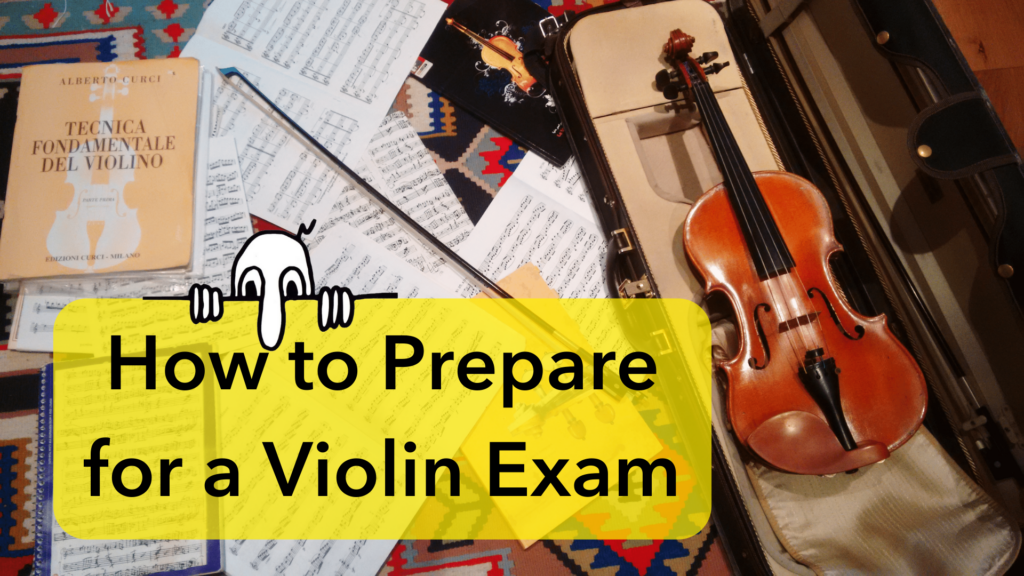
Seem obvious, doesn't it? But you'd be amazed at how many people enter themselves for an exam first, and then don't learn all the music until close to the date of the exam itself.
'Cramming' information might work for some topics, but not for playing the violin! You need time for the music and the technical skills to 'sink in' to your intuition, so that in the exam itself you can play fluently and confidently, without needing to stop and think about how you're doing it.
The amount of time you'll need to prepare depends on the level of the exam, the complexity of the syllabus, and your existing skills. The earlier you begin, the more time you'll have for practice, and for reviewing and refining your skills. This will all help to avoid last-minute stress and anxiety!
Before you start, take the time to properly understand the exam requirement. Each exam board will publish their information in a booklet called a 'syllabus', which is usually available in both print and digital format.
It's important to get this right, because if you make a mistake now, you could end up invalidating your exam result by preparing the wrong scales, aural tests ... or even the wrong piece (it can happen!).
Make sure to take time to research your exam board's website, and become familiar with the exam structure, grading criteria, and other relevant information ... before you start practising the exam materials!
There are several different music examination boards, and depending on your location, you may have several options to choose from.
If you're working with a teacher or personal tutor, they may have a preferred system they'd like you to use. If you're learning on your own, you'll have to make this decision yourself.
Here are a few of the main music examination boards that provide violin exams:
You need to get this right! When choosing pieces of music that you want to learn for your exam, it's obviously essential to select something that's right for your skill level and for the requirements of the exam. But it's also important that you actually like the music and enjoy playing it ... otherwise you won't be motivated to practise!
A good strategy is to select pieces of music that challenge your existing skills a little bit, but aren't so excessively difficult that you end up struggling to learn new skills in time for your exam.
This way, you can make sure that all technical challenges are dealt with early in the learning process, leaving you plenty of time to focus on performance practice before the exam itself.
This is an area where good advice from your teacher or school can be invaluable. If you're a member of ViolinSchool, you can consult with our Learning Advisors and get a second opinion.
Not yet a member of ViolinSchool? Whether you're working on your own or with a teacher, ViolinSchool's resources can help you achieve better results in less time. Find out more about our Membership and Enrolment options or join ViolinSchool today!
If you define the outcome you want, then you're much more likely to achieve it ... and that's as true for violin exams as it is for anything else! Setting a clear goal will help you to focus your efforts, monitor your progress, and stay motivated.
Think about what result you want to achieve. Do you care only about passing the exam, or are you wanting to maximise your potential, pass with Distinction, and achieve the highest mark you can? This decision will affect how you approach your violin practice in the lead up to the exam.
Traditional goal-setting techniques can be very useful. A good example would be the use of 'SMART' goals (specific, measurable, achievable, relevant, and time-bound). When you have clarity about what you want to achieve and when, then it's much easier to adapt your practice plans accordingly.
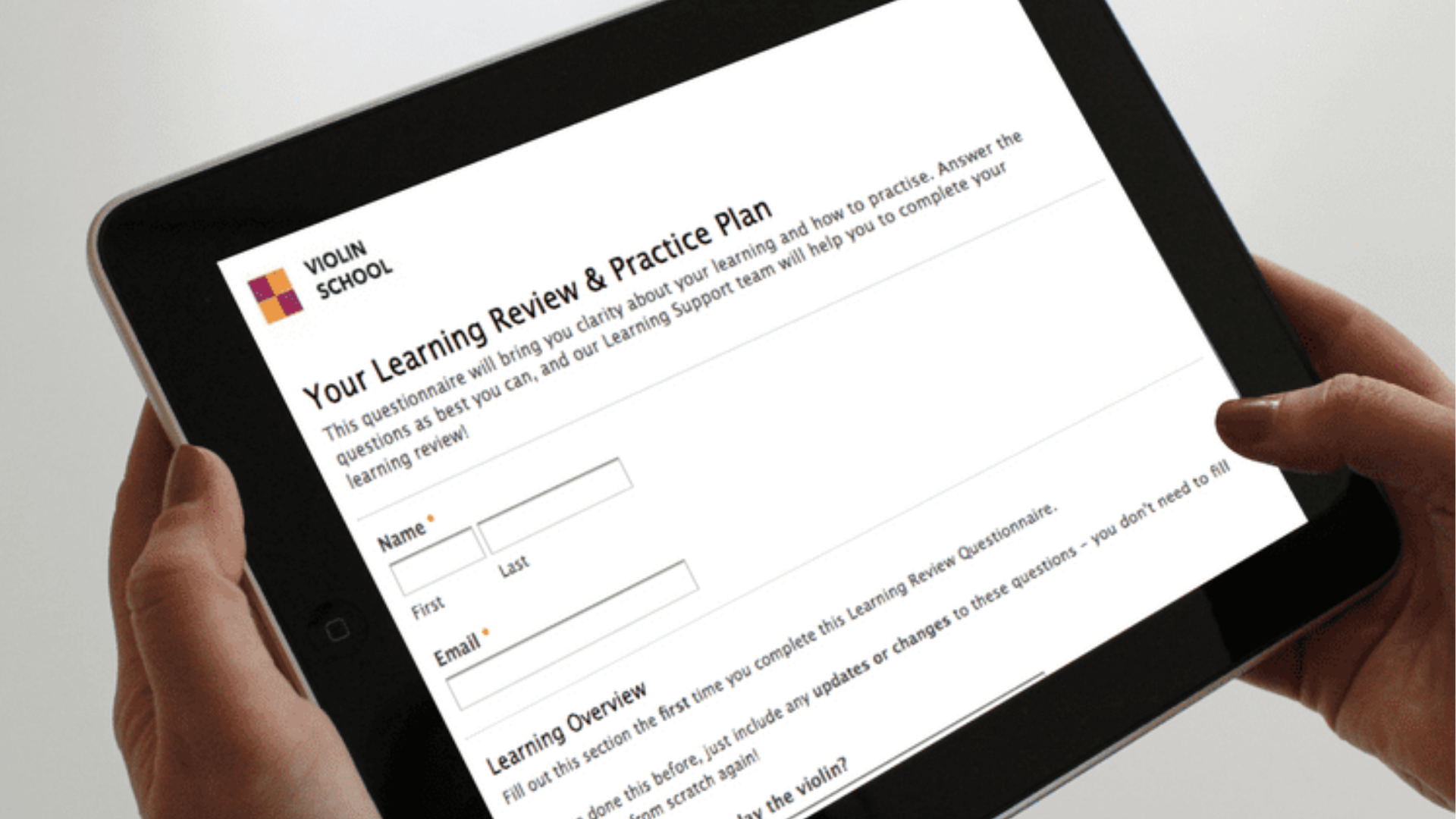
Once your desired outcome is clear, then you can create a practice plan to help you achieve the results you want. This will include your practice schedule, your practice activities, and a clear benchmarks or milestones for measuring whether you are on track.
If you are enrolled at ViolinSchool, we'll do this with you in the form of a Learning Review, followed by a practice plan. If you're a member of ViolinSchool but you're working with a private tutor, then feel free to download and use the Practice Plan and Practice Journal tools to help you keep on track.
You might also like to consider keeping a journal of your violin practice. This is a great way of reflecting on what you have achieved - especially before sleeping, so that your subconscious mind can continue working on the music when you are asleep!
As with any piece of music, your first priority should be to make sure that the musical and technical essentials are in place. A good principle is to ask yourself:
To get the best possible results in your exam, you need to be able to answer 'yes' to all three of these questions! If you can't, then analyse your technique to find out what's not working properly - seeking proper advice from an experienced teacher (or us!) if you need.
Once you know that you are achieving technical accuracy with your playing, then you can focus increasingly on musical factors, such as the dynamics, character, shape and expression of the music.
Scales and arpeggios are obligatory in most violin exams, because they are so helpful for developing finger dexterity and intonation. Ideally you should be aiming for a reasonable level of speed, but never compromising your accuracy - it's better to play a scale slightly too slow but beautifully in tune, than at a faster speed with imperfect intonation!
Your first priority should be to identify any new scales or arpeggios which you'll need to learn for your exam. Put aside time early in your exam preparation to learn any new scales, so that you can start familiarising yourself with the finger patterns and building up the muscle memories.
But you should also develop a routine for all of your scales, including the ones you already know! If you don't have time to practise every scale every day, make sure that you regularly rotate which scales you include in your practice.
This will avoid any unpleasant surprises a few days or weeks out from the exam, when you might suddenly 'discover' a scale or two that you've forgotten about...!
Also, remember that arpeggio patterns are just as important as scales! A common mistake is for people to focus so intently on scale practice, that they forget to practise the arpeggio patterns. Don't let that happen to you!
Treat scales and arpeggios equally, and you'll find that before long, your left hand will start becoming much more fluent in the keys that you are learning ... which will benefit the whole of your playing, for the examination and beyond!
Aural and musicianship skills are formally tested in most violin exams, but they're essential for good violin playing and music making anyway. The ideal situation would be that your aural and musicianship skills are so instinctive for your technical level, that you can respond immediately to any rhythm or pitch tests, almost without thinking about it.
Unless you've played another musical instrument to a high level, or you do a lot of singing, you'll almost certainly need to include aural and musicianship skills in your practice routine. This can be great fun!
Leave time to sing and read sheet music every day ... and this doesn't need to happen only at the violin! Whether it's singing during your morning shower, or practising rhythm patterns whilst you're going for a walk, it's good to get creative about how you integrate music into your daily routine!
Exactly the same is true for sight-reading as for aural and musicianship skills. Most exams will formally test your ability to sight-read, but being able to read music fluently and accurately is an essential skill for musicians anyway ... so build it into your daily practice!
It's important to use a wide variety of music when practising sight-reading. This way, you'll build up the ability to sight-read in lots of different keys, time signatures, and styles.
Some exam boards publish 'specimen' (sample) sight-reading books for you to practise with, and there are also good book sequences such as the Right@Sight series (by ViolinSchool's Caroline Lumsden!), and Improve Your Sight-Reading! by Paul Harris.
Start with simple pieces, then gradually increase the difficulty level. Use a metronome at first, if you need help staying in time.
Most importantly, don't stop! When sight-reading, you must not stop and correct mistakes like you would do when practising. The fundamental skill of sight-reading is the art of keeping going in time ... even if you play some wrong ones!
We learn better when we can model someone else doing the same task. So make a point of listening to recordings of the music you'll be playing in your exam! By listening to professional recordings of the pieces you are studying, you'll gain ideas for how to interpret and phrase the music.
This will help you to develop a more nuanced and expressive performance, which will be more enjoyable to listen to (including for your examiner!).
Don't limit your listening just to the pieces you are learning. Try listening to different pieces of music by the same composers of the music you're playing. Or the same styles of music, but by different composers.
This will help you to become more familiar with different styles and periods of music, as well as the historical and cultural context of the pieces you are studying. The more you understand about the music and how to interpret it, the easier it will be for you to give an engaging and well-informed performance!
Don't forget to practice performing! Performance is a learnable skill, just like everything else, and you need to understand how the change in your physiology in a performance situation will affect your technique ... particularly for a violin exam!
It won't feel natural to perform the violin just to one person (your examiner) in a room - it's a very artificial environment. Add to that the pressure of knowing that your single audience member (the examiner!) is there for one single purpose - to judge and assess your violin playing! - and you can count on the fact that your performance in the exam itself will feel significantly different to playing alone in a practice room (or even to a violin teacher).
Therefore, it's essential to leave time in your practise for 'performing' your exam materials, to see what changes happen to your violin playing in a high-pressure situation.
You don't know what you don't know! And that alone is a good reason why feedback and guidance from a qualified violin teacher or coach is usually essential for a successful exam performance.
Even if you're an experienced learner or musician, you will benefit from advice that gives an alternative perspective on how you're doing what you're doing. And you'll definitely progress quicker with the help of a good teacher, than if you are learning only by yourself.
Good feedback will help you to identify and address areas of weakness effectively. Tailored guidance and support can be extremely helpful for everything from goal-setting to developing an effective practice routine.
At ViolinSchool, our enrolment option includes a range of live classes and learning support, which provides guidance that's invaluable if you're preparing for a violin exam.
If you've already taken the time to understand the criteria for the examination level you're working towards, then you can start to assess your progress and identify areas for improvement by comparing your playing against the benchmark criteria. But you need to be objective.
One of the best ways to do this is to record yourself playing your exam pieces, and watch/listen back. Identify areas of weakness, but also make a note of what IS working, in order not to waste time on unnecessary topics (and to keep your motivation high). Then, adapt your practice routine as necessary.
It's also a good idea to re-read the criteria that your exam board publishes. This is often available in the format of a document that clearly outlines the expectations an examiner will have for each band of results.
For example, the ABRSM offers a clear, bullet pointed breakdown of what an examinee will need to achieve in the areas of Pitch, Time, Tone, Shape and Performance for each different marking level. They publish additional bulleted breakdowns of what is expected across the different sections of repertoire, scales and arpeggios, sight-reading and aural tests - again, with a list of expectations for each marking level.
This is an extremely useful tool for being able to work out clearly whether you are on track with each different element of the exam!
Because a violin exam can feel like such an unusual and even artificial environment, it's going to feel very different to when you are playing the violin in other contexts.
To prepare for this, one of the most helpful things you can do is to simulate the situation by creating a 'mock exam'. Ideally this would be with a piano accompanist (so that you can get used to performing with another musician), and in a room that's similar to where you'll be taking the exam.
But even if you don't have access to these resources, just moving to a different space from where you usually do you piano practice, or having another person present to take the role of your examiner, can help you to get the adrenaline flowing and feel the sensation of performing 'under pressure'.
If you don't have anyone to assist you, then just set up a soft toy, a picture, or even a favourite potted plant to take the role of the examiner! Even a small change in your environment will help.
When you are simulating a mock exam, be sure to follow the same format that you will experience in the exam. Play everything in the right order, and without stopping - even if things go wrong, keep going!
This will give you a realistic sense of what it will be like on the day, and will help enormously with getting used to the feeling of performing in a pressured situation.
Make sure the simple, obvious things are taken care of! On the day of the exam, arrive early. Assume you will have transport problems and allow time for delays! Before you leave home, make sure that you have everything you need ... including your music and your violin (yes, we've seen it happen!).
Think about how the weather might affect you - especially if it is very hot or cold. Dress appropriately - and smartly. First impressions count, and an exam is no different.
Of course, how you play is far more important than how you present yourself! But even a single mark can make a big different between the category of result you achieve. Examiners are human, and they may be more inclined to be generous rather than strict towards a candidate who is well presented and polite.
Once you arrive at the exam venue, warm up your hands and fingers. Focus on your breathing, and use tone production exercises, scales and arpeggios to help yourself get 'into the zone' of focus and concentration.
During the exam, constantly think ahead and clearly imagine what you are going to do play next, and how you want it to sound - let your training kick in, and your body will do the rest. Stay aware of your posture and your breathing - so long as everything remains balanced and physically relaxed, you'll be able to maintain good tone quality.
If you notice any tension developing, physically or mentally, just focus on your breathing and on what's coming next, and it will soon pass. Always be thinking ahead about the music that's coming up.
If something goes wrong or you make a mistake, just move on. If it's a small mistake it might not matter at all, and if it's a big mistake you'll only lose a couple of marks at most, so just recover quickly and move on. What you don't want is for your focus and concentration to suffer - then more things are likely to go wrong.
Keep a positive energy throughout, and remember that ultimately, every examiner WANTS to enjoy your performance and give you the best result possible. So give them that opportunity - play the music the way you think best expresses the character and emotion of the music. If you do this authentically, they'll feel it too!
Although preparing for a violin exam is an excellent way to build skills, don't fall into the trap of orientating ALL your violin learning around the exam itself.
It's just as important, if not more so, to think about your overall growth as a violinist. So as you prepare for your exam, leave plenty of time for other activities that will contribute to your musical and violinistic development.
Explore different pieces of music, genres and composers, and try to build a well-rounded repertoire. This is also a helpful focus if you have worked intensively on your exam pieces for a few days, and need to set them aside for a short period of time before coming back to them. Playing different repertoire in the meantime can help you come back to your exam music with a fresh perspective.
Also, a good selection of music for a violin exam will usually be within your technical capability. But you do need to continue challenging yourself to go beyond your comfort zone, too. Rather than risk your exam results with a choice of repertoire that's to difficult, a much more sensible strategy is to explore more challenging repertoire alongside your easier exam repertoire.
There are plenty of other creative activities that you should try to integrate into your violin practice, which fall beyond the requirements of an exam, simply because they're good for your musical development.
Try to improvise and compose music regularly, and learn about the harmony of the music that you are playing. Improvisational skills can improve almost all aspects of your violin playing, but they often don't feature in examination requirements.
Once you're committed to an exam, the preparation process can sometimes feel like a chore - for example, if you don't feel like practising but you know you still have to do so (it happens to us all!).
So it's important to maintain your motivation and enjoyment by feeding your love for violin and music making beyond the process of exam preparation itself.
Taking the time to listen to lots of music and attend live performances is a really good way of doing this. Try to connect and network with other musicians, and people who share your interests - it can often open up all sorts of opportunities in your local community and beyond!
Experiment with different genres and don't limit yourself just to the more 'classical' repertoire that is used by the majority of music exam boards. The violin is extremely versatile, and can be played in all sorts of styles, from classical to folk and jazz and much, much more ... your creativity is the limit!
Finally, remember what it's all about. A lot of your focus in exam preparation will be on technical skills, and although they are extremely important, making music is, for most people, ultimately about the expression and communication of emotion.
Constantly expanding your sense of phrasing, dynamics, interpretation, and musical shape is a crucially important aspect to your identity as a musician and as a violinist - as are the nuances of your sound, and the tone quality you create using your violin. You'll achieve this not by completing functional challenges set by examination boards, but by getting out there, making music, and seeing what works and what doesn't!
Always be exploring, and stay musically curious. Then, when you bring your musicianship into the examination environment, it can only benefit your ability to communicate and perform (which in turn will contribute to a better exam result!)
Preparing for a violin exam can be an intense but ultimately very rewarding experience. Start preparing early, set clear goals, practice consistently, get quality feedback, approaching the exam holistically as you would for any other performance.
Not only can you develop the skills to pass an exam, but you can use the examination framework to push your musical development forwards, and become a more well-rounded and expressive violinist.
Enjoy the process, and keep pushing yourself to new heights ... Good Luck!
Have you discovered any top tips for violin exam success that we haven't mentioned here? We'd love to know! Tell us at [email protected] and we'll add good suggestions here, to help other violinists achieve success in their exams!
Need help preparing for an exam? ViolinSchool can help you get the best results, whether you have a personal tutor or not! Email [email protected] or get in touch with us using the form below. Or take a look at our Membership and Enrolment options, and join ViolinSchool today!
[wpforms id="128143"]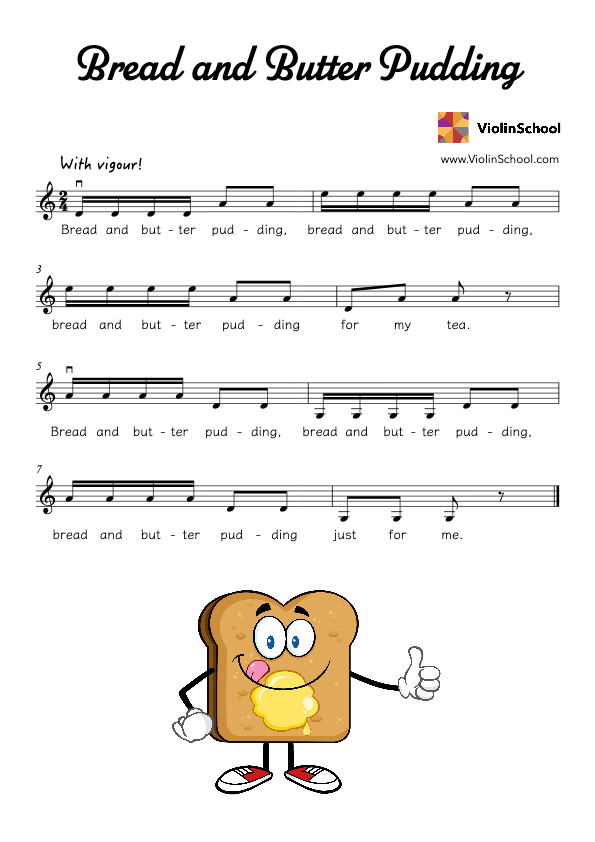
Title: Bread and Butter Pudding
Description: Whisk together lots of scrumptious 8th notes (quavers) and 16th notes (semiquavers) to create a delicious performance of this sweet treat of a piece!
Level: Open Strings
Topics: Quavers, Eighth Notes, Semiquavers, Sixteenth Notes, Quaver Rests, Eighth Note Rests
[wcm_restrict] Click here to download it!37Scc
[/wcm_restrict] [wcm_nonmember] Join ViolinSchool today for instant access!This download is for ViolinSchool members only! Click here to become a Member of ViolinSchool and get instant access to all library downloads!
[/wcm_nonmember]
Learning to play the violin can be a challenging and rewarding experience, but it can also be difficult to know where to start if you're teaching yourself. Here are some tips to help you get started:
Remember that learning to play the violin is a journey and it takes time and dedication to master the instrument. But with patience, persistence, and practice, you can teach yourself to play the violin and become a skilled musician.
Once you’ve completed Violin Fundamentals, you’ll know the principles of how to play in time, in tune, with a good sound.
Now it’s time to master those skills!
Our carefully graded sequence of courses takes you smoothly from beginner to intermediate level, consolidating your skills through activity-based tasks, technical instruction, and fun repertoire (pieces of music).
Course A introduces the G, D and A major patterns, and gets you playing well-known classic tunes like Frère Jacques and Twinkle Twinkle Little Star.
Course B helps you achieve confidence and fluency across all the skills you’ve learnt so far, and introduces C major and 2-octave scales in G, as well as tunes such as Ode to Joy, Happy Birthday, and other longer pieces of music.
Course C and D build up your technical skills across a wide range of topics, from vibrato to minor scales to shifting to bow strokes … and much, much more!
You can register for a course at any time, directly online here: https://www.violinschool.com/product/courses/
Once you’ve completed Course D, you’ll be ready to expand your repertoire and technical skills through our multi-level Technique & Repertoire classes, which offer guided practice for all ages and levels.
AS FEATURED ON:
The Violin Course is ViolinSchool's core training program for violinists of all ages and levels. It's a sequence of 10-week courses that runs from first-time beginner through to advanced level.
There are versions of the course for Adults and for Children & Parents.
There are versions of the course for Remote Learners and also for in-person learning at our school in London, England.
This is the information page for Adult Courses (Remote / International Learning).
ENROL NOW!TALK TO A LEARNING ADVISOR
A high quality, comprehensive sequence of 10-week violin courses, to take you step-by-step from first-time player to advanced level.
for Adult Learners
Learn from anywhere! Or come to our school in London, England
Select Country: United Kingdom | USA / International
🌎 You've found the international course page for our remote learning courses!
Summer Term 2022 - The Essential Info!
Term Dates
Term Time: Monday 25th April to Saturday 9th July 2022 - register at any time!
Half Term: Monday 30 May 2022 to Saturday 4 June 2022 (no classes)
Summer Concert (Livestream): Saturday 9th July 2022
Course Fees (Full Enrolment)
GBP £370 or USD $490. Instalment plan available - reserve your place with a deposit of £170 or $190.
Live Classes
See below for class times!
The main instructional classes take place in London on Saturdays, and online during the week. And we now run a whole program of events throughout the week via Zoom, and it's ALL included in your enrolment! Come to as many sessions as you like - it's up to you!
Our live schedule is published in Coordinated Universal Time (UTC). Convert to your timezone here!
All classes take place on Zoom. Wednesday and Saturday instructional classes are relayed live from our school in London, England. See below for class times!
ViolinSchool's comprehensive series of courses takes you all the way from first-time beginner to advanced level. However far you want to go, we'll help you get there.
Three times a year, we open our popular sequence of Violin Courses for termly enrolment, starting in January, April or September. We also have low cost digital only options available.
You can register at any time before the start of a term, and enjoy instant access to all course materials.
Learn Anytime, Anywhere
Learning has changed a lot in the past few years, even faster than expected because of the pandemic, and your location or work schedule is no longer a barrier to joining a violin course.
We still run a dedicated school in London, England, but most of our learners take part in courses remotely, learning from home and enjoying a blend of live online classes, pre-recorded videos, guided self-study, printed coursebooks, and personal coaching.
It's no longer necessary to travel long distances or live in a major city, in order to find a high quality learning experience and achieve remarkable results with the violin.
Live Classes
In addition to self-paced online learning, a Full Enrolment will give you access to live classes that will transform your playing and make your weekly violin practice a pleasure.
All our instructional classes take place on Saturdays, and are relayed via Zoom, live from our London school.
Some instructional classes are offered during the week as well - see the information page for exact timings.
Practice sessions take place only on Zoom, and are an opportunity for you to follow up on what you've learnt in the instructional classes, and to bring questions and get feedback from your tutor in a group setting.
Currently we have live class times suitable for European and American time zones, and we'll be introducing more schedule options in the near future.
All of our classes are recorded for replay, so you can catch up on any sessions that you miss, whenever it's convenient for you.
This is a really popular feature that our learners have found to be extremely useful, and it's all included with full course enrolment.
Achieve Your Potential
The ViolinSchool Violin courses form a comprehensive, step-by-step program that's perfect for anyone who wants to realise their potential as a violinist.
If you're a beginner, the courses will take you from being a first-time player to becoming an accomplished, experienced musician.
If you already play the violin, or you're restarting after some time away, our courses will provide you with a fantastic framework for developing your skills and knowledge, and for gaining lots of playing and performing experience.
Amaze Your Friends and Family!
As you move through the course sequence, you'll build up fluency in both violin technique and note reading, so you'll be able to play your favourite music in time, in tune and with a good sound.
You'll be able to perform confidently to your family and friends, and join in playing with other musicians.
Action-Focused Learning that Gets Results
ViolinSchool's Course sequence isn't just an 'information dump' for you to navigate through, and taking part in a course is way more holistic than just binge-watching a playlist of online videos!
Of course, there's plenty for you to LEARN... but there's much more for you to DO!
Every lesson is really practical, and there are loads of activities for you to follow along with and practice on your violin.
At ViolinSchool, we're really focused on helping you to get great RESULTS.
From the moment you register, we'll be supporting you, and monitoring your progress regularly throughout each term.
We support your learning with our own in-house suite of cutting edge digital tools, including an algorithmic digital curriculum that's always growing and improving, digital music players and apps, and everything else that you'd expect from a modern learning environment.
But most importantly, we have an amazing team of experienced human beings who are here to look after you, help you with every aspect of your learning, and make sure that you're on track, making great progress, and achieving your goals.
Train Your Body ... Free Your Mind
To get there, we focus on training both your mind and your body, so that you're building good habits from the moment you start to play.
Together, using the practice exercises, we'll internalise the technical and music theory skills until your muscle memory is really well trained and reliable.
Then you won't have to worry about your technique whilst you play. You'll be free to focus on expressing the music just the way you want to!
Learning Should Be Fun!
The courses are also a lot of fun! At ViolinSchool, we believe learning shouldn't ever be a chore, because when it stops being fun, you lose motivation.
So, we've gone to great lengths to make sure that the practice activities in the courses are creative, engaging, and entertaining. That way you'll stay *motivated* as you practise.
Master The Fundamentals
Whether you're starting for the first time or you already play the violin, we usually suggest beginning your journey with the Violin Fundamentals.
This two-hour class, which is taught by ear and is suitable for all levels, explores the timeless first principles that every violinist needs to know.
We always recommend coming to a live session if you can, either on Zoom, or at one of our offline locations. This way you'll get personalised feedback from our teachers, and make sure you're starting your learning in the best possible way.
The Fundamentals classes can be booked on their own, but they're also included at no extra cost when you register for Full Enrolment on a ViolinSchool course.
The core sequence itself is divided into several 10-week courses.
Which Course Level is Right for me?
At the beginner level, you'll start with Course A, where you'll learn the G, D and A Major key patterns, and build up fluency in the 1st position.
Course B is focused on consolidating everything from Course A, and also introduces C Major and two octave G major patterns.
From Course C into Course D, we explore more complex harmonic patterns, techniques such as vibrato and different bow strokes, and build up your skills and musical repertoire across a wide range of different styles and playing techniques.
We'll be introducing more course levels in the future, but if you've already reached a level equivalent to Grade 5 at any major exam board, then our Term Pass and ViolinHub programs might be a better fit.
If that's you, follow the links to find out more, or contact us at [email protected], and we'll point you in the right direction.
Please feel free to contact us at any time to request a free consultation.
We'll be very happy to schedule a time to check your level and your instrument setup, discuss your learning goals, and recommend the best place in the course sequence for you to start.
In the meantime, let's take a closer look at what's included when you register for a Violin Course at ViolinSchool ...
What's In The Courses?
Each course contains over 150 lessons, divided into groups that we call 'modules'.
We cover about two modules every week during the term.
Each lesson contains a series of activities for you to practice, and most lessons include either a video, a download, or both.
Let's take a look at the types of resources you'll find in the lessons of your course:
Instructional Videos
Follow along with the ViolinSchool Coaches in real time, as we explain different concepts, show you how to do the practice exercises, and play the pieces of music with you!
Explainers
Downloadable, printable 'Explainer' sheets give you a clear and simple explanation of each topic.
Every new technical concept is introduced with a straightforward explanation, using relatable real-life analogies to introduce each new idea.
Many of these explainers are also available in the printed coursebook, which is included with every Full Enrolment.
Practice Activities
Interactive practice activity videos show you in real time how to practise your rhythm and pitch skills.
Follow along on video with the exercises, by singing, clapping or playing the music, either on screen or from your printed sheets.
Before you know it, your rhythm and pitch skills will be super-focused and reliable!
Exercises
Once you've learnt a topic, you need to practise it until you've mastered it!
For each subject area, the course includes multiple exercises which will help you to build up your muscle memory, and drill in the techniques you need to play fluently and confidently.
Backing Tracks and Recordings
Listening is a crucial skill for good violin playing. Use our video demos to hear the music whilst you follow along with the music notation, either on a printed score or on our built-in digital music player.
Then, switch to the high-quality backing tracks and listen to them as you play the tune. You'll be making music straight away!
All backing tracks can also be downloaded from our library in MP3 format, which is so useful for practising on the move, or making your own practice playlists.
Checklists
It's one thing to understand a concept, but it's another to properly internalise it, so that you can rely on your instincts when you're playing.
Train your muscles and your default body movements using our friendly, colourful, and easy-to-use checklists.
Then you'll automatically make the right technical movements... even when you're busy thinking about something else!
Worksheets
Sometimes you need to work through an idea on a sheet of paper, to make sure that it's really sunk into your brain!
By committing an answer to paper, you'll remember it more clearly - whether it's completing the gaps in a sequence, or filling in notes or musical symbols!
Write your answers on each worksheet, and then check the answer sheets to see if you got it right!
Music Theory
You don't *have* to learn music notation to play the violin... but it makes it a lot quicker, and a lot easier!
That's why each of our Courses includes full music theory training, built right in to the lesson sequence.
Our Musical Fundamentals training course is also included at no extra cost, so that you can revise the basics of music notation, or learn music for the first time if you're a beginner.
Within a few hours, you'll be reading and playing fluently using the sheet music - even if you've never used music notation before!
Sheet Music
Once you've learnt to read music, there'll be nothing stopping you... you can expand your knowledge of different styles and genres by discovering and reading pretty much anything that uses the violin notes!
All of our colourful sheet music is professionally typeset, so it's easy to read and looks great on the page... or on a screen!
There's a big selection of famous tunes in the course, as well as many beautiful melodies written exclusively for ViolinSchool.
Course Curriculum
Over the past 10 years, we've spent a lot of time developing a comprehensive Curriculum that underpins all the ViolinSchool Courses.
The curriculum is constantly evolving and changing according to the latest research, and we work with many thousands of digital datapoints, measurable learning objectives, and other educational best practices, in order to bring you the very best experience as you learn.
To keep things fresh, we regularly update our coursebooks and course materials, so there's always great new music for you to explore.
If you'd like to know more about the academic side of what we do, you can read more on our website.
But know that behind all the fun and colourful exercises, we spend a lot of time analysing and exploring ways to make the learning experience as smooth and carefully sequenced as it can possibly be!
At ViolinSchool, we care passionately about making violin learning affordable and accessible for everyone.
So we've created a few different options to suit a range of budgets and learning styles:
1) Digital Access Only
If your budget is limited, *or* if you already have access to a personal tutor and a supportive musical community, then this may be the right choice for you.
You'll get digital access to the course of your choice, plus everything in ViolinSchool's fast-growing online Library and our Social Learning Network.
Please note that this option *doesn't* include any live classes or replays, or any learning support. So you'll need to be happy practising on your own, without personalised feedback from us.
You can save by paying for your course in full, or spread the cost with four easy monthly payments.
You can sign up right now on the website, for full and instant access to everything in the course, including all the lessons and downloads!
However, we know from talking to many learners around the world that however good a course is, sometimes just having access to the materials isn't enough - especially if you don't have a personal tutor.
That's why for most people, we recommend:
2) Full Enrolment
As well as full access to the course and all materials, you'll benefit from:
Regular Assignments...
Twice during each term, we'll invite you to record and send in a video assignment.
The second video will usually form part of an end of term concert or music video.
You'll be able to upload a short recording, so that we can make sure you're progressing well through the curriculum.
The assignments also earn you optional certification at the end of the course.
Once you get into the rhythm of regular practice, these assignments are incredibly useful for focusing your attention and making sure that you get your practice done!
A Printed Course Book...
Digital music is great... But there's nothing quite like having a proper, full-colour set of printed pages to work from. It just feels different!
Our gorgeous, full-colour printed coursebooks are a delight to use, and they're really high quality.
They're printed by one of the world's leading music printers, then shipped directly to you, wherever you are in the world!
Commitment & Accountability...
Full Enrolment is a way for you to COMMIT to your violin playing. To commit to learning, to practising, and to ACHIEVING your goals as a musician.
Quite simply... deadlines work!
We're all human, and if something doesn't *need* to be done, it's quite likely that it *won't* get done!
But when you have a series of assignments and a final course deadline, as you'll have with full enrolment, then somehow... things get finished!
Recording and Performance Opportunities
It's one thing to learn the violin, but to play and perform in public is another skill entirely!
As well as world class performance training that's integrated into all our courses, you'll also have the opportunity to take part in some amazingly memorable performances and experiences!
Several times a year we create a music video, which you can contribute to from wherever you are.
Our Violin Orchestra also gives performances in various cities, and you are always welcome to visit our school in London, England where we have an ongoing program of workshops and live performances.
The team behind ViolinSchool are all professional performers and producers as well as educators, so we know what it takes to put on a show ... and you can be part of it!
Personalised Feedback & Support ...
One of the most important benefits of full enrolment is that our Coaching Team can commit the time and resources to give you proper support and guidance with your learning.
Once you're enrolled, you'll have direct access to the team at ViolinSchool, and we'll be completely focused on your success.
That means we'll do whatever it takes to make sure you succeed - whether that's giving you extra support on a topic, sending you a personalised video, or just reminding you to get your assignments in on time!
You'll have support from the whole team, including Simon, David, Marisol, Caroline, and all of our administrators and guest tutors.
If for any reason you get stuck on a topic or need extra help, we'll work with you by email, phone or video call until you're absolutely clear on what you need to do to succeed.
Certification
It's important to celebrate success, so we also offer our own certification for everyone who successfully completes a Course.
Not everyone will achieve this! But if you follow our guidance and submit your assignments in time for the course deadline, then at the end of the term, we'll send you a certificate of achievement for the course you have completed.
To maintain ViolinSchool's reputation for excellence and high quality teaching, we only give certification when we are absolutely confident that each learner has not only understood, but also internalised the topics and skills for each level. This protects the value of each ViolinSchool certification.
Once you're enrolled, we are fully focused on your success, and will do everything we possibly can to help you achieve your goals for the term!
All successful course graduates are also offered a reduced rate alumni membership, which includes lifetime access to the course materials, including any future updates.
... and of course, ViolinSchool Membership is included with your course registration, so you'll have full access to the whole of the ViolinSchool Library and all our other digital resources, as soon as you sign up!
3) Personal Coaching
For people who would like even more personalised support, we do have a very limited number of Personal Coaching times available too.
If you'd like to join the waiting list for personal coaching, then contact us by email to express your interest. When your chosen teacher has availability, we'll contact you to invite you for a one to one consultation.
If you'd like to go ahead and join a course, then follow the instructions on the page to submit your registration today.
Or if you'd like to ask a question, find out where you should start in the sequence, or just have a chat about the different options, then just get in touch with us.
You can email [email protected], or call us on +44 20 3051 0080.
Our reception team is available 24/7, so wherever you are, please feel free to call or use the online chat at any time.
If we're not available, leave your name, number and time zone, and one of us will call you back at a convenient time to answer any questions you may have.
We look forward to welcoming you to ViolinSchool soon!
ENROL NOW!TALK TO A LEARNING ADVISOR
Instructional Classes
Thursdays and Saturdays, via Zoom
Not sure of your level? Contact us today for a free consultation
+44 (0) 20 3051 0080 ~ [email protected]
Course Tutors: Marisol Hillier, David Worswick & Simon Hewitt Jones
Click here for times and schedules
Convert class times to your local timezone here.
Saturday classes are relayed live from our school in London, England
Beyond intermediate level we recommend a TERM PASS for unlimited access to workshops and ensembles on Saturdays, without the need to join a course. More details here: https://www.violinschool.com/termpass/
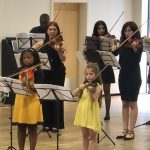 This year's Spring Show will be hosted at our London school at 5pm London time (4pm UTC) on Saturday 2nd April.
This year's Spring Show will be hosted at our London school at 5pm London time (4pm UTC) on Saturday 2nd April.
Although we won't be livestreaming this time (remote participants will be on Zoom as usual), we are recording the event and highlights will be released on YouTube afterwards.
There will be performances by groups from both the Adult and Child courses, as well as the ViolinSchool Ensembles.
The music includes: Danse Macabre, Rieding Violin Concerto, Pastime with Good Company, Bourrée by Bach, Galop, He's a Pirate, and much more!
Guests are welcome! There is no guestlist, and no ticketing - you can just turn up (Yes, after two years of Covid restrictions, this feels odd for us too!).
The venue in London (UK) is:
Pimlico Academy, Lupus Street, Pimlico, London SW1V 3AT
Date/Time: Saturday 2nd April, 5pm London time (4pm UTC)
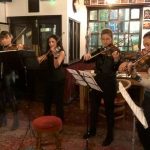 After the concert, there will be a fiddle jam session and everyone is invited! (no entry fee). The address is:
After the concert, there will be a fiddle jam session and everyone is invited! (no entry fee). The address is:
The Grosvenor, 79 Grosvenor Rd, Pimlico, London SW1V 3LA
Music starts at 7.30pm, food and drink will be available.
Here is the concert programme:
Violin Clinics at ViolinSchool are a great way to get personalised, targeted help - quickly, efficiently, and in an interesting way!
Throughout the week during termtime, we run a series of 'clinic' sessions, where a ViolinSchool tutor will help you to solve any challenge - musical, technical, performance, or more!
Clinics aren't just for solving problems - you can simply bring a piece of music that you're working on to get a second opinion, or send in a learning review before the clinic and get help refreshing your current practice plan.
Each participant is guaranteed a minimum of 10 minutes per session (maximum 6 participants per hour's clinic), and we always make practice activities relevant for everyone attending.
Violin Clinics are included at no extra cost for all enrolled learners; it's a great way to get swift, cost-efficient help to solve specific issues, whenever you need!
Welcome to Week 9! Check back soon for links to class content.
7pm UTC - Violin Course A and B Practice Session with Simon (90min)
Topics to be confirmed
9.30pm UTC - Violin Clinic with Simon (30min+)
5pm UTC - Violin Clinic with Marisol (1hr)
7pm UTC - Violin Fundamentals Session 1 & 2 with Simon (120min)
Live from our London school. In the UK? Join us in person!
4.30pm UTC - Children's Course B Practice Session (30min)
Singing, Pitch and Finger Placements
6pm-10pm UTC - Practice Sessions
6pm UTC Level 1 [Fundamentals & Course A]
6.45pm UTC Level 1 [Course B]
To include: Topics to be confirmed
7.30pm UTC Level 2 [Course C]
8.15pm UTC Level 3 [Course D]
To include: Topics to be confirmed
9pm UTC - Ensembles Playthrough (1hr)
Preview: to be confirmed
Playthrough (if time): Allegro in D by Handel, Mazas Duet No.1, Marche Militaire, Chant de Veslemøy, An Elven Adventure
2pm UTC - Violin Clinic with Caroline (1hr)
9am UTC - Adult Course A Instructional class (90min) with Marisol and Simon
G, D and A major scales and arpeggios, Finger Placement, Frère Jacques, Jungle Footprints (slurred), Performance Practice and Concert Preparation
10.30am UTC - Adult Course B Instructional class (90min) with Simon
Rigaudon, Peasant's March, Fiddler on the Loose, Waltzing Matilda, Boney Stegosaurus, Performance Practice and Concert Preparation
10.30am UTC - Children's Course A Instructional class (45min) with Marisol
Topics to be confirmed
11.15am UTC - Children's Course B Instructional class (45min) with Marisol
Topics to be confirmed
12.30pm UTC - Adult Course C Instructional class (90min) with Simon and David
Intonation, Performance Practice, Opposites Attract, Cradle Song, To The Greenwood, Barn Dance, Poor Old Battered Broomstick, Doom and Gloom, The Tale of the Sad, Slow Worm, Chanson Triste, Rumbango
12.30pm UTC - early afternoon Workshops will start again after the Easter break
2.15pm UTC - Adult Course D Instructional class (90min) with David
Intonation, Performance Practice, Intonation Exercises TBC, Dvořák Humoresque, Salutations, Fiddler on the Loose, Rieding Violin Concerto, 1st Movement, Dominant Seventh Gallop
3pm UTC - early afternoon Workshops will start again after the Easter break
4.15pm UTC - Ensembles (90min) with David and Simon
New Music: To be confirmed
Playthrough: Danse Macabre, Pastime with Good Company, He's a Pirate, Allegro in D by Handel, Mazas Duet No.1, Marche Militaire, Chant de Veslemøy, An Elven Adventure
7pm UTC - Live Music Event / Jam Session - ViolinSchool Live at the Grosvenor (45min)
music to be confirmed
*We will introduce new workshops and events gradually over the next few weeks
In the UK? Come and enjoy our new live music series in London!
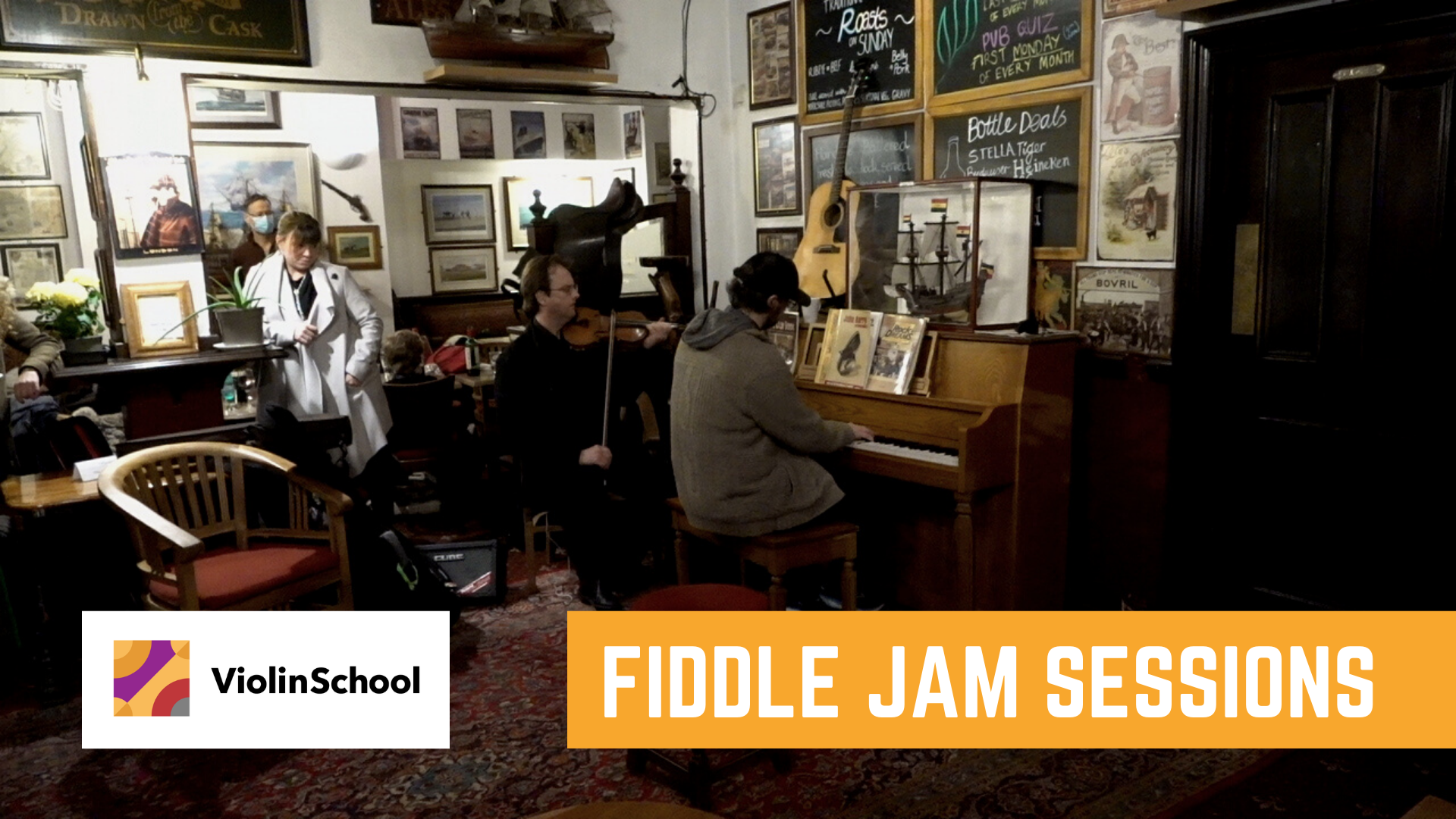
Did you know, the London school is now hosting live music every Saturday evening during term time? From 7pm each Saturday evening during term time, live at The Grosvenor in Central London, our new live music venue!
Each week, there's live music from a featured violinist, pianist or guitarist. It's followed by a jam session where the violinists from ViolinSchool's Courses and Ensembles have the opportunity to join in and play!
After our Ensembles, Classes and Workshops finish at Pimlico Academy at 6pm, we move across to The Grosvenor Pub in Pimlico, where jam sessions and live music performances take place from 7pm to late.
There's no ticket required, and everyone is welcome! Entry is by donation. There's a well stocked bar, and food is now available until 9pm. No booking necessary, just turn up!
The Grosvenor, 79 Grosvenor Rd, Pimlico, London SW1V 3LA
It's free to get in, and an optional suggested donation (£10, £15 or £20) can be made at the bar. Food and drink are available all evening, too!
Saturday 26th February - Jam Session with Oliver Lallement, Piano
Saturday 5th March - Simon Hewitt Jones (violin) and David Worswick (piano)
Saturday 12th March - To Be Announced
Saturday 19th March - To Be Announced
Saturday 26th March - To Be Announced
also
The ViolinSchool Easter Show will take place on Saturday 2nd April - venue and ticketing information to be announced! Come and join us for a musical celebration featuring beautiful violin music from around the world!
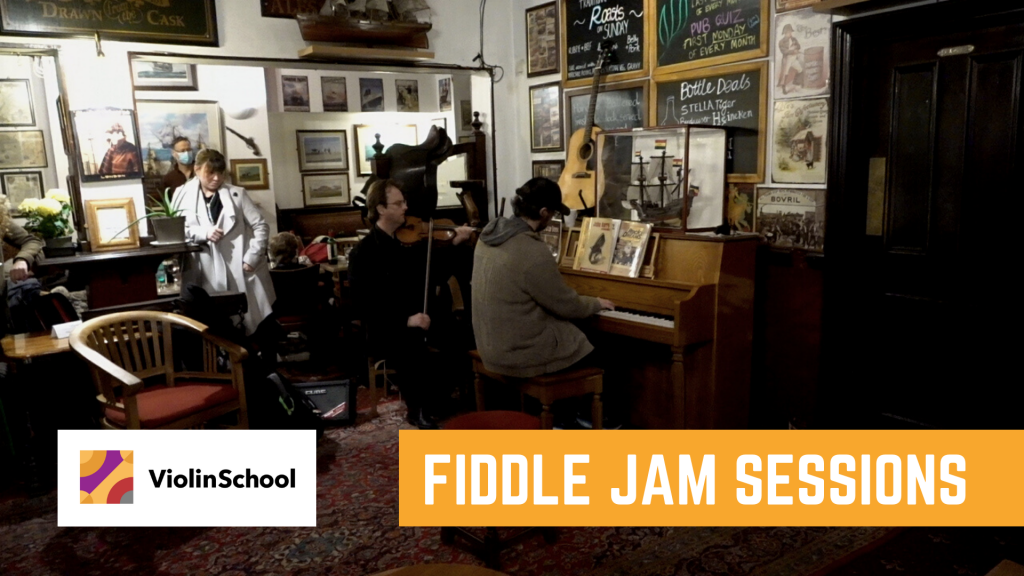
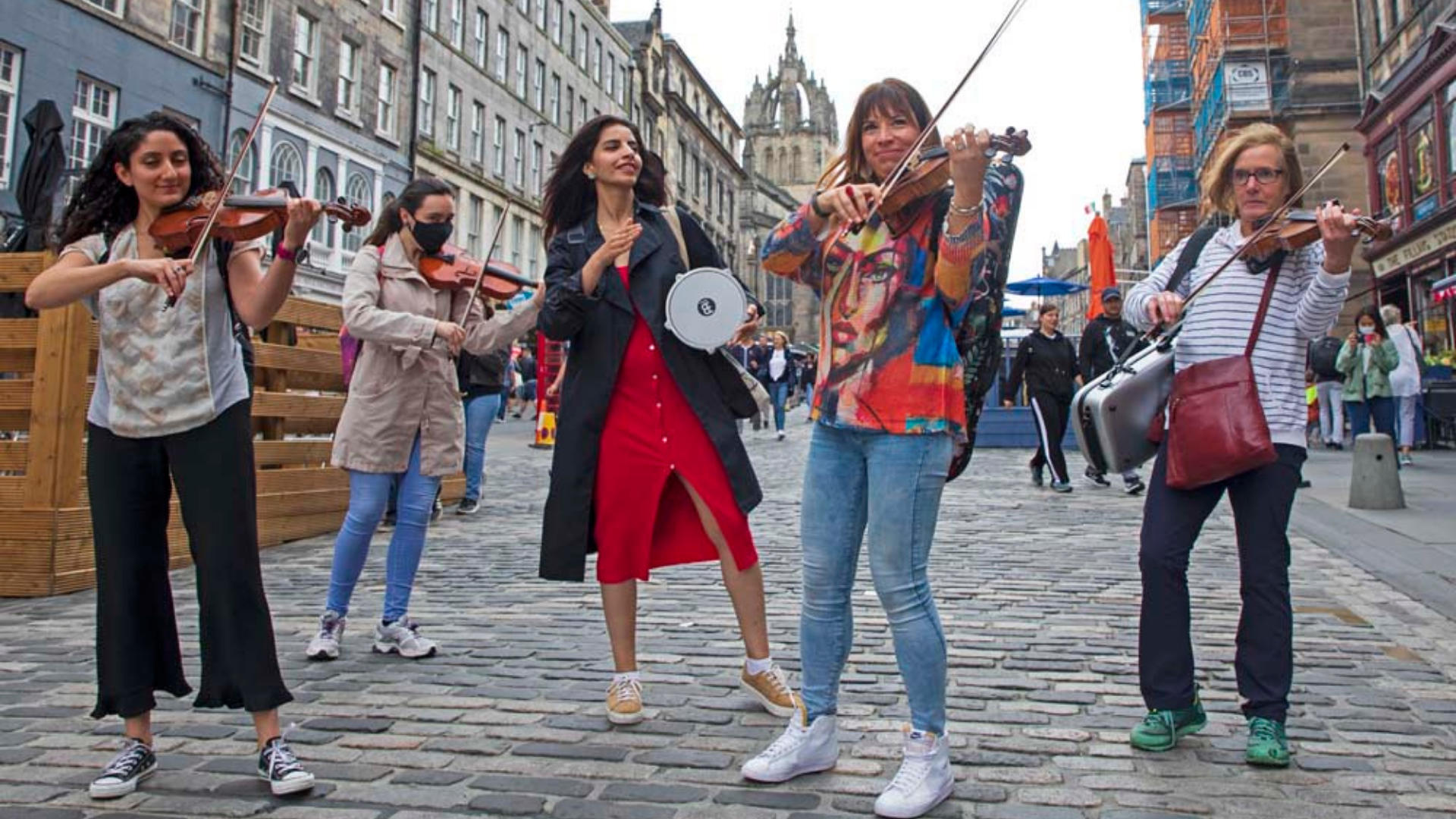 Violin Ensembles sessions run on Saturdays (relayed from London) and Thursdays (Zoom only), for players of Level (Grade) 5 and above.
Violin Ensembles sessions run on Saturdays (relayed from London) and Thursdays (Zoom only), for players of Level (Grade) 5 and above.
Each term, we learn and perform a wide range of music for violin, all of which is prepared, arranged or written exclusively for us by ex-London Symphony 1st violinist David Worswick.
Saturday Ensembles sessions are presented live from our London school, but you can take part from anywhere via live Zoom link.
At the end of each term, highlights of the Violin Ensembles repertoire is featured in a public concert.
Repertoire for Summer Term 2022 can be found here.
In addition to our regular Saturday sessions and Thursday Zoom practice sessions, we frequently work together on projects including music videos and other performance projects. Most Ensembles participants also play in the Violin Orchestra project, which happens twice a year.
The Violin Ensembles program is perfect for anyone who has already reached Grade/Level 5 or above, and is a wonderful opportunity to expand your performance and group playing experience in a friendly social setting, whilst expanding your repertoire and enjoying a wide range of music!
All you need is a ViolinSchool Term Pass (Remote / London) to take part. Find out more or register online here:
https://www.violinschool.com/termpass/
Here is a selection of recent videos ... the next one could include you, too!
The German pianist and composer, Carl Bohm, really knew how to write a good tune! This is a fine example of a Sarabande — a slow, stately dance with 3 beats in a bar.
Take a listen here:
This is the second of two pieces that will feature in Week 1 of this term's Ensembles sessions. The Ensembles take place as part of our 'ViolinHub', every Saturday during the 2021 Autumn (Fall) Term.
Build up your repertoire and your performance experience whilst having fun playing music with other violinists!
Join David Worswick and Simon Hewitt Jones of ViolinSchool for this term's program of wonderful new repertoire for intermediate and advanced players, every Saturday.
Find out more about ViolinHub here:
ViolinHub (live Zoom sessions)
Livestream & Music Video
The Violin Orchestra travelled to Edinburgh last week, to perform at the Edinburgh Fringe Festival on Saturday 7th August.
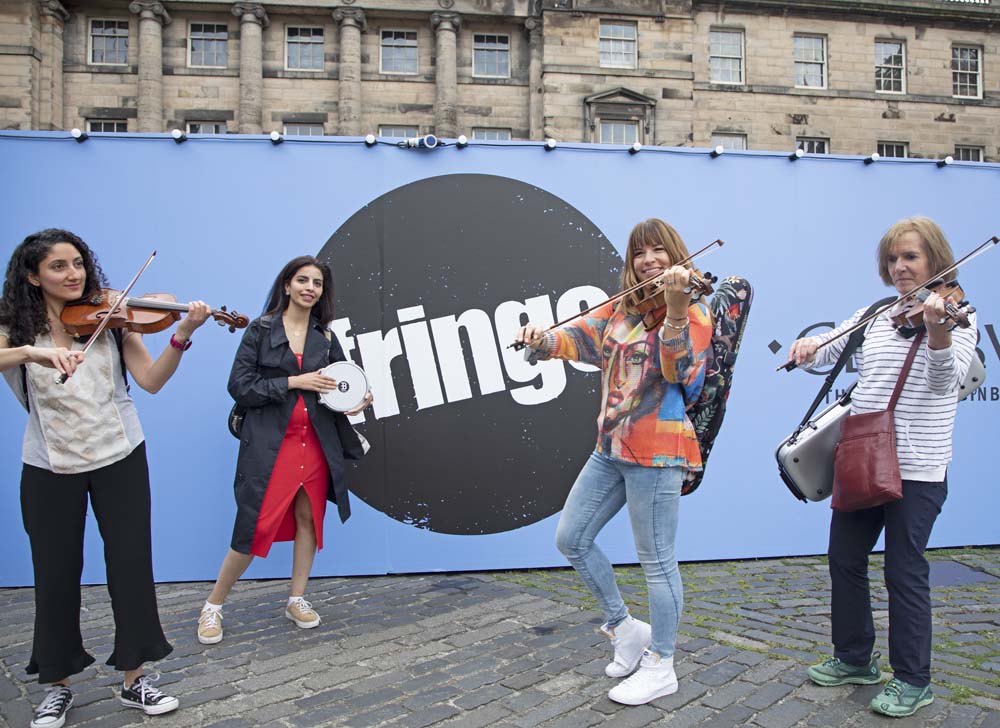
The Violin Orchestra is a unique orchestra for violinists of every age and level.
Because we use our own musical arrangements for each project, it’s possible for anyone to join in – whether you are a beginner violinist who has only been playing for a few weeks, or an advanced player with a lot of experience of playing in orchestras!
Just choose the part that’s the right level for you.
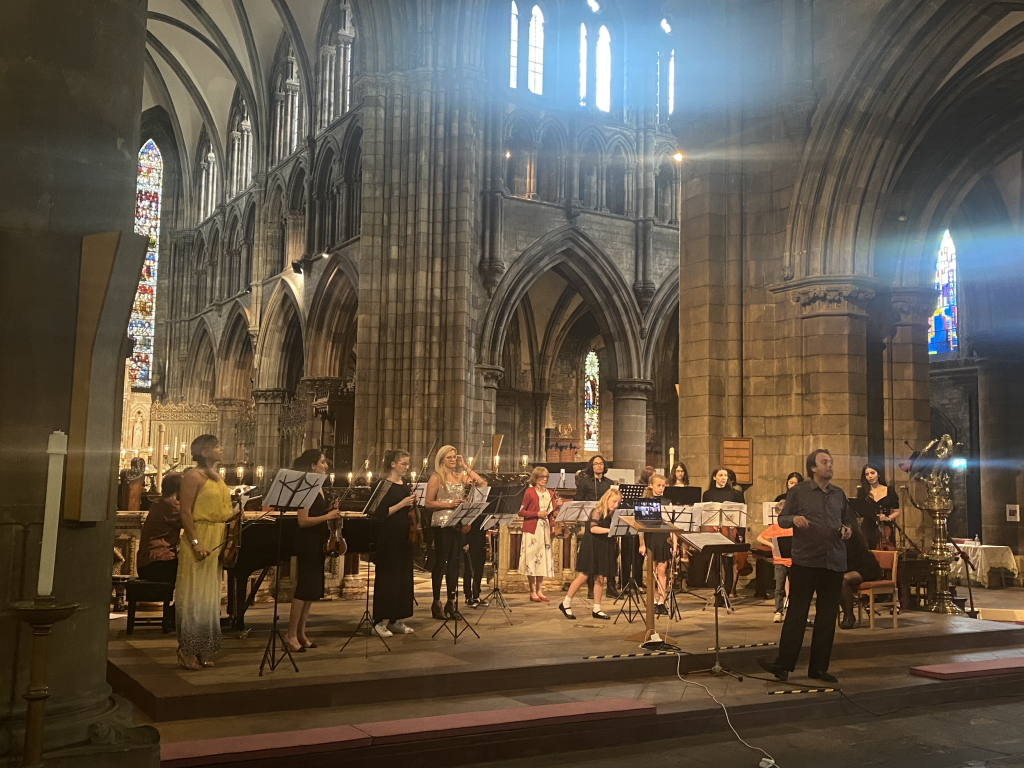
The Violin Orchestra concert was hosted by St Mary's Cathedral in Palmerston place, where the Orchestra repeated the program they had played in London a few weeks earlier:
The concert was livestreamed on YouTube, so it could be watched from anywhere in the world.
Several Violin Orchestra members who couldn’t travel to Edinburgh also joined in with the concert remotely, by connecting through a dedicated zoom link and appearing with the orchestra in real time.
The Edinburgh Fringe Festival is a unique event where, in non-pandemic times, performers of all types from all around the world descend on Edinburgh for three weeks of organized chaos! Creativity comes first ...
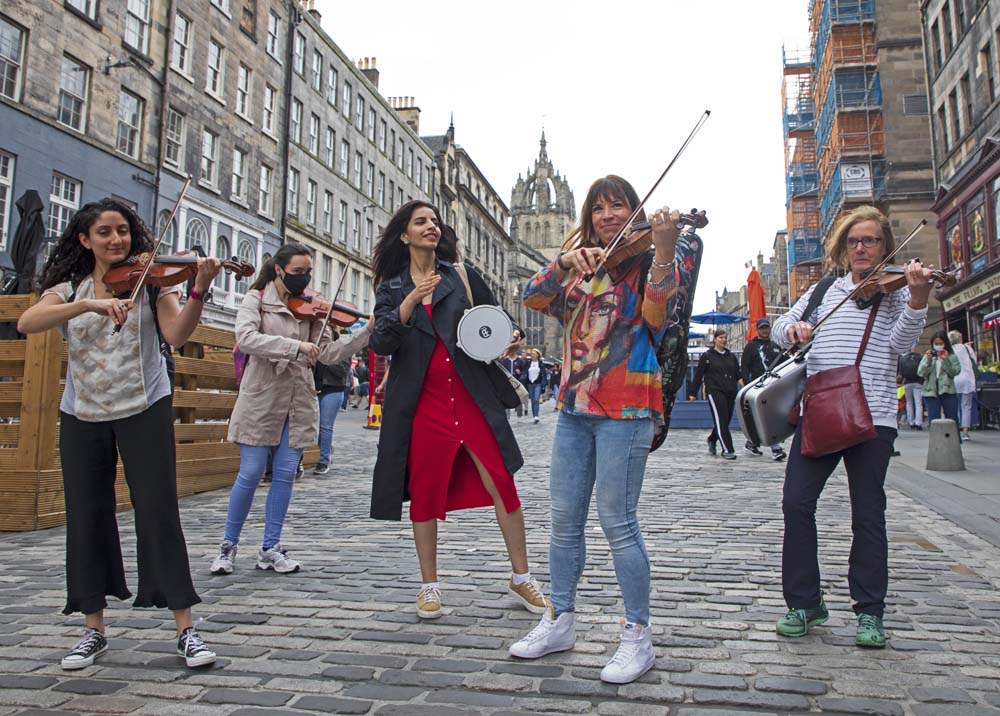
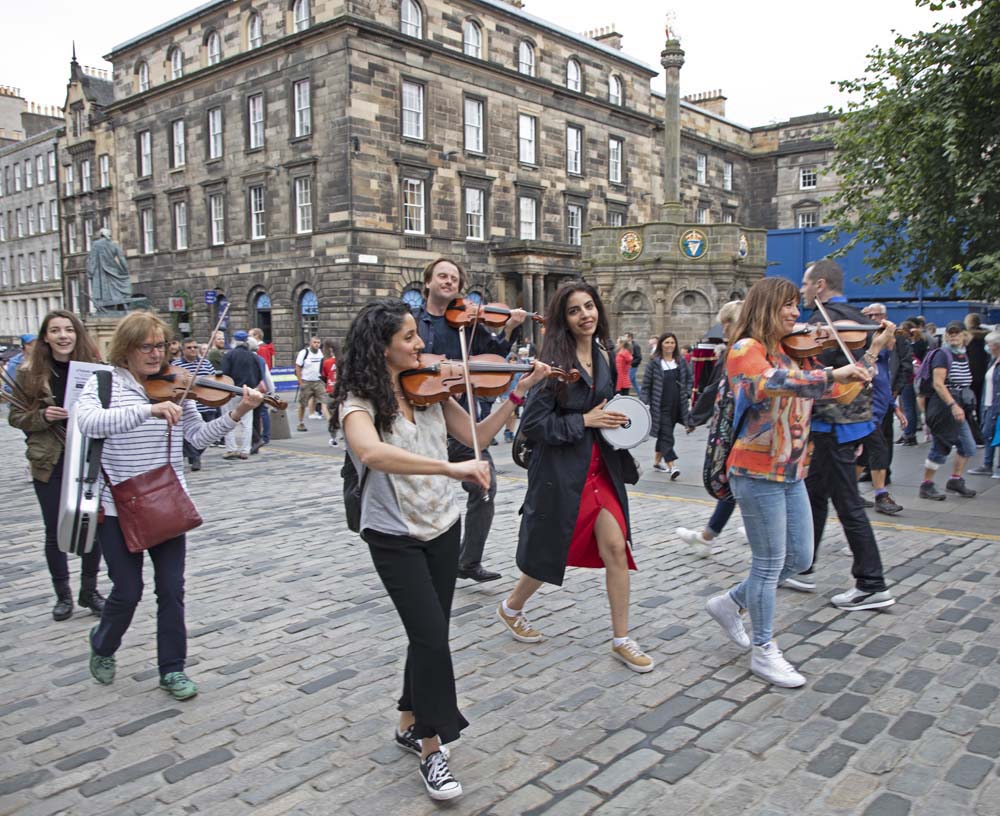
Groups traditionally promote their concerts on Edinburgh’s ‘Royal Mile’ (high street), which is where a group of violinists from the Violin Orchestra were spotted by Channel 4 News, for this segment about the festival:
Soon May the Wellerman Come
The following day, the orchestra traveled east from Edinburgh, along the Lothian coast, with coach driver extraordinaire (and theatre technician) Mark Fleming from Coach Hire Edinburgh.
“I brought my drone” were his first words as the orchestra boarded the bus… and indeed he had! We ended up with some extraordinary drone footage of the orchestra playing at locations including Leith, New Haven, and Musselburgh Harbour…
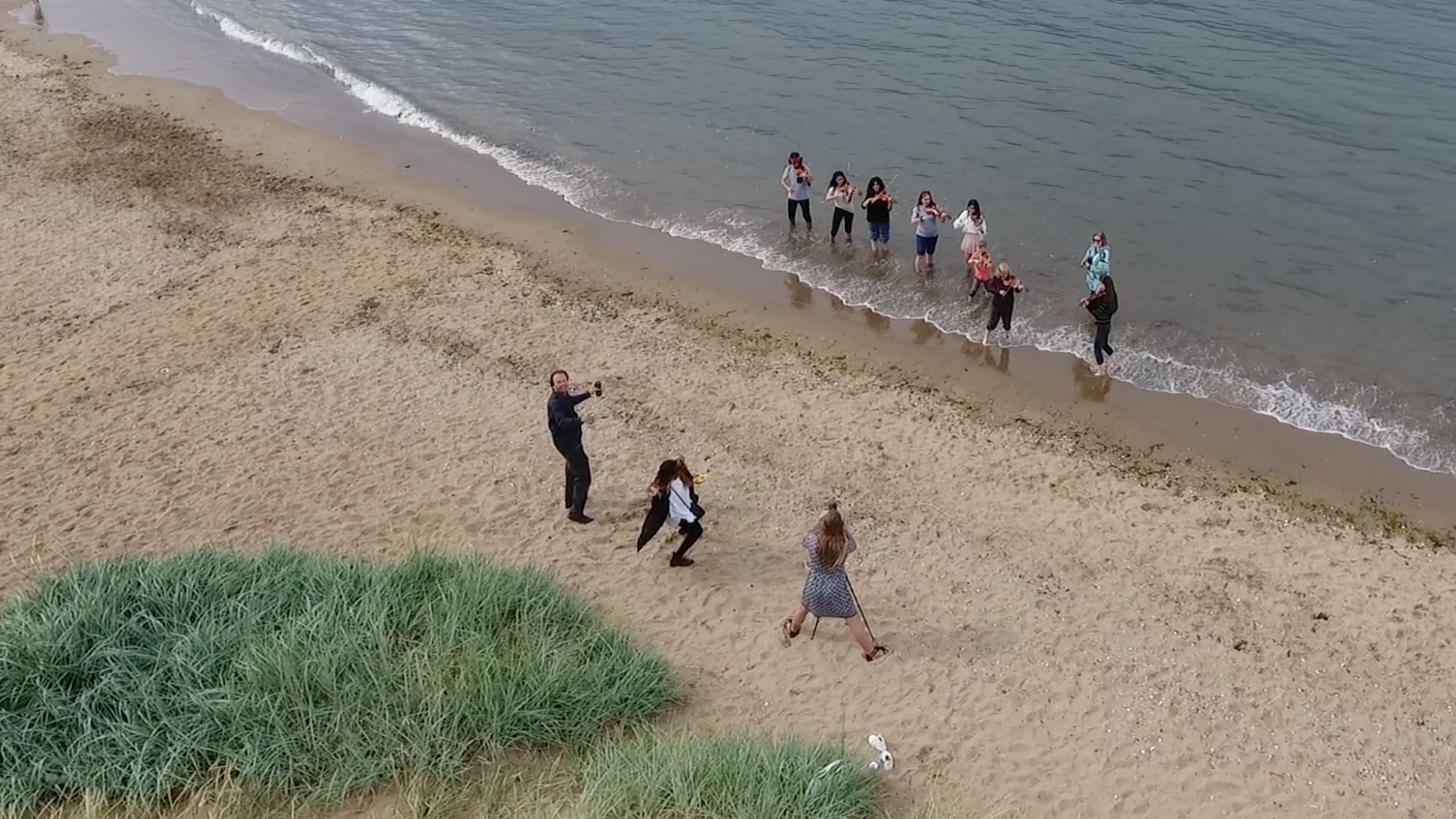
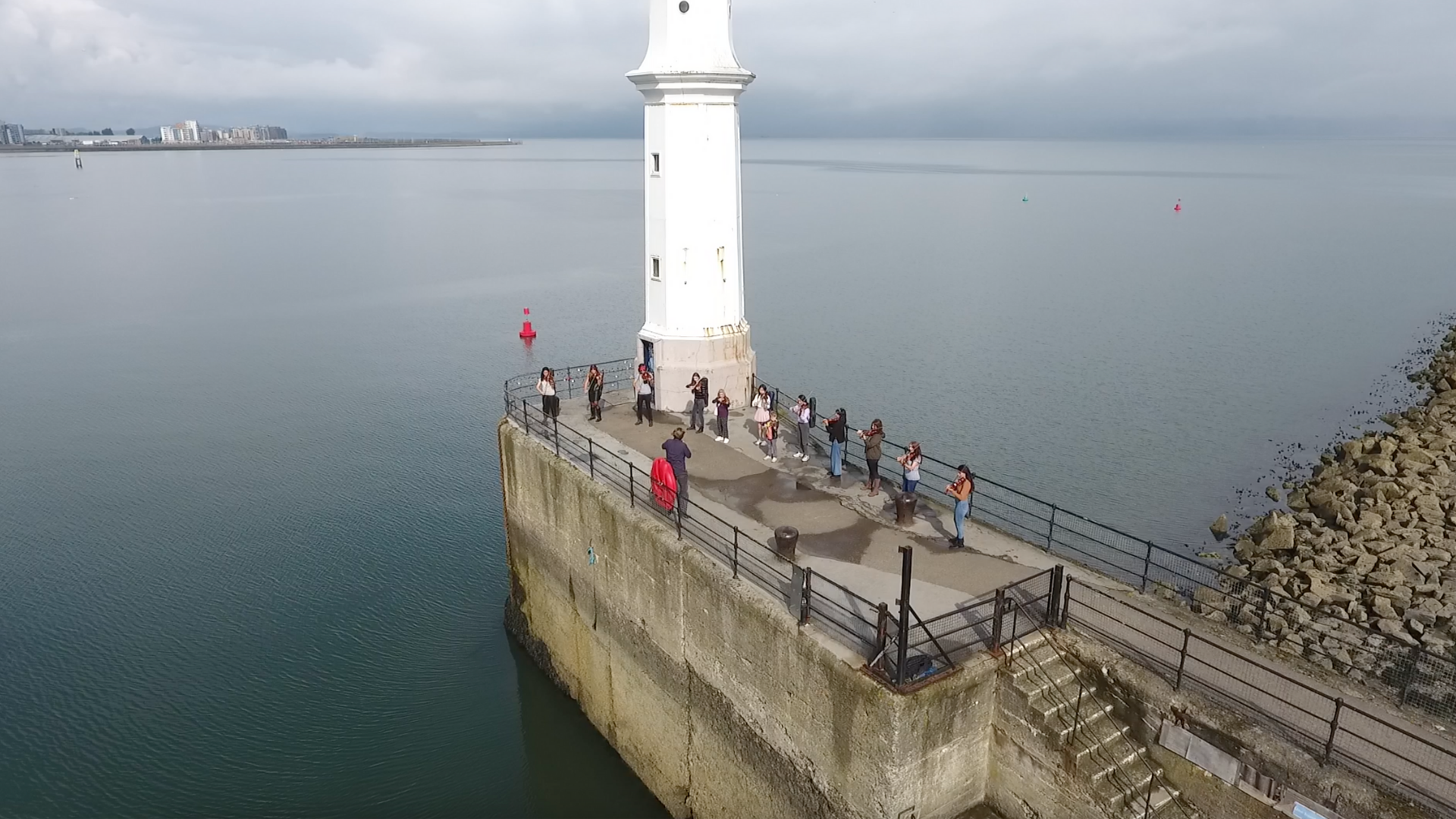
Wellerman is the latest in a series of music videos that the Violin Orchestra is creating for ViolinSchool‘s YouTube channel.
You can see our latest video, Abdelazer, and enjoy more videos from ViolinSchool and the Violin Orchestra here:
https://www.youtube.com/violinschool
We‘ll be putting together video highlights of the trip, so watch this space!
And if you’re in Edinburgh… Maybe see you in 2022?
Find out more about the Violin Orchestra and how you can join in and take part!
https://www.violinschool.com/violinorchestra/
Dear all,
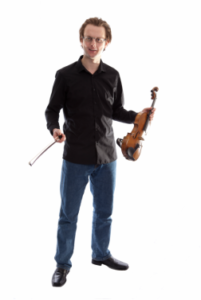
I am writing to update you about our plans for the London school during the Summer 2020 term.
Firstly, I hope this finds you safe and well. I'm painfully aware that, for a minority of our community, music is - right now - not at the forefront of our minds.
If that's you, please know that we're thinking of you, and we'll be here for you whenever you're ready to begin playing again.
For the rest of us, we need to prepare and be ready for when things get back to some kind of 'new normal', because in the coming months, people will need the solace, joy and excitement of music more than ever ...
... and getting ready for that is what Summer 2020 at ViolinSchool will be all about!
As with so many small organisations around the world in recent weeks, the months of March and April have not been kind to ViolinSchool.
But we're here for the long term. We've had to adapt rapidly to the changing situation, and I've taken the necessary decisions that will not only see us through the coming months, but continue to grow and thrive long after the current situation is over.
That said, we do need a couple more weeks to rebalance and catch up, so the start of our Summer Term is now delayed, and will start two weeks later than planned, in the week beginning 4th May.
We are now gradually working through our backlog and hope to be back to full speed by the end of April. We are immensely grateful for your support and patience.
Thank you.
Enrolment
If you are already enrolled --
If you are not yet enrolled --
Term Fees
We understand that your finances might be in an unusual place right now. We are also facing significantly increased costs, albeit offset against venue reductions. It is a very challenging time for many of us.
In order to help with tuition costs, we have been able to make the following adjustments:
We have always strongly believed that lack of financial resource should not be a barrier to learning music. If you need help with fees, please ask.
Although our resources are limited, we will always subsidise committed learners where we have capacity do so.
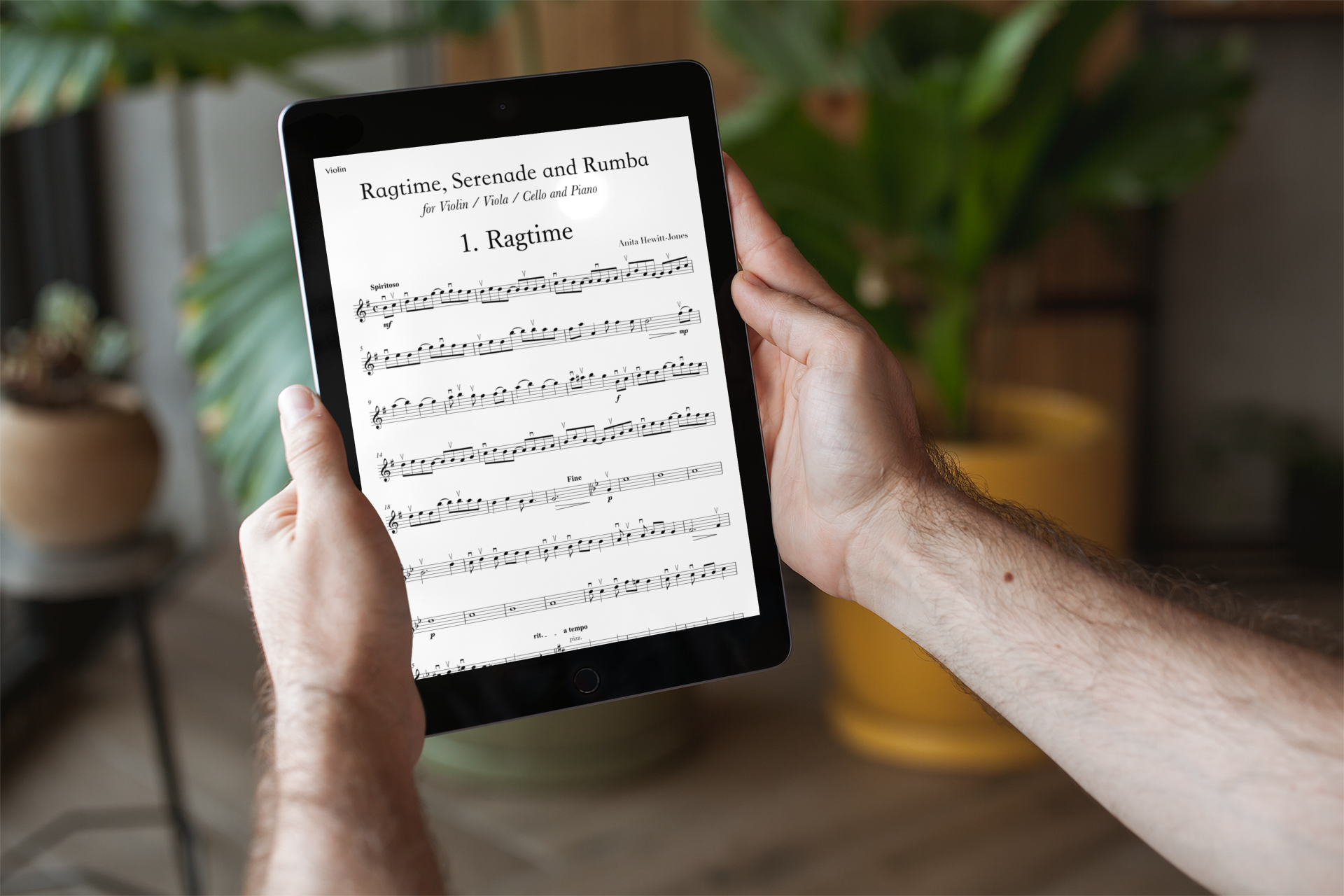 All of us at ViolinSchool are, as ever, completely focused on how to to provide you with the very best learning experience.
All of us at ViolinSchool are, as ever, completely focused on how to to provide you with the very best learning experience.
But a new reality requires a new approach, so instead of adapting our existing London program, we have reinvented it completely.
We will continue to monitor goverment advice, and still hope to re-introduce 'hybrid' online/offline classes in Pimlico during the second half of term, if it becomes safe to do so.
But we can't rely on this definitely happening. Therefore, Summer Term courses will be delivered through a mix of tuition formats:
Although this approach is new for many in our London community, we have been trialling it successfully for several years with our international learners, and I can highly recommend it.
In fact, I have been hoping for several years to bring hybrid digital- and offline- learning to all of our London community!
Why? Because, quite simply, I strongly believe that a blend of online and offline learning leads to the best results.
For this reason, I actually see this time as a very exciting opportunity to develop a new standard of learning for the violin.
1. Online Course Modules
For courses A to C, class materials will be available to you on ViolinSchool.com (for D and E / Ensembles, we will be sending music to you by email instead).
You will be able to download music and exercises, and look at basic instructions in advance of each class.
2. Live Zoom Classes
In each live session, we will go through the materials from the most recent module(s). We'll work through each exercise and activity in real time, and there'll be time to answer any questions that you may have.
3. Optional Short Followup Sessions (Skype or Zoom)
Should you need more help or support than is available in the group class, I and/or Marisol will be available for short 20-minute 121 followup sessions. We will be able to give personalised feedback or work in depth on a topic as needed.
Coaching times will be released weekly, but will usually include Tuesday and Wednesday evenings, and some weekday daytimes.
A couple of followup sessions and/or video exchanges will be included for each course participant. If you feel the need for more, further 121 coaching will available at a reduced rate.
4. Video Exchange
These are exactly the same as coaching sessions, but not in real time. If short coaching sessions are not possible for you due to scheduling, then you can simply upload a video performance for assessment and feedback.
(all times London/BST)
Thursdays (beginning 7th May):
6.30pm to 8pm - Adult Course A
8pm to 9.30pm - Adult Course B
Saturdays (beginning 9th May):
10.30am onwards - Parent & Child Courses
12.30pm to 2pm - Adult Course C
2.15pm to 3.45pm - Adult Course D/E
[May only] 4pm to 4.45pm - Ensembles
[June only] 4pm to 6pm Violin Orchestra Preparation
Preparation Week 1: Saturday 25th April
Preparation Week 2: Saturday 2nd May
Week 1: Thurs 7th & Sat 9th May
Week 2: Thurs 14th & Sat 16th May
Week 3: Thurs 21st & Sat 23rd May
Week 4: Thurs 28th & Sat 30th May
Week 5: Thurs 4th & Sat 6th June
(exceptionally, there will be no half term break)
Week 6: Thurs 11th & Sat 13th June
Week 7: Thurs 18th & Sat 20th June
Week 8: Thurs 25th & Sat 27th June
Revision Week: Saturday 4th July
Summer Concert: Saturday 11th July
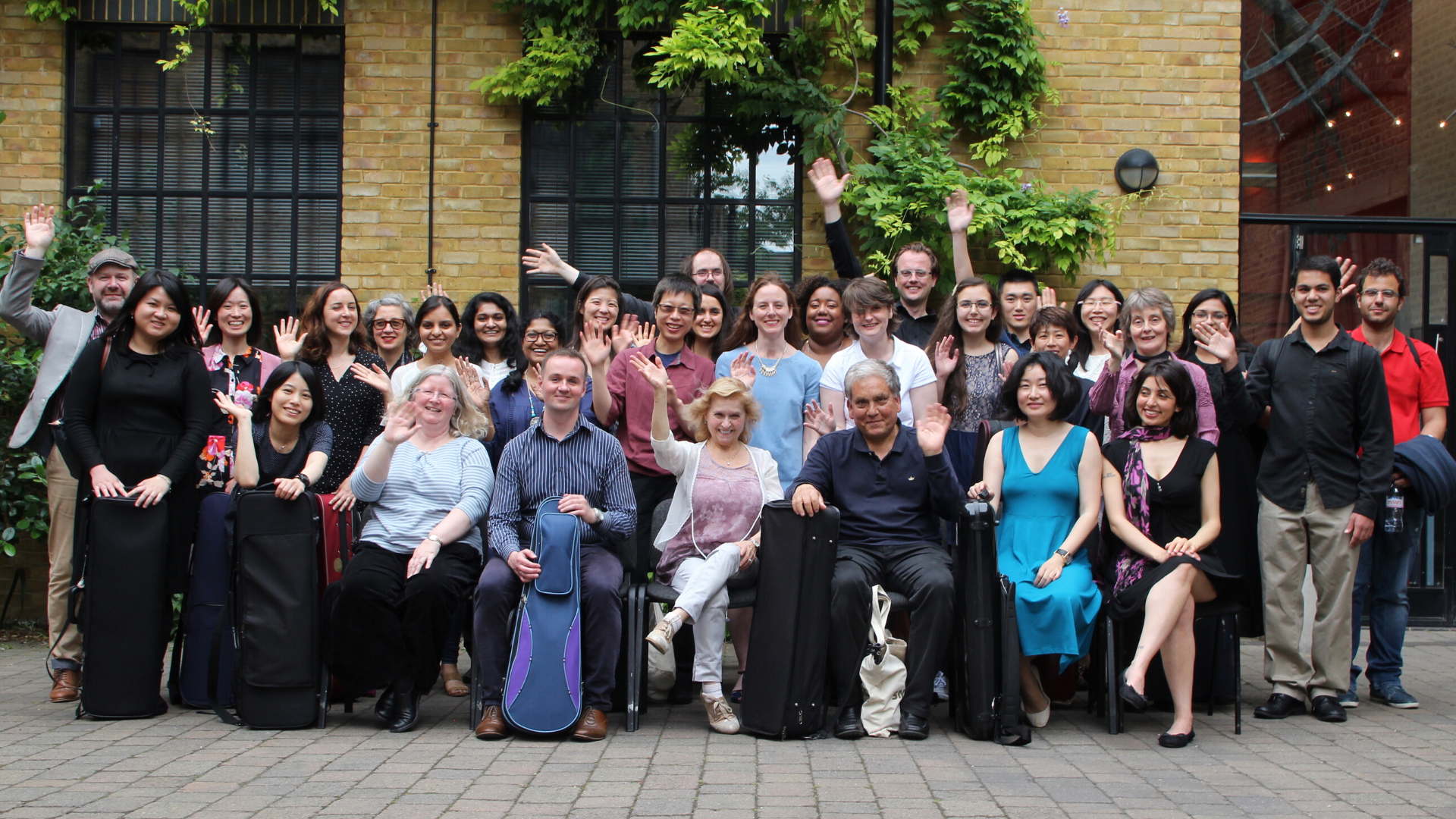
Rehearsals & Online Participation


Though our London school is incredibly important to us, it's actually not the main part of what we do. 'ViolinSchool' pre-dates ViolinSchool London; we originally launched in 2012 as an online school for the violin, but the idea was too ahead of its time.
No longer! As we move ahead into September 2020 and beyond, you can expect ViolinSchool to leverage the power of digital technology more than ever before. We're going back to our digital roots! Everything we do will be available digitally, not just physically.
I promise you this can be done in a really good way. Physical experiences such as concerts and printed books become even more important when digital resources are ubiquitous.
Digital formats don't replace physical formats. But each plays its role in enhancing learning, music-making, performing and listening experiences. More digital options don't detract from what's precious and unique about shared in-person events. If anything, the opposite is true.
In the next few days, you'll see our newest books and courses being released. Over the coming months, many more will follow. Our daily online lessons, weekly emails, and regular YouTube videos will restart next week.
So, please keep an eye on this blog, and look out for our emails 🙂
**
Thank you again for your support and commitment to learning during this remarkable time. Together we will get through it, and emerge stronger.
On behalf of everyone here, Happy Spring, and ... whether on-screen, or in person ... see you soon 🙂
Simon
Here are 10 really useful tips for getting the best results when recording your part for a virtual violin ensemble or orchestra...
Click the play button below to hear this feature, or download the MP3 to listen offline!
1) Record horizontally not vertically.
If you record vertically when you're holding your violin in playing position, then either the instrument will be cut off the screen because you're too close to the camera, or it won't be possible to crop your video to the right size because you'll be too far away, and the resolution won't be high enough.
So please, set up your device *horizontally* not vertically before you record!
2) Choose a Good Camera Angle.
A lot of people put their phone or tablet on a piece of furniture, and have it pointing up at them whilst they play. The problem with this is that all the viewer sees behind you is your ceiling!
So make sure that your camera is pointing directly at you. If you're recording with a computer, then the screen should be exactly vertical.
If you're using your phone to record but you don't have a tripod, then balance it so that it's almost vertical, or use something sticky to hold it in place whilst you record.
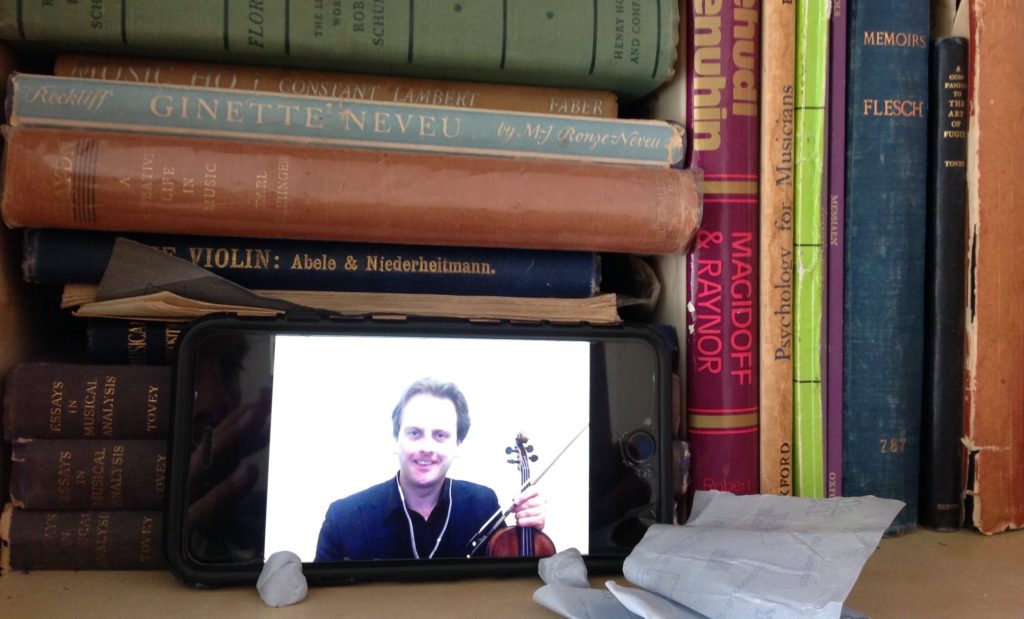
3) Place Your Camera at Eye Height
To get the right camera angle, you're also going to need your camera to be at eye height. If you're recording at home, try to find a shelf or a bookcase that's nearly as tall as you, and set up your device there.
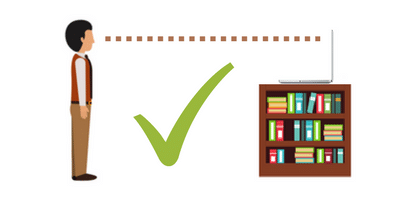
If you can't find a piece of furniture that's high enough, it might be better to record sitting down instead. Set up your phone or laptop on a table, and if you don't have a tripod, use some books or other heavy objects to balance your phone in place.
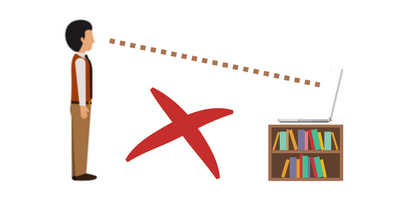
4) Light In Front, Not Behind
When it comes to basic lighting, there's only one thing you need to remember ... the strongest light should be IN FRONT of you ... not behind you!
Just make sure you're not filming yourself in front of an outside window or a bright light, and you should be OK.
If the sun is shining, then you should be facing the sunlight - don't record with the sun behind you!
5) Check The Dress Code
If there's a dress code for your virtual orchestra or ensemble, then make sure that you check it before you record! That's one thing that can't be fixed in the edit!
6) Check Your Background
Also check the background of your visual image before you hit the record button. A simple or plain background is fine, but if you're recording at home, it's always a good idea to check that laundry, unwashed dishes, the remains of yesterday's cake, or your child's toy monkeys aren't photobombing you without your permission...! Trust me, I know this to be true 😉
7) Use Earphones
You have to use earphones if you're recording a virtual ensemble part. This is because you'll always have to play at an exact tempo, so that the different parts can be stitched together by the editor.
You need to wear earphones so that you can listen to a reference track or a metronome beat whilst you play, without the sound being picked up by the microphone that's recording you!
This is exactly how string musicians work in a studio recording session. On the right ear, each player wears a single-ear headphone, which is like a headset *without* a microphone.
The metronome beat, known as the 'click track', is pumped through the right earpiece. But the left ear remains clear, so you can keep listening to what you're playing, without distraction.
You might like to try this with your own earphones, to find out what works best for you.
Always check the BPM, or 'beats per minute', that's been agreed for the piece you're recording. This tells you the tempo you'll need to play at. Set your metronome to this tempo.
8) Hide Your Earphones
Wired earphones can look messy on camera, so *hide* them if you can. Try running the cable behind your shoulder and down your back, or inside your clothing.
9) Angle Your Violin Towards The Camera
Your performance may be pre-recorded, but it's still a performance. So the *angle* of the violin is important - make sure that you're facing the camera just as you'd face an audience from a concert stage ... rotate your body very slightly to your left, so that your violin is facing directly towards the camera.
Don't rotate too far to your right, otherwise all the viewers will see is the scroll of your violin.
10) 'Perform' the Beginnings and Endings Too!
As with a live performance, the beginnings and endings of your recording are really important.
Be in playing position, ready to start, at least a couple of beats before you play the first note. And at the end, hold your position for a moment or two, before you bring your violin down.
This will give your editor time to fade the visuals in or out, and make sure that your performance matches up visually with the rest of the group. Don't forget to smile!
P.S. ... Name Your Files!
Here's a bonus 11th tip for you that will take you no more than a few seconds, but will save your editor a LOT of time! ... make sure to name your video files correctly!
We recommend putting your first name then surname, then the name of your ensemble or project, then the name of the piece, like this:
Simon Jones - Course A July 2030 - Twinkle Twinkle Little Star.mp4
It's a small thing to do, but it makes it *much* easier to organise at the production end! And most importantly, it reduces the chance of your recording getting lost, or not making it into the final cut of the video.
These tips might individually seem like small things. But together, they make a massive difference to the level of production quality that your ensemble can achieve.
Try to remember them, and lift your video to the next level. Good luck with your recording!
Last week, ViolinSchool's Caroline Lumsden sent out a call for performances of Bring Me Sunshine - read the full story here! Here's the final video:
The video will also be broadcast in the UK on The One Show (BBC1), tonight (3rd April) after 7pm!
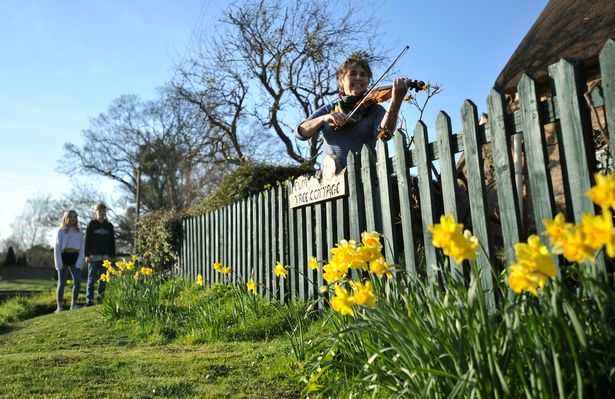
ViolinSchool's Caroline Lumsden is gathering a 'Virtual Orchestra' today, to perform Bring Me Sunshine for British TV (broadcast date to be confirmed - likely to be in the next 48 hours). You can be part of it!
It all started when Caroline recorded a video message for her husband Alan, who because of the UK lockdown, is isolated in a nearby nursing home.
Read the news articles here:
As well as performances from her family, Caroline would like to include learners from the schools she works for, including Gloucestershire Academy of Music, ViolinSchool, and Musicland Oxford.
If you'd like to take part, record a video of yourself SINGING or PLAYING one of the parts below, and send it to us as soon as you can!
Email your video to [email protected] or if it's a big file, send it via Wetransfer to the same address. Please remember to put 'Bring me Sunshine!' in the subject line, so that we do't miss your message!
RECORDING TRACK [RECORD WITH THIS!!!]:
This track is for RECORDING the video! Listen to this on earphones as you record yourself! Click here to download it! **This track is updated as the project evolves - v10 is below**
PRACTICE TRACK [PRACTISE WITH THIS!!!]:
This track is for PRACTISING the video! Listen to this on earphones as you record yourself! Click here to download it!
DOWNLOAD SCORE/PARTS HERE! (There is a download link under each part)
Music arrangements by Thomas Hewitt Jones
Score:
[pdf-embedder url="https://www.violinschool.com/wp-content/uploads/2020/03/Bring-me-Sunshine-string-parts-FINAL-Full-Score.pdf" title="Bring me Sunshine string parts FINAL - Full Score"] Click here to download it!Score & Parts (1 PDF):
[pdf-embedder url="https://www.violinschool.com/wp-content/uploads/2020/03/Bring-me-Sunshine-string-parts-FINAL-Score-and-parts.pdf" title="Bring me Sunshine string parts FINAL - Score and parts"] Click here to download it!Vocals:
[pdf-embedder url="https://www.violinschool.com/wp-content/uploads/2020/03/Bring-me-Sunshine-string-parts-FINAL-Voices.pdf" title="Bring me Sunshine string parts FINAL - Voices"] Click here to download it!Violin Parts:
Part 1:
[pdf-embedder url="https://www.violinschool.com/wp-content/uploads/2020/03/Bring-me-Sunshine-string-parts-FINAL-Violin-1.pdf" title="Bring me Sunshine string parts FINAL - Violin 1"] Click here to download it!Part 2:
[pdf-embedder url="https://www.violinschool.com/wp-content/uploads/2020/03/Bring-me-Sunshine-string-parts-FINAL-Violin-2.pdf" title="Bring me Sunshine string parts FINAL - Violin 2"] Click here to download it!Part 3:
[pdf-embedder url="https://www.violinschool.com/wp-content/uploads/2020/03/Bring-me-Sunshine-string-parts-FINAL-Violin-3.pdf" title="Bring me Sunshine string parts FINAL - Violin 3"] Click here to download it!Part 4:
[pdf-embedder url="https://www.violinschool.com/wp-content/uploads/2020/03/Bring-me-Sunshine-string-parts-FINAL-Violin-4.pdf" title="Bring me Sunshine string parts FINAL - Violin 4"] Click here to download it!For Beginner Violinists:
Part 5:
Part 6:
[pdf-embedder url="https://www.violinschool.com/wp-content/uploads/2020/03/Bring-me-Sunshine-string-parts-FINAL-Violin-6-easy.pdf" title="Bring me Sunshine string parts FINAL - Violin 6 (easy)"] Click here to download it!Cello Parts:
Part 1:
[pdf-embedder url="https://www.violinschool.com/wp-content/uploads/2020/03/Bring-me-Sunshine-string-parts-FINAL-Violoncello-1.pdf" title="Bring me Sunshine string parts FINAL - Violoncello 1"] Click here to download it!Part 2:
[pdf-embedder url="https://www.violinschool.com/wp-content/uploads/2020/03/Bring-me-Sunshine-string-parts-FINAL-Violoncello-2.pdf" title="Bring me Sunshine string parts FINAL - Violoncello 2"] Click here to download it!Part 3:
[pdf-embedder url="https://www.violinschool.com/wp-content/uploads/2020/03/Bring-me-Sunshine-string-parts-FINAL-Violoncello-3.pdf" title="Bring me Sunshine string parts FINAL - Violoncello 3"] Click here to download it!Part 4:
[pdf-embedder url="https://www.violinschool.com/wp-content/uploads/2020/03/Bring-me-Sunshine-string-parts-FINAL-Violoncello-4.pdf" title="Bring me Sunshine string parts FINAL - Violoncello 4"] Click here to download it!Having a good structure to your violin practice, as described in the Practice Menu, is important. But it isn't everything... you also need to be able to use time efficiently within your practice time.
That means knowing what to do... which types of exercises will be helpful, and which kinds of activities will guarantee you results?
It's a big topic, but a great place to start is with some of the most useful and effective practice techniques that have been proven time and again by violinists over many years.
Here's a useful checklist of some of the most popular techniques...
Download it from the ViolinSchool Library
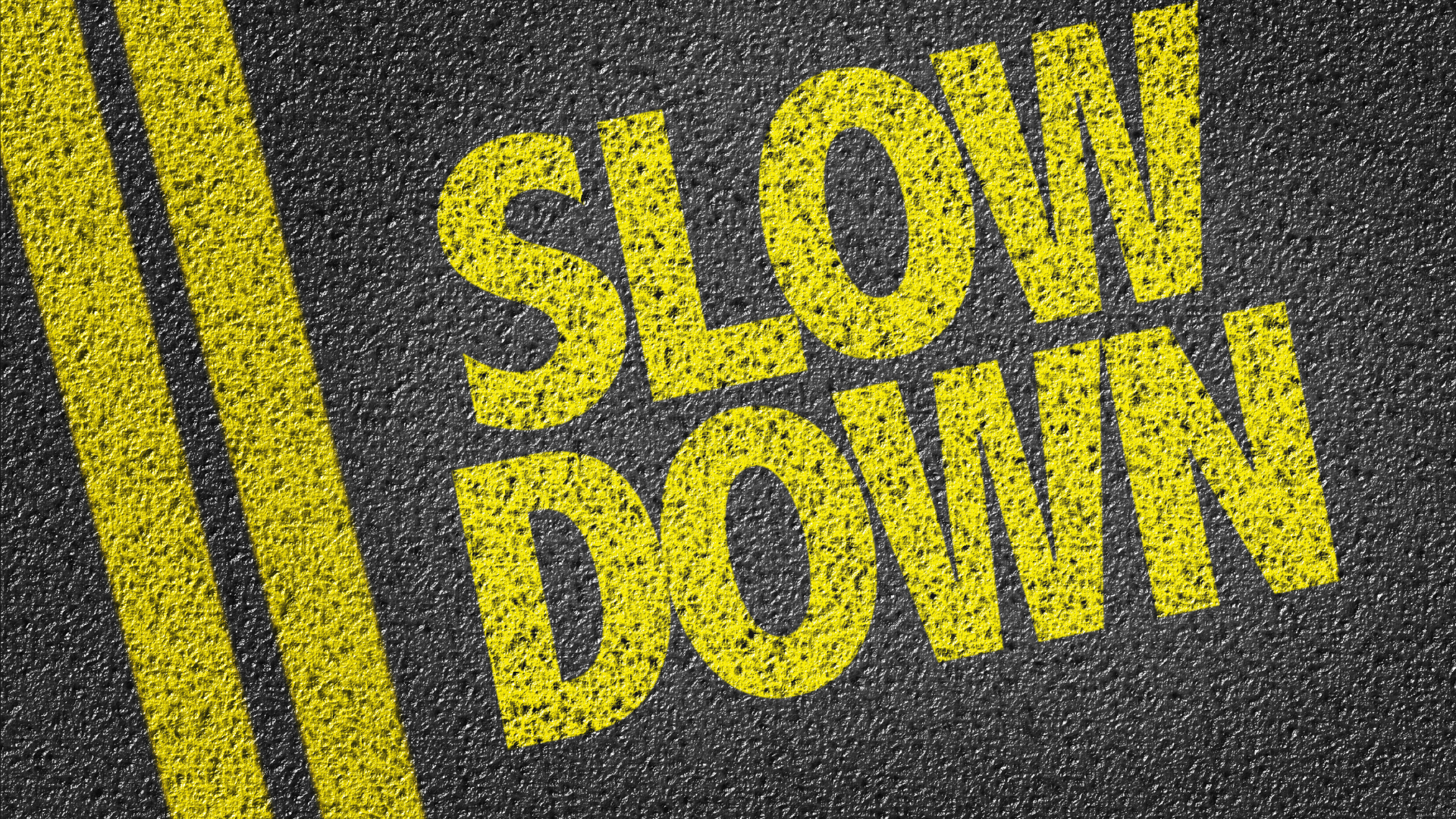
It seems obvious, doesn't it? If you play something underspeed, you have more time to think ahead and get it right. But slow practice gives you sooo much more than just more time. You'll also benefit from...
Accurate Repetition - The more you repeat something, the more it 'grooves' itself into your muscle memory. So obviously, it's better to groove those memories in accurately! And you're most likely to achieve a high level of accuracy when practising new motions, if you're playing them slowly!
Speed of Acquisition - When you're playing slowly, you've got more time to think about the detail of what you're doing. You can use this time to create a comprehensive visual image of how you are playing, in your imagination. This helps you to get the action more quickly into your subconscious memory than if you were playing it fast. So weirdly, slow practice = fast learning!
Proportion - Try approaching slow practice as if you are playing in 'slow motion'. What you're doing is just a slowed-down version of what you'd be doing at full speed. This is actually quite challenging to do, because you become aware of the subtlety of each element of your movements. But it really makes you think about how to improve your playing. Does your body balance? Are all your movements in good proportion to one another? Is each motion as efficient and smooth as it could be?
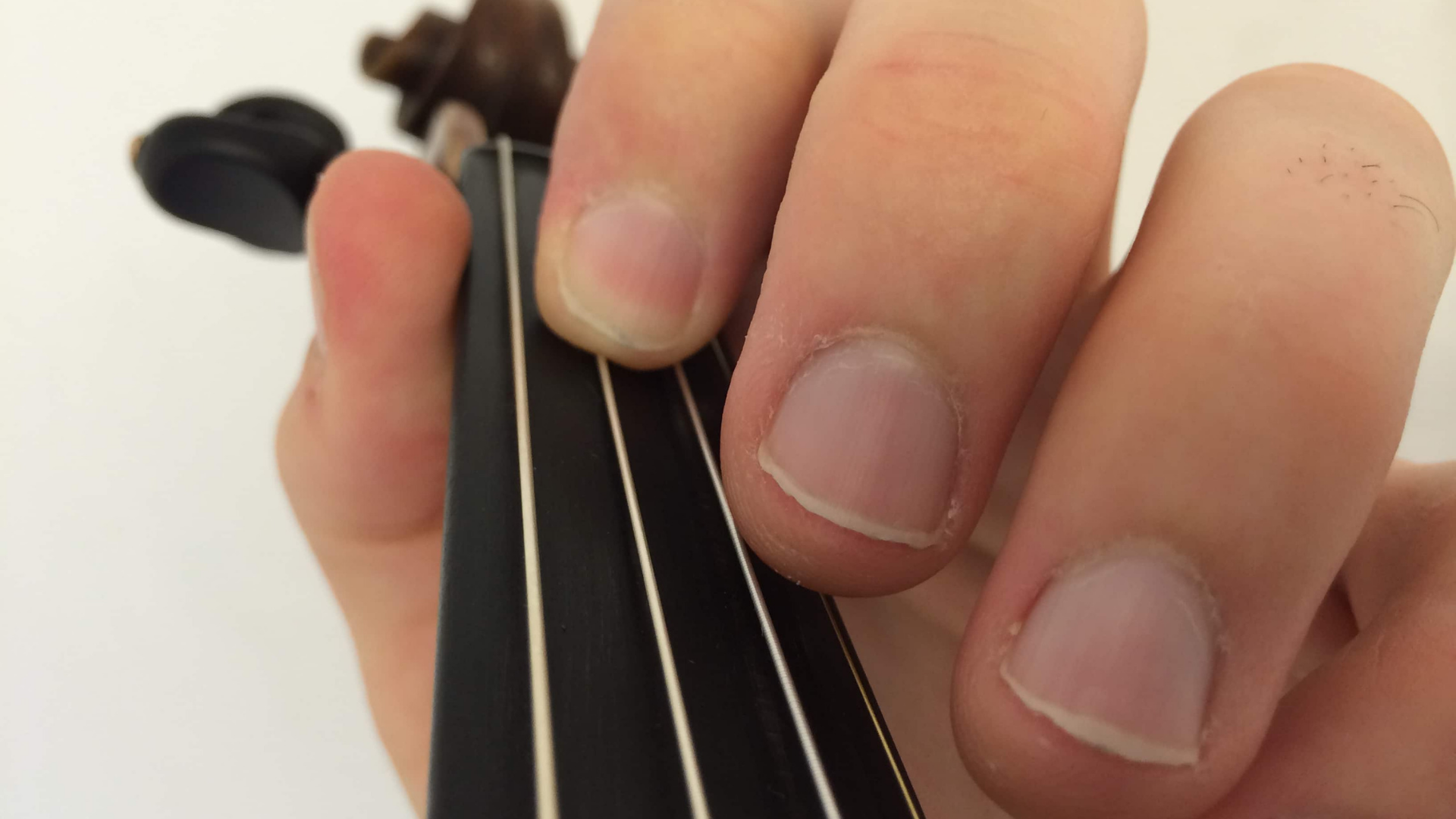
When we perform music on the violin, or play through pieces at speed, we have to rely a lot on the 'automatic' skills that we've built up during training. That's fine if you already know a piece of music well.
But if you're learning something for the first time, then it simply doesn't work to jump straight into playing things through. The detail of your muscle memory just isn't strong enough, and you'll become overwhelmed.
That's why it's important to break things down and isolate them... it allows us to focus on solving one issue at a time. Once that's done, we can carefully and slowly take the time to internalise each movement, until it's well 'grooved' into our muscle memory.
The same thing works for fixing problems in your violin practice. You need time and energy to focus on solving individual issues, one at a time, without distractions. Once you've fixed a passage of music at a slow speed, then you can test it at a higher speed!
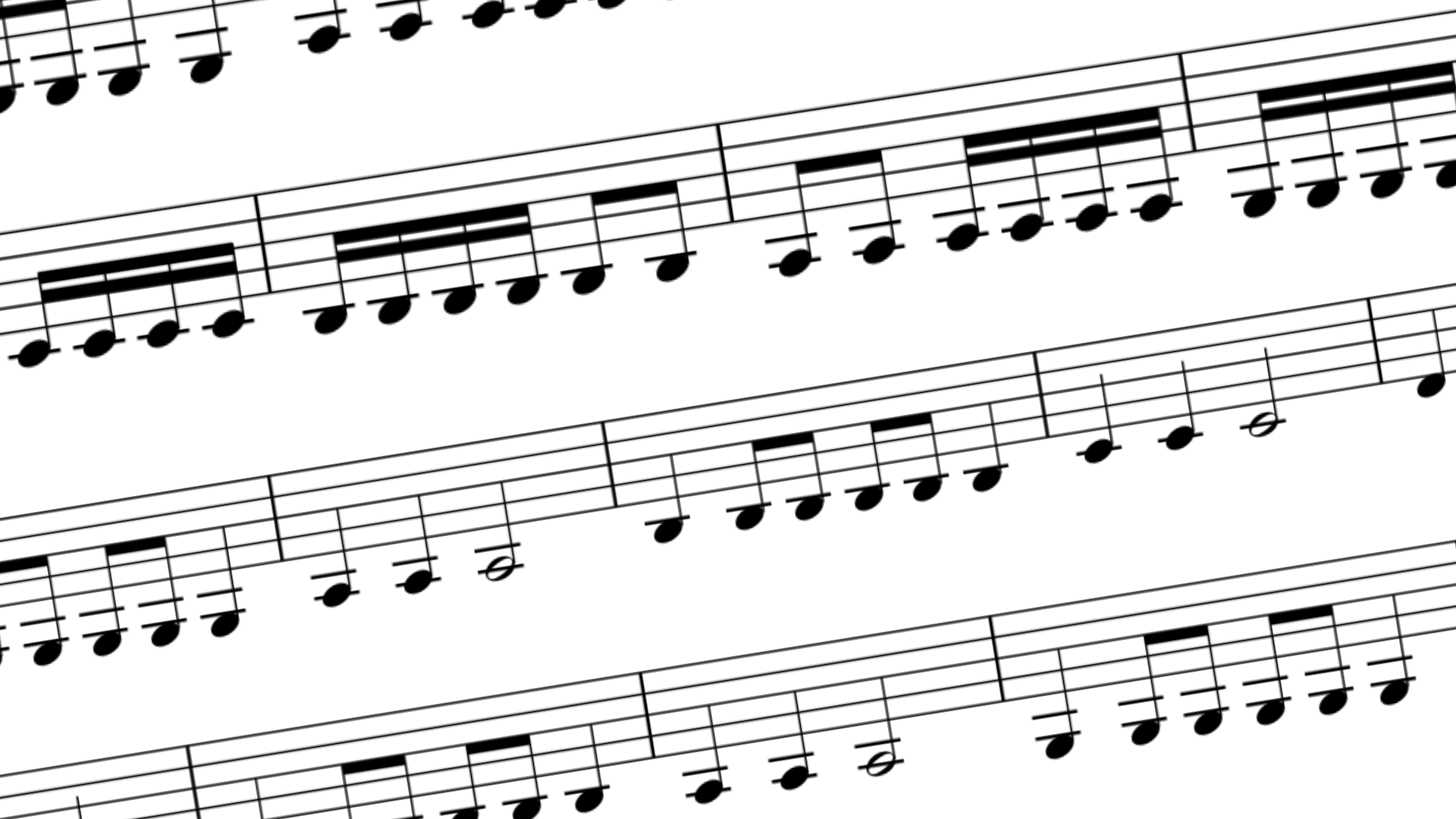
Once we have a solution to a problem, or we've learnt how a complex techinque works, we need to make our physical memory as strong as possible. Then we can recall each set of movements effectively and efficiently in performance - without needing to consciously think about it!
To do this, a different kind of 'breaking down' becomes useful... instead of simplifying a task by reducing complexity, we need to increase the complexity of the movements, in order to test and expand the limits of what we can do.
Adding complexity to a task places stronger and stronger demands on our technical capability and mental capacity. This forces us to depend more and more on our subconscious memory (i.e. our training). If we can monitor this effectively, then it's possible to predict accurately the level to which we can perform under pressure - which is a great way of reducing stress and performance anxiety!
Two of the most important ways of building up these skills are by varying the rhythm and bowing patterns that you use during practice. For example, you might be able to play a simple 2 or 3 octave scale using, for example, quarter notes on separate bows.
But try the same scale with dotted rhythms, changing the bow every three notes, and you'll have a MUCH harder challenge to complete!
Of course, it's sensible not to jump too far ahead of your current capability. So try to introduce rhythm and bowing variations that are only just outside of your comfort zone... challenging, but still doable!
As you introduce more rhythm and bowing changes, you'll find that you can cope with increasing amounts of complexity whilst playing, and the underlying tasks will become easier (such as, in this example, the original 2 or 3 octave scale).
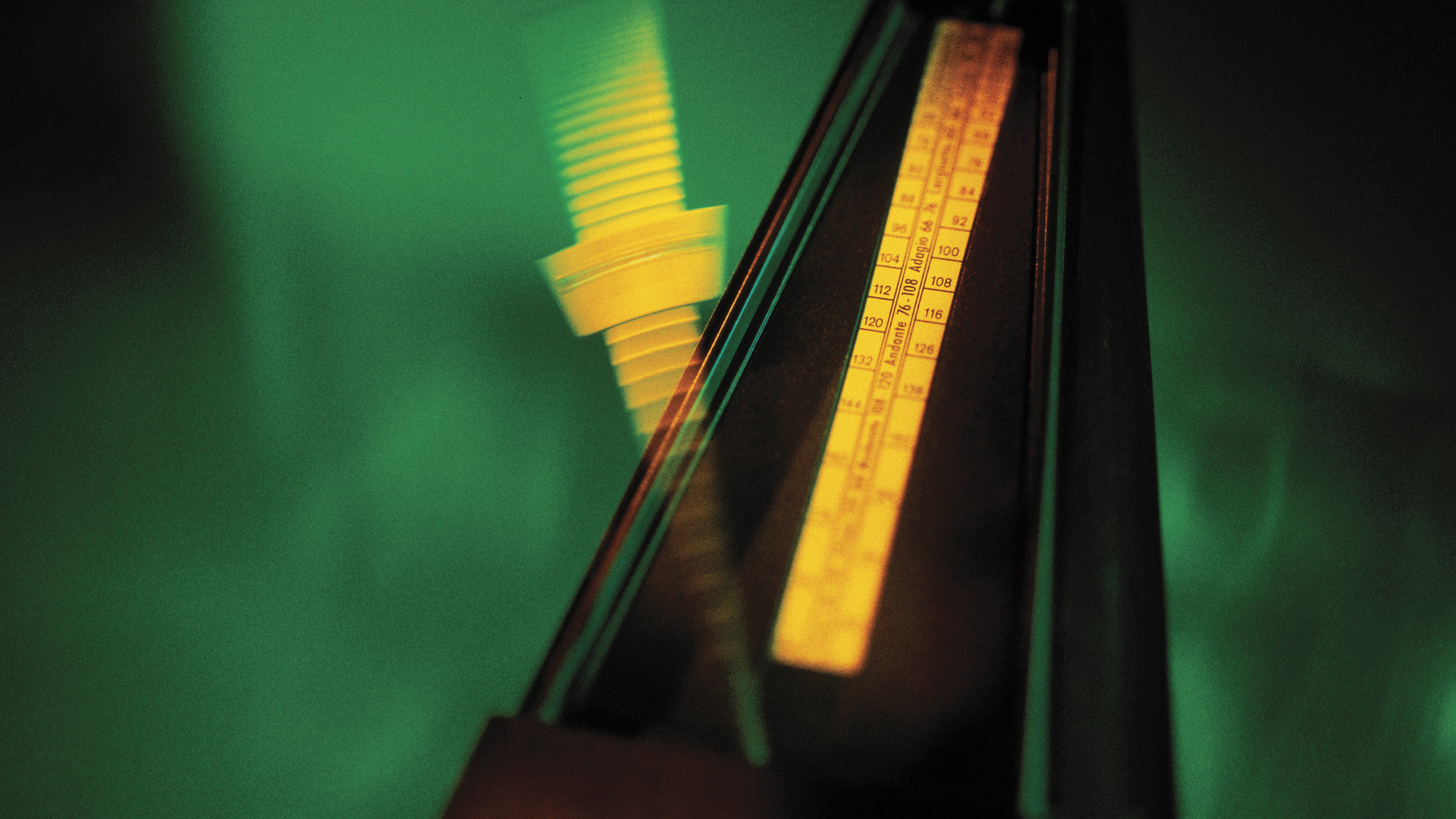
Timing is one of the most important aspects of music. And for music to make sense, the pitches we play have to be proportionate to each other!
Yes, that means you have to play the right rhythms. But those rhythms have to be right in proportion to the pulse of the music.
Our perception of time can become warped when we're concentrating on other things. So next time you face a challenging technical problem, try switching on a metronome. Keep listening to the metronome as you play, and you'll hear immediately if your timing becomes uneven.
Using a tool like a metronome means you have one thing to think about as you play. It frees up your brain to focus on whatever technical issue you're working on!
Better still, by premptively using the metronome to stop you from veering off-tempo, you avoid grooving in any timing errors whilst you're practising!
But, a warning... don't become addicted to the metronome! (Or to the tuner or mirror - see below). If you depend too much on the visual memory, it can cause other problems. But it's easily avoided... read Are You A Metronome Addict? to find out how!
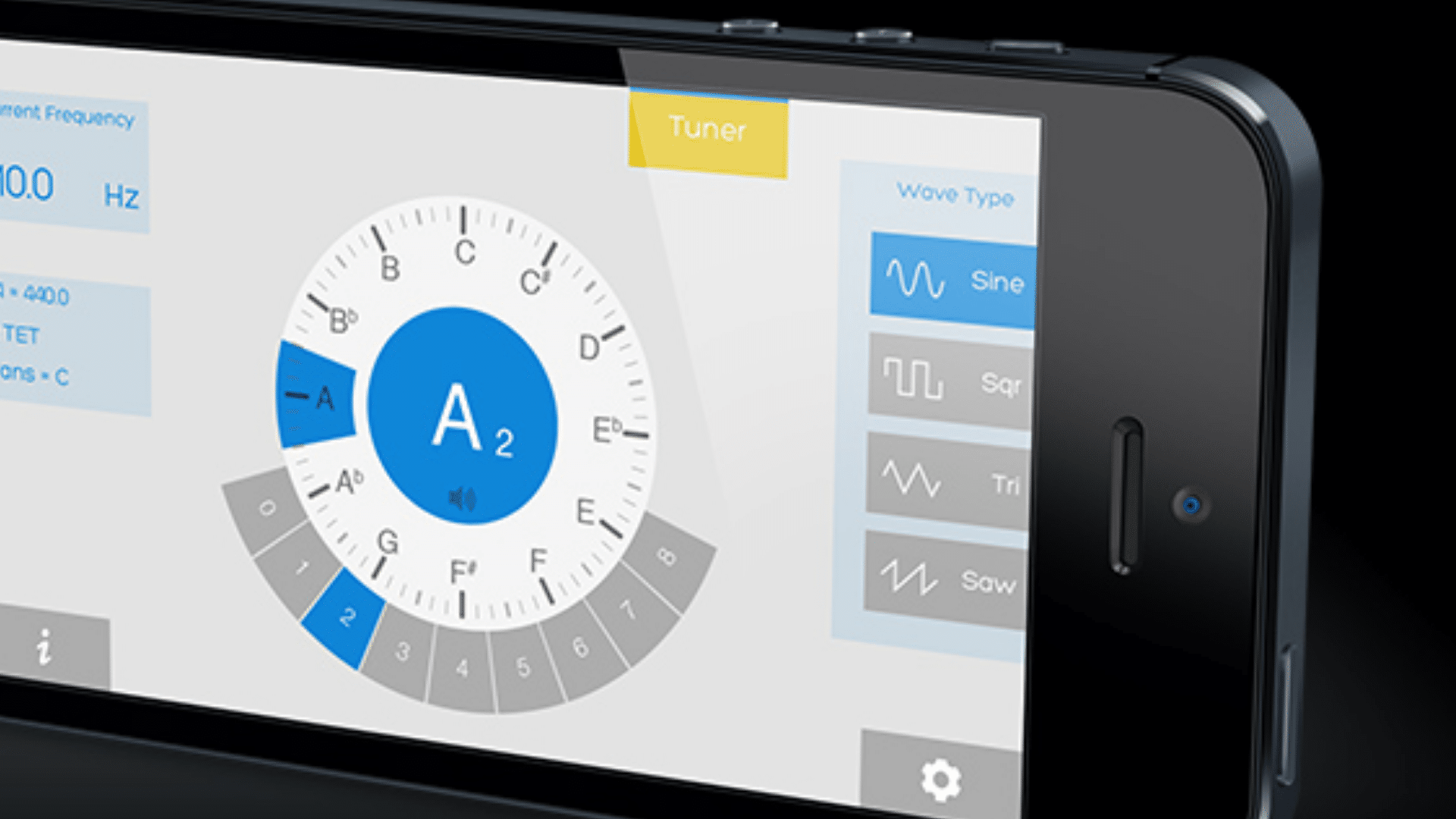
As with timing, it can be really helpful to have independent, objective feedback on your pitch as you practise. A tuning app will give you a visual read-out, which will show whether you are playing in tune or not.
It's best to use a tuner for testing, checking and correcting your playing... rather than just following along with the the visual cues!
Most 'intonation practice' (i.e. practising your finger placement, and tuning the notes correctly) benefits from slow practice, because when you are bowing with clear, full, slow bow strokes, then it is much easier to create a big, beautiful and resonant sound.
And that's the kind of sound you need to hear, in order to make good solid decisions about your intonation!
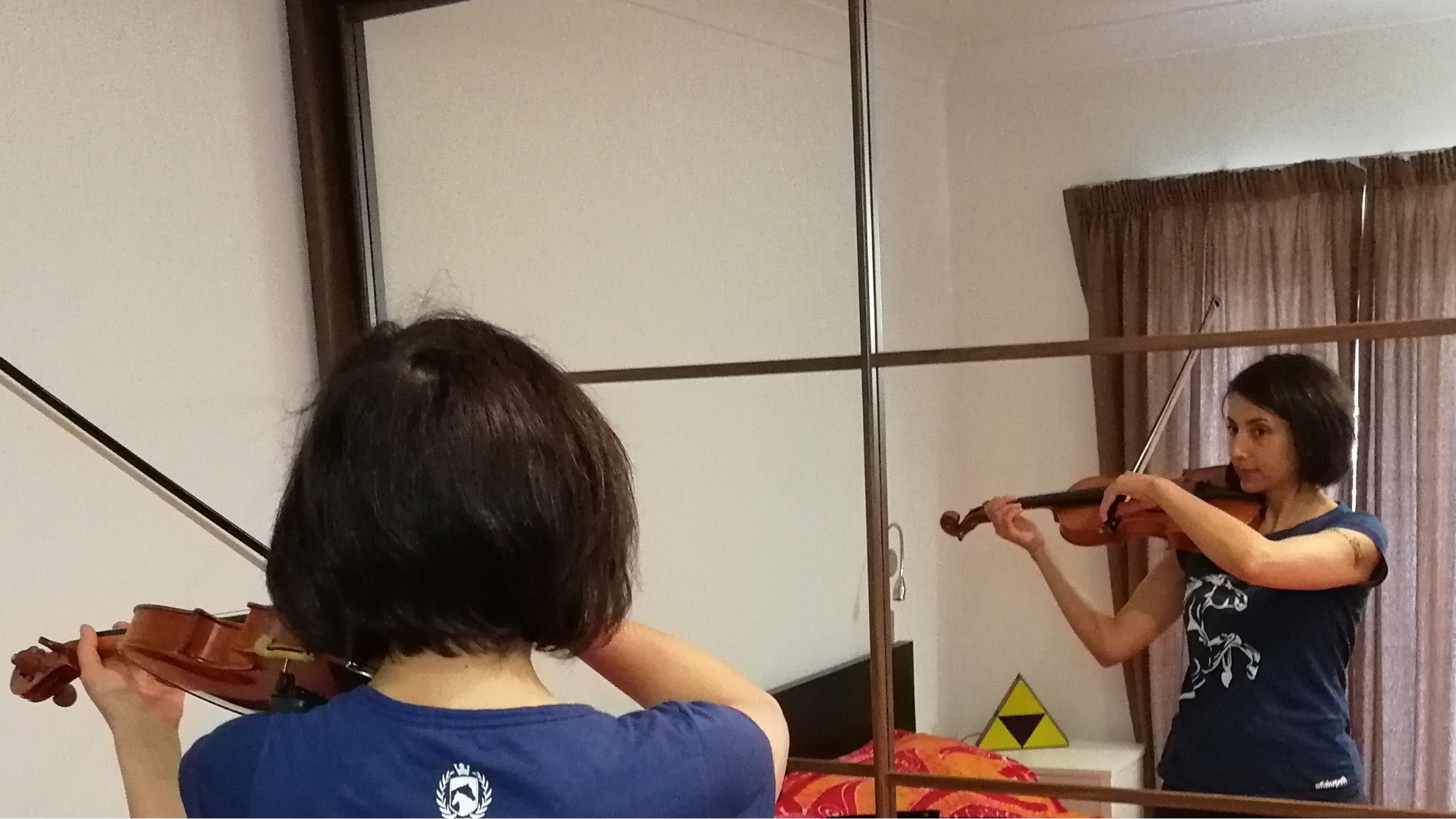
Mirrors are great for giving visual feedback on your technique. As your experience grows, you'll develop a second sense for what 'looks right' when playing the violin, and a quick glance in a mirror can give you instant feedback on whether what you're doing is effective or not.
As with the metronome and the tuner, don't become reliant on the mirror... instead, position yourself so that you can look into it easily, without turning your head.
If you're monitoring your bowing, then you'll need to rotate your body slightly to the left (as you're looking at the mirror, so that your feet are pointing at approximately a 45 degree angle to the left of the mirror.
Then you'll be able to see clearly whether or not your bow angles are correct, and whether the bow is approximately parallel to the bridge or not.
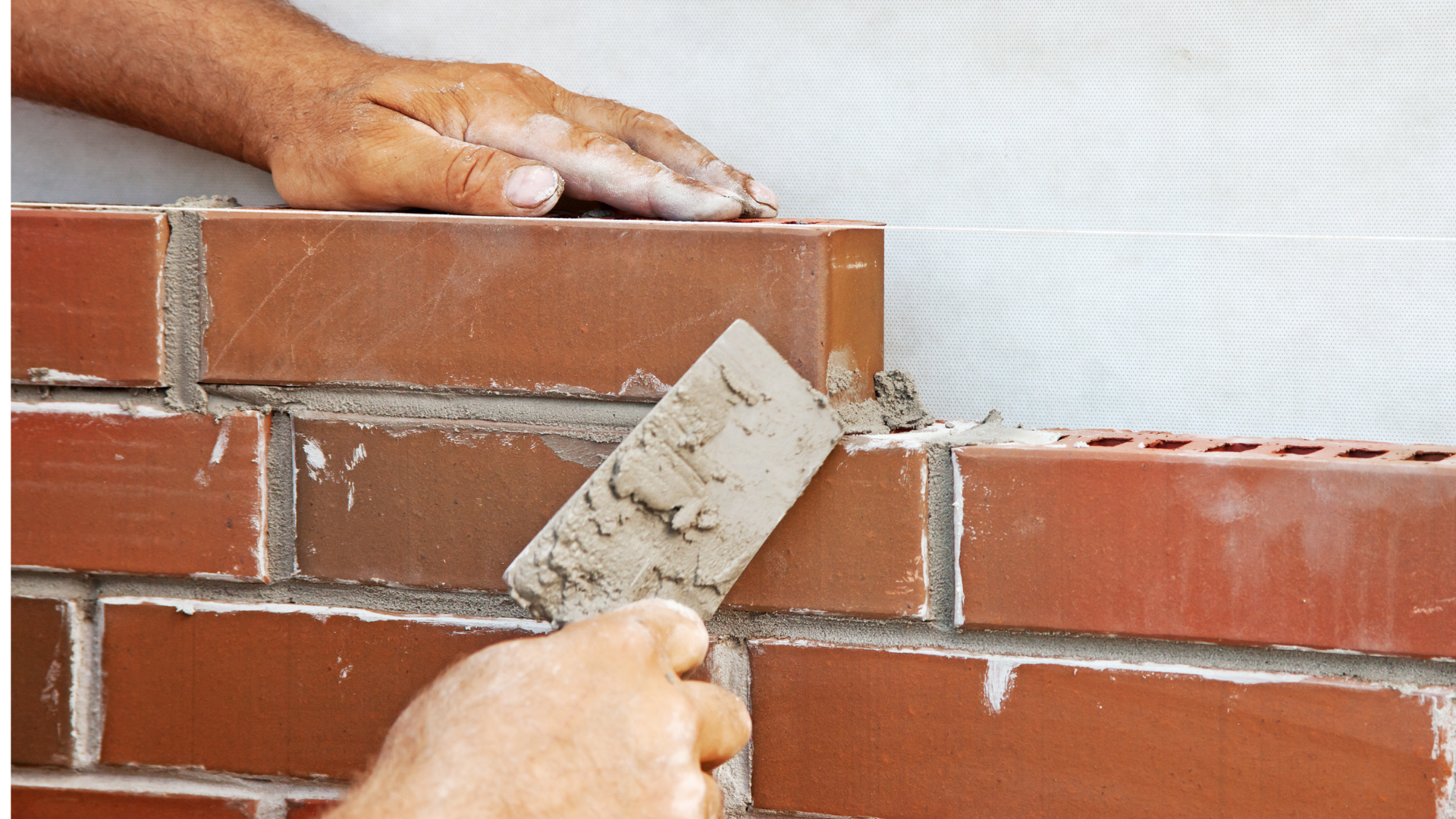
Learning a piece of music conscientiously is a bit like building a brick wall! Each brick needs to be carefully connected to the bricks next to it, so that you end up with a smoooothly constructed, neatly finished end product.
A great way of doing this is by breaking down the music that you're learning into 'blocks'. How big the blocks are is up to you - 1 block could equal 1 bar, or 1 phrase, or any other quantity that you think is appropriate!
Once you've practised each block, you then practise together with the next one.
Practise Block A, then Block B, then Blocks A + B together.
Then practise Block C, then Blocks B + C together.
Then practise Blocks A, B + C together.
Extend and repeat this for as long as you feel necessary!
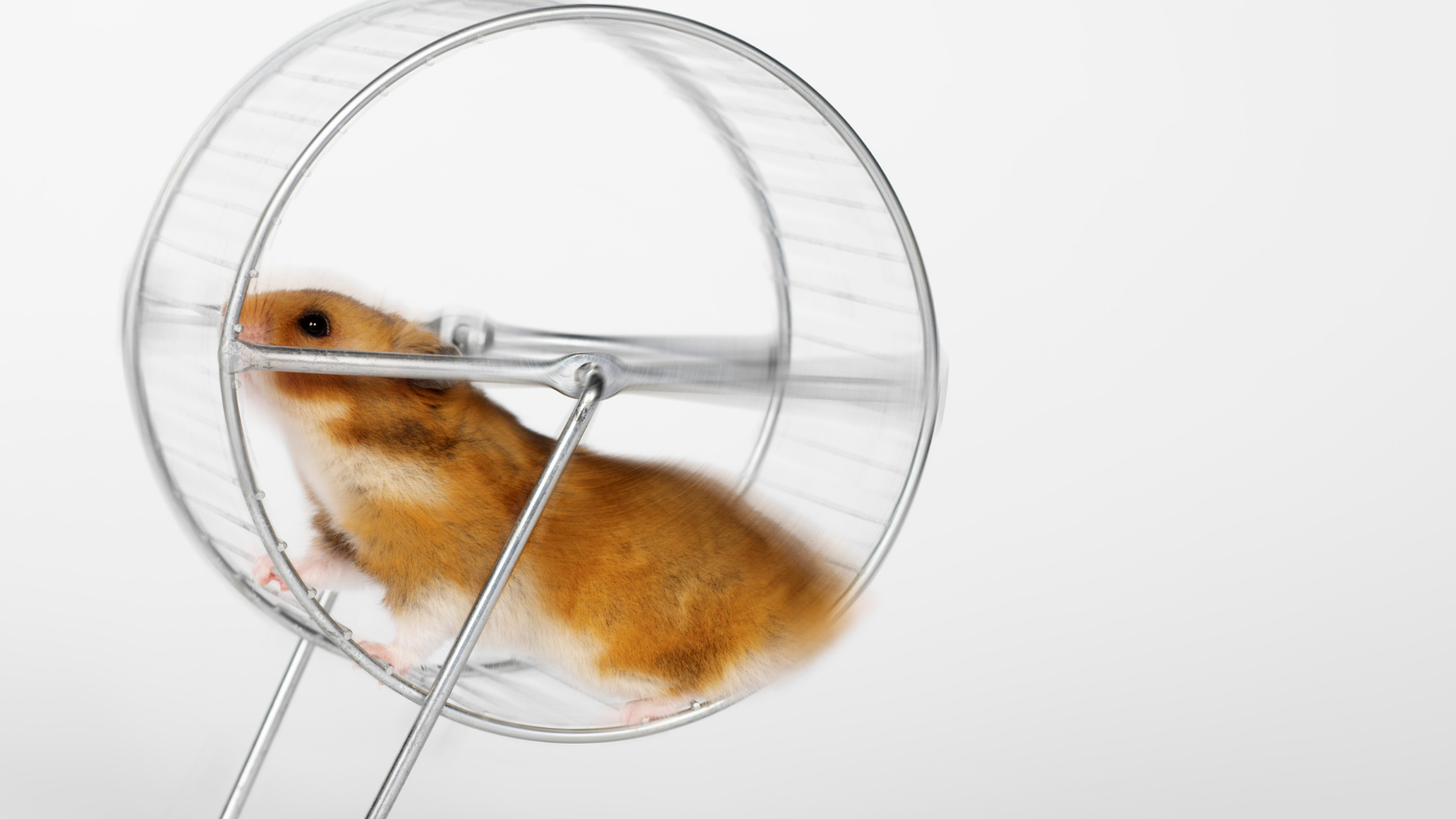
This one's simple. Solved a problem? Fixed a technical issue? Then 'loop' it - repeat it over and over again - until you've drilled the memory super-deep into your muscles!
Repetition is really powerful though, so be really careful that you're grooving in the right motions before you start looping things!

Good Technique is really important, but ultimately, most people play music on the violin in order to communicate emotion, and technique is only the means to that end.
Try exploring different ways of playing all the music that you practise... experiment with styles and characters that go beyond what you think you might eventually use. This way you'll discover interesting insights and perspectives; you'll think about the music you're playing in a new way.
Also, don't leave the 'musical' or 'expressive' side of things until too late in your practice... your technique needs to adapt to support your musical decisions, so begin experimenting with different musical ideas well before your technical motions are finalised.
One of the most important skills any violinist can have is knowing how to practise! This one single skill can transform your progress, because if you always know how to improve then you'll always be getting better and better!
A big part of knowing how to practise is being able to create a useful structure for each practice session that you do. A good structure should be a simple, solid framework that you can rely on to help you decide how to plan your time and what do do during that time.
But it should also be flexible. No one should ever dogmatically add things to their violin practice simply because they think it's 'the right thing to do' or 'because my teacher told me to'.
Instead, you need to be creative and switch around the tasks that you do from day to day, week to week -- according to what will help you get closer to your goals... faster AND better!
One of our favourite analogies for this is The Practice Menu. Think about how a restaurant would compartmentalise their menu according to different types of food.
It's necessary, isn't it? If the chocolate cake was next to the vegetable tart which was nestling between the coffee which was next to the soup... well, you'd just end up confused!
You need a structure that makes sense. And just like with food, where there can be infinite recipes and dishes - just as there are infinite variations in technical exercises and pieces of music for the violin - there are some useful guidelines that are broadly correct whoever and wherever you are.
In most restaurants you'll start with savoury starters and mains, some with sides. A sweet dessert will usually follow the main course.
Drinks will often be available on a separate menu, or at least in a clearly marked section. It's clear, it's organised, and it's easy to choose what you'd like.
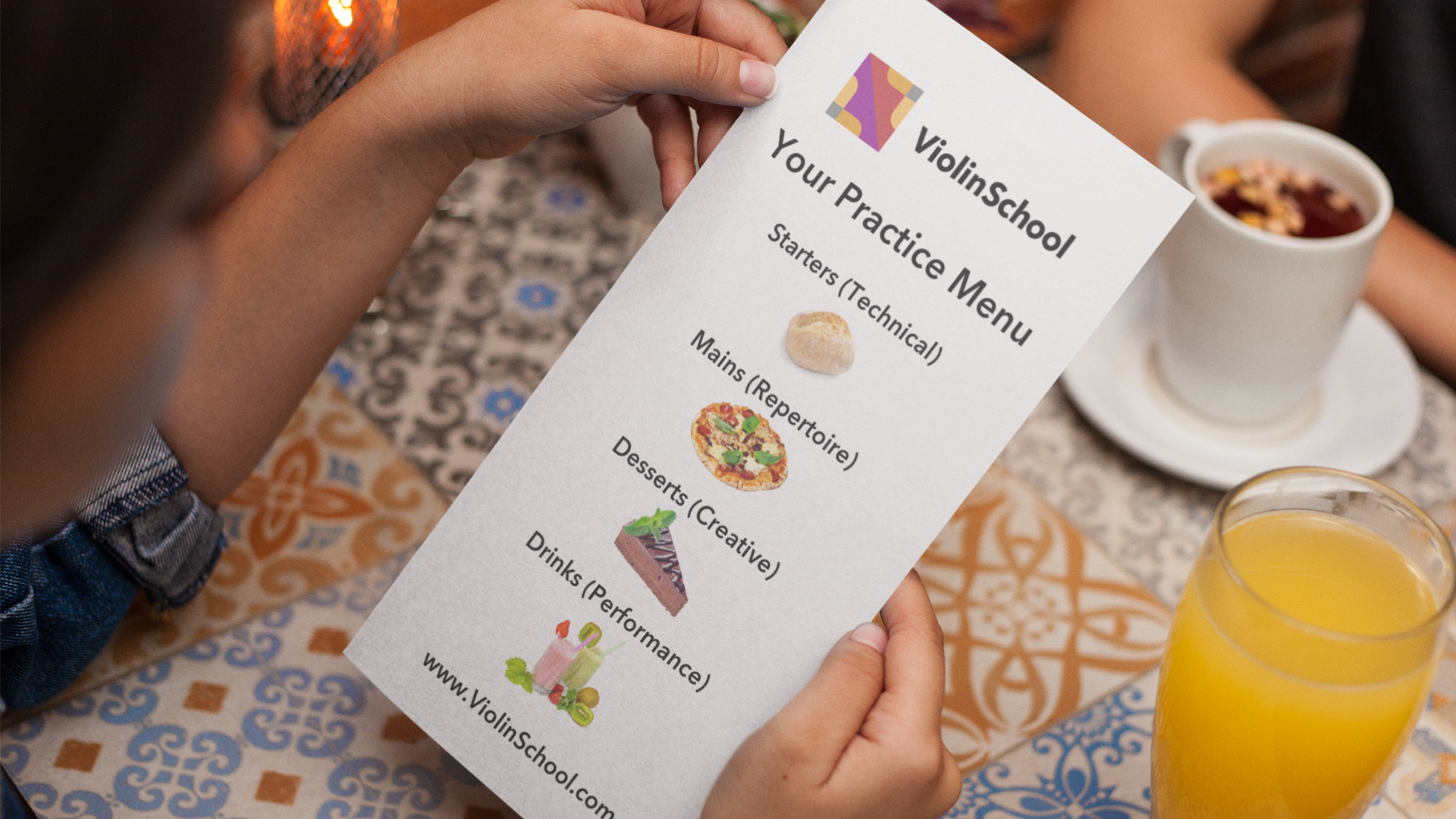
In your violin practice, try following a similar structure.
First begin with the STARTERS - the TECHNICAL part of your practice.
This is where you get your warm-ups done, but it's also a time for building your technique (for example, practising new techniques that you haven't mastered before) and maintaining (making sure that everything you already know is in really good shape).
Then you can move on to the MAIN COURSE - the REPERTOIRE - i.e. the pieces of music you play.
This is usually the biggest part of your practice. What you're looking to do in this part of your practice is to analyse and improve the technical and musical issues that will make a big impact on how you play each piece.
When you're having a meal, don't forget the DRINKS! In our analogy, that's the equivalent of performing.
Your performance practice is absolutely critical if you're going to get used to playing to other people, but you'd be surprised how often people forget about performance practice entirely. It's also a learnable skill, so with the right training you can eliminate performance anxiety completely.
Finally, don't forget to reward yourself with some DESSERTS! Whether it's composition (creating your own music), improvisation (creating music by playing it in real time!), sight-reading, music theory or any other musical topic that improves your overall musical experience, make sure you leave time for creative activities that will expand your general musicianship!
Being really creative in your practice is a great way to stay motivated and make sure that you're always excited about your playing.
[wcm_nonmember]In ViolinSchool's online learning programs, we go into great detail about how to approach practice, and to create a structure to your practice time that gets you great results. Our online courses include the How to Practise training and a section dedicated to useful practice resources.If you'd like to give your practice a boost then check out the benefits of ViolinSchool Membership to see how we can help you to transform your violin playing! We'll also help you to review your learning and put together a personalised practice plan for you when you join![/wcm_nonmember] [wcm_restrict]As part of your ViolinSchool membership, we can help you to plan your practice with a personalised practice plan (if you haven't already done this, email [email protected] and we'll get you started on this straight away).
Download the 'practice menu' sheet below - we recommend printing this out and keeping it in the place where you do most of your practice, so that you're keeping the structure of your practice front of mind! [/wcm_restrict]
A comprehensive, step by step guide to changing a violin string safely, securely and efficently … and so that it stays in tune!
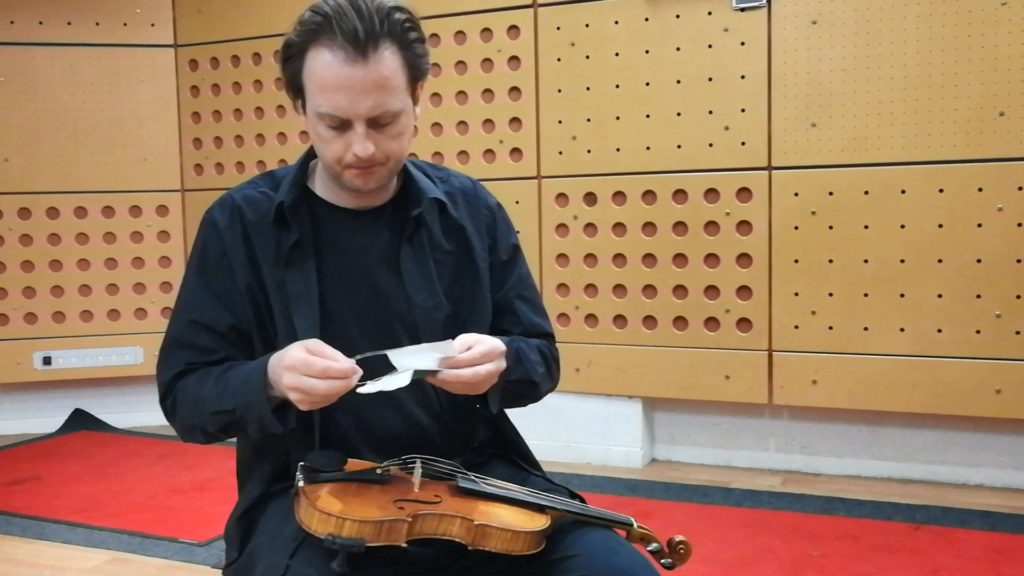
Changing the string of a violin doesn't need to be daunting!
Let's take a look at how to remove an old string and replace it with a new one.
We'll carefully consider all the steps of the process, so that you can avoid the string snapping, slipping out of place, or causing any other problems!
It's best to change violin strings one at a time so that you don't disturb the setup of the bridge.
Remember that the bridge - and the soundpost inside the violin - are only held in place by the tension of the strings.
This means that if you remove more than one string at the same time, the bridge can become unstable.
We're going to assume that you already have a replacement string, ready to use!

Remember that the type of string can greatly affect the sound of the violin.
You may wish to experiment with different types of string and see which brand works for you.
Strings can break for a variety of reasons, and sometimes with no warning.
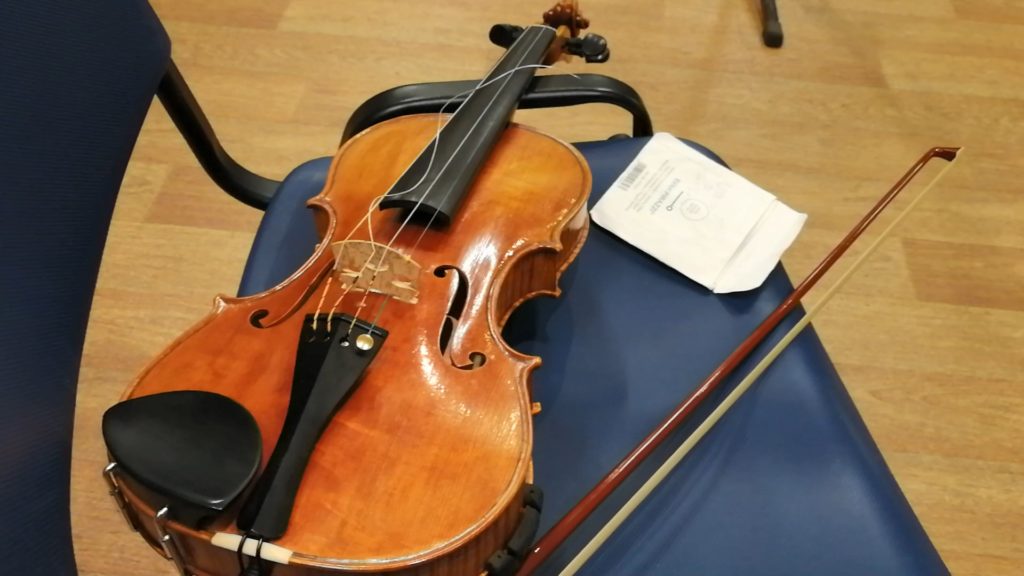
So it's a good idea to have a set of spare strings with you at all times in your violin case.
This will allow you to replace the string, and keep playing… without having to trek to a violin shop or wait for an online order to arrive!
First, place the violin in a secure position, such as on your lap. It's important to make sure that the instrument doesn't slip out of place when you're changing a string.
Firstly, remove the old string. You'll need to gently unwind the peg so that the string is loosened.
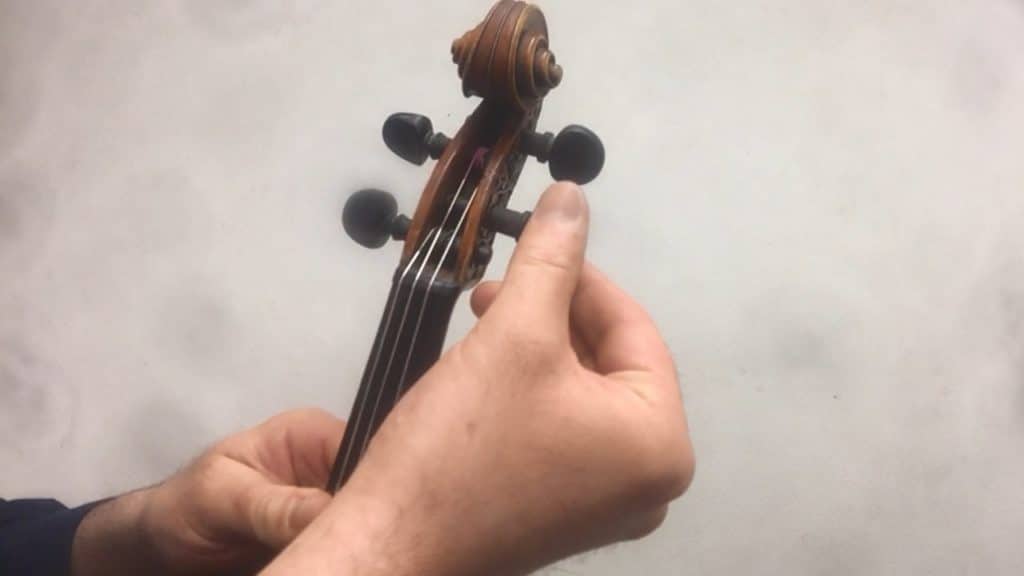
Keep turning until the top end of the string pops out of the hole in the peg, then you can simply pull it away from the violin.
Then detach the other end of the string from the violin's tailpiece. Some strings have a 'ball end', which means there's a small ball in the loop at the bottom end of the string.
To help this type of string out of the hole in the tailpiece, you may need to wiggle it a bit before it comes loose!
Other strings have a 'loop end', which is exactly the same but without the ball - so the bottom end of the string simply forms an empty loop.
This type of string can be easily secured or removed by placing the loop on or off the hook that you'll find on the fine tuner.
Before starting the string replacement, you should check the condition of the peg to make sure it will be smooth and secure when you put the new string in.
Make sure that the peg is clean. If not, the pegs can stick and squeak, and they won't turn smoothly!
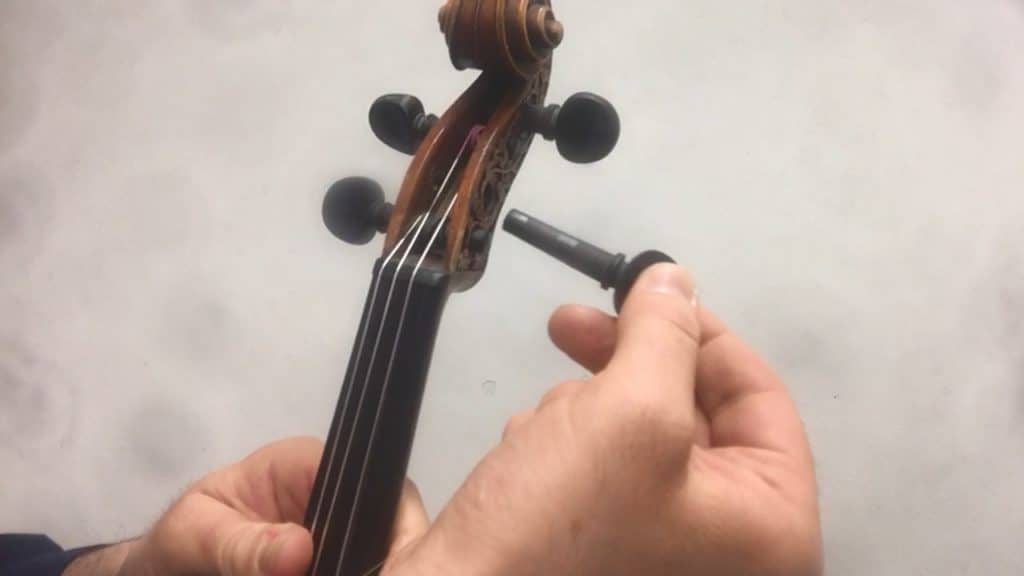
If you've taken the peg out of the pegbox, put it back in, but only halfway. Or if you didn't take the peg out, then pull it out of the hole just a little bit.
The aim is to make sure that the hole in the middle of the peg is visible and accessible, so that we can put the end of the string through the hole.

Make sure that the hole is not on the wrong side of any of the other strings.
If you start to thread the string through the peg when the hole is on the 'wrong' side of another string, you might end up with the strings crossing each other in the pegbox.
This doesn't work, as it can compromise the pitch and tone quality, as well as making the strings unstable.
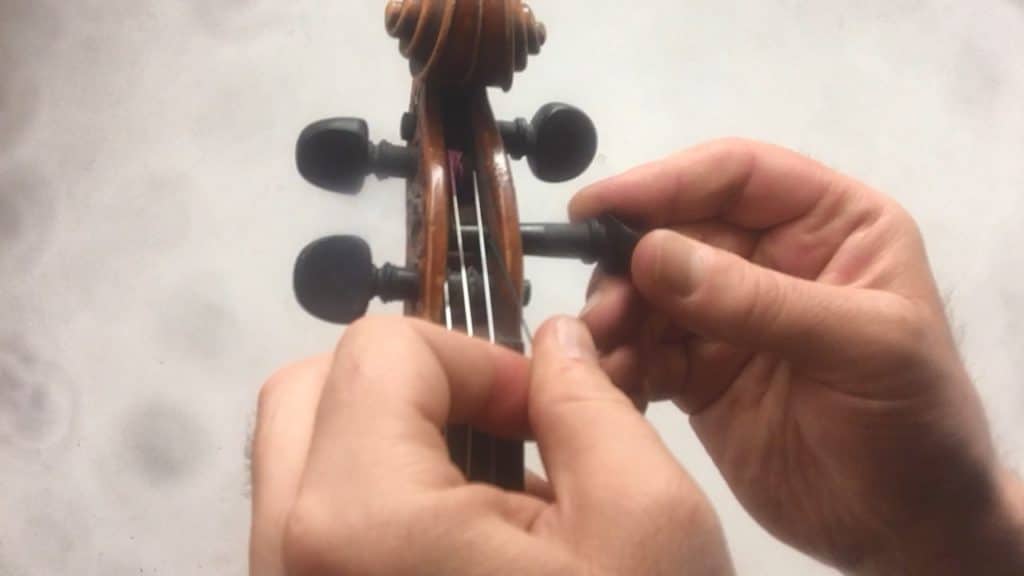
Once the hole in the peg is facing you, thread the end of the new string through the hole.
The string will poke out a tiny bit on the other side of the peg.
If you push it all the way in, you can usually feel the end of the string hit the back of the pegbox, so you know you've gone far enough.
Once the string is poking out from the other side of the hole, you'll need to turn the peg a few times to secure the string in place.
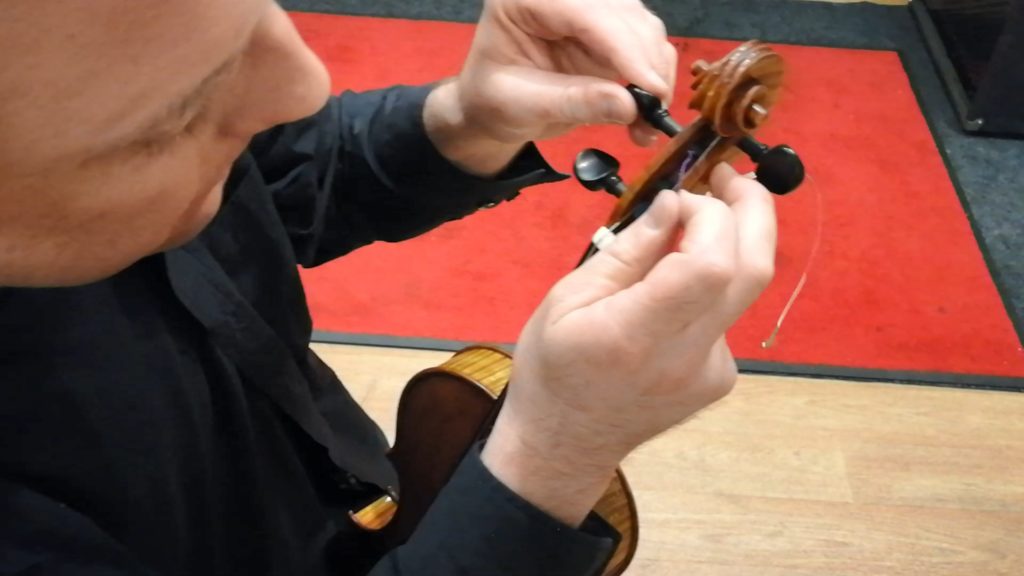
Make sure to turn the peg AWAY from you, not towards you, so that tension is held on the upper side of the peg. This way round, the top portion is angled more in line with the rest of the string, which reduces wear and tear.
As you turn the peg, you can use an adjacent string to guide you as you wind the string. The aim is to keep the string in a tidy coil as it winds onto the peg.

Once the top end of the string is well-coiled, you'll start to reach the end of the coloured wrapping at the top of the string.
At this point it's necessary to push the peg in, towards the pegbox, so that it is secure and there is enough friction between the peg and the hole of the pegbox.
This friction is very important… it's what holds the peg in place!
Once most of the coloured covered part of the string has been wound around the peg, hold everything in place with your weakest hand.
With your strongest hand (so, your right hand if you are right handed), reach for the other end of the string.
If your string has a 'loop' end, loop it onto the hook just above the fine tuner.
If your string has a 'ball' end, insert it into the hole in the tailpiece, and make sure that it's secure.
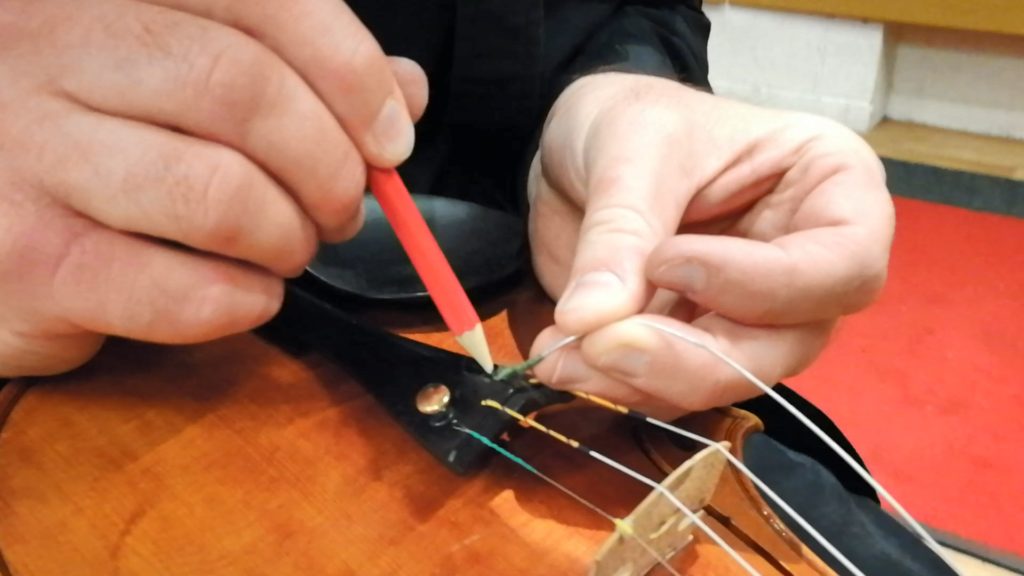
Sometimes it can be hard to insert the 'ball end' of a string into the tailpiece hole.
So if you need to, use a pointed object, such as a sharp pencil, to help push the ball downwards.
But if you do this, be really careful not to slip, as you could easily damage the varnish of the violin!
Once the bottom end of the string is securely attached, hold the string tense, so that both ends remain secure.
Your other hand should still be holding the peg firmly in place, because if you let go now, the string will uncoil, and you'll have to start all over again!
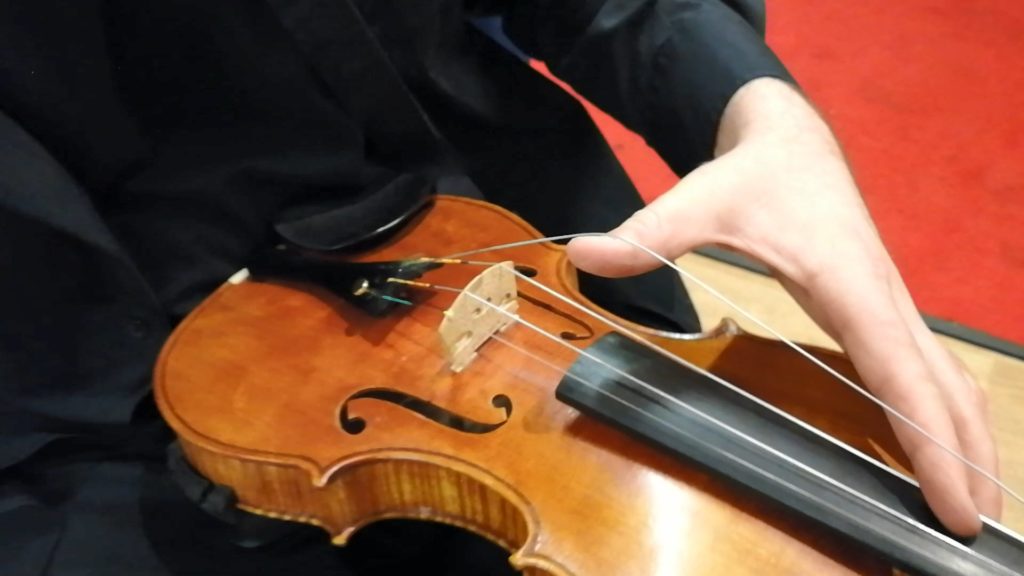
Without releasing the tension in the string, move your hand slowly back up towards the top of the violin, until both hands are within reach of the pegs.
Start to wind the peg slowly away from you, until the string is no longer loose, but not yet fully tightened.
Once there is enough tension in the main area of the string, you'll be able to let go of the string, and it will stay in place.
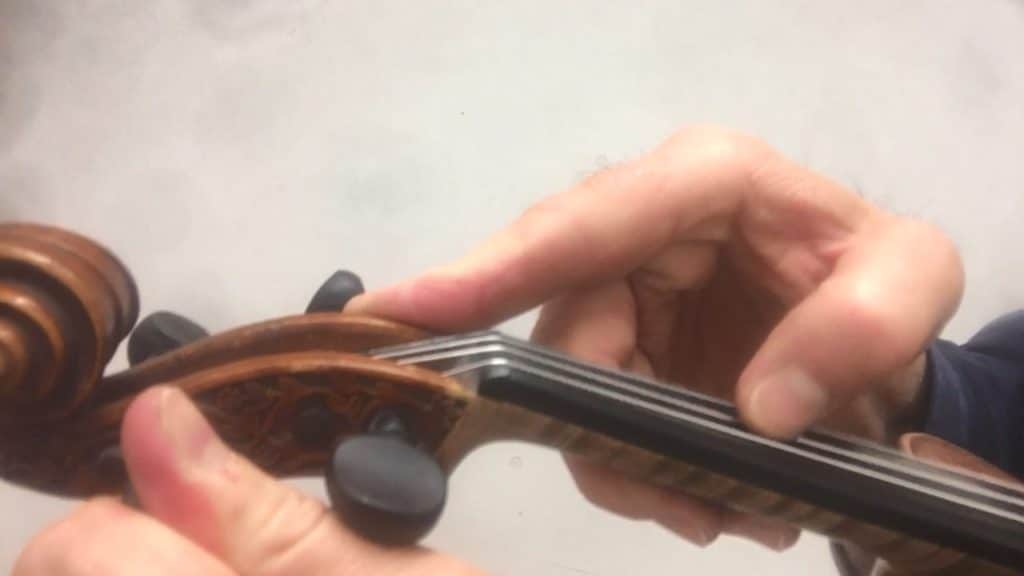
Once you've done this a few times, experience will tell you when the string is tight enough that you can let go of the string and it will stay in place!
Until then, you'll need to assess it visually and by feeling it. If the string is tight enough between the nut and the bridge, you will be able to pluck it and it will vibrate enough to produce a definite pitch.
When the pegs are turned and the tension in a string increases, pressure is applied to the bridge in the direction of the peg box.
Over time, this will pull the bridge until it slants away from the tailpiece. If this is not monitored and corrected, it will eventually collapse!
That's why it's a good idea to check the vertical position of the bridge each time you change a string.
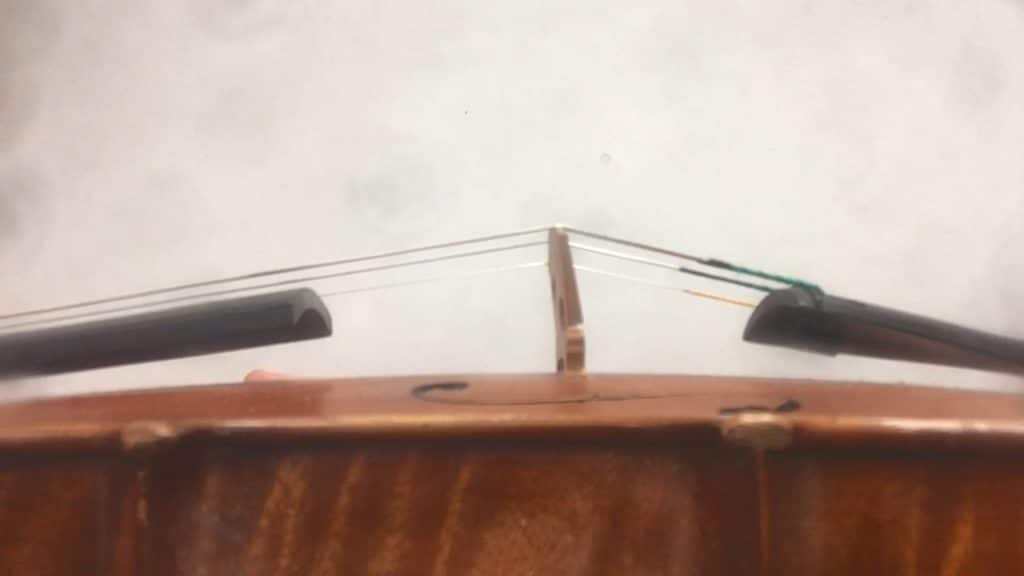
If the bridge position does require correction, use one hand to apply VERY gentle upward pressure to the strings, just below the bridge.
Be extremely careful … if you push too hard, you could snap a string or the bridge could collapse. And if you don't push enough, the bridge won't be able to move.
Very slowly and gently, use your other hand to apply pressure to the top of the bridge in the direction of the tailpiece. Nudge the bridge carefully back into an upright position, so that it is no longer slanting.
Changing a string is also a good opportunity to check that the bridge is still in the correct horizontal position.
Look directly at the face of the violin, and check the G and E strings are both positioned correctly in relation to the edge of the fingerboard. If the strings of the violin appear to be too far in one direction, you will need to re-centre the bridge position.
Secure the violin on your lap, then hold the bridge tightly using both hands. Slowly and gently, nudge it in the required direction until the strings are correctly aligned on the fingerboard.
Once the string is in place and the bridge position is checked, there's one more task that some strings require, before being tightened and tuned.
Many E strings (and some A strings) have a little coloured tube attached to them. The purpose of the tube is to provide extra support between the string and the bridge. It stops the string from cutting into the bridge.
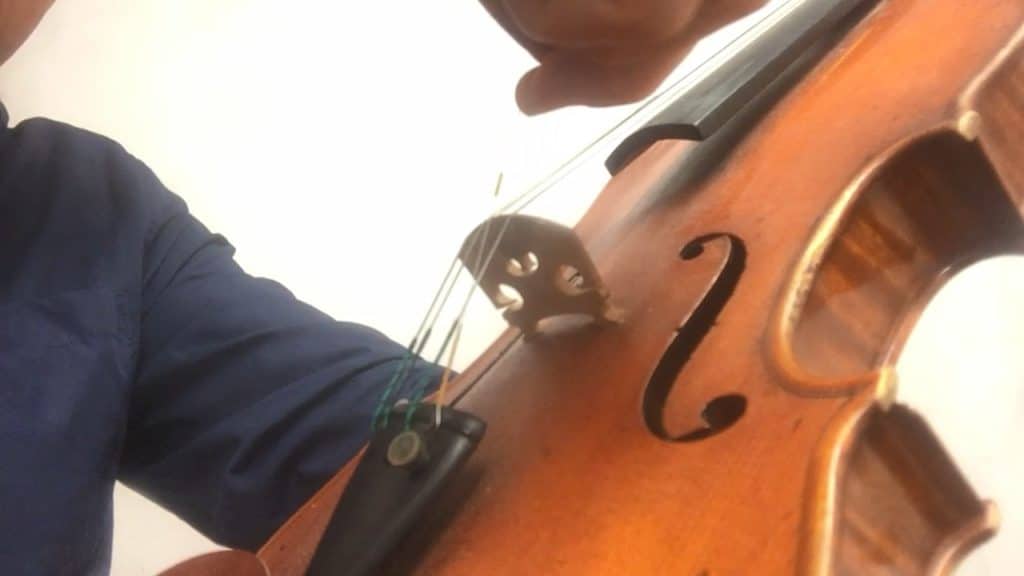
If the string you're changing does have a tube, then slide it along the string until it reaches the bridge.
Depending on how tightly you have already wound the string, you may need to loosen it very slightly in order to lift the string away from the bridge momentarily.
As you do so, slide the coloured tube so that it is sitting directly on top of the bridge of the violin, supporting the string.
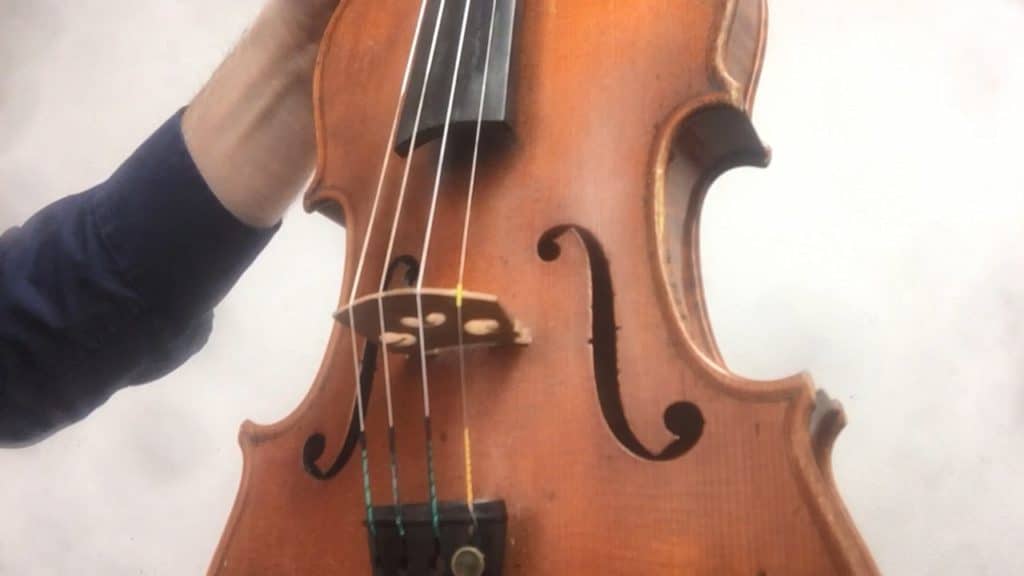
Once everything is ready, continue winding the string around the peg.
As you slowly wind it away from you, the string tension will increase, and you will start to hear the pitch of the string increase.
Keep plucking the string as you turn, so you can hear the pitch emerging, and the frequency increasing.
Remember, whatever you do, don't turn the peg too quickly… if you go too far, you'll snap the string!
Now it's time to tune the strings. Check out our feature, 'How to Tune a Violin' and follow the steps there to get your violin in tune.
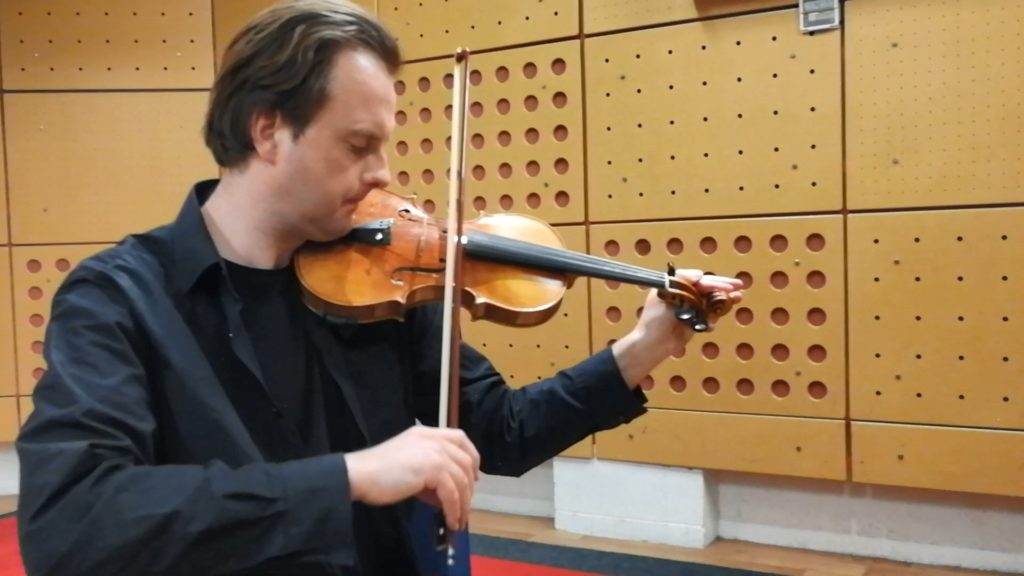
Make sure that you check the other strings as well as the one you've just changed. The changing tension in your new string is likely to have changed the pitch of the other strings as well.
Even a small adjustment to one string can immediately have an effect on another.
For this reason, there's not much point in trying to get your new string perfectly in tune until you've checked the other strings haven't gone too far out of tune as well.
Once your new string is installed, and tuned to 'approximately' the right pitch, you can roughly check all the other strings, before coming back to the new string and tuning it for a second time.
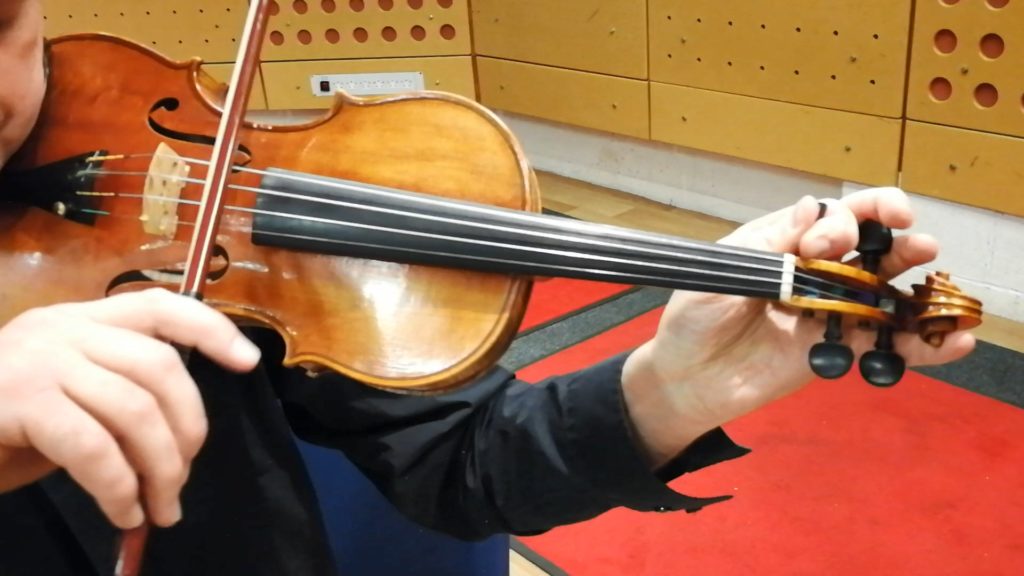
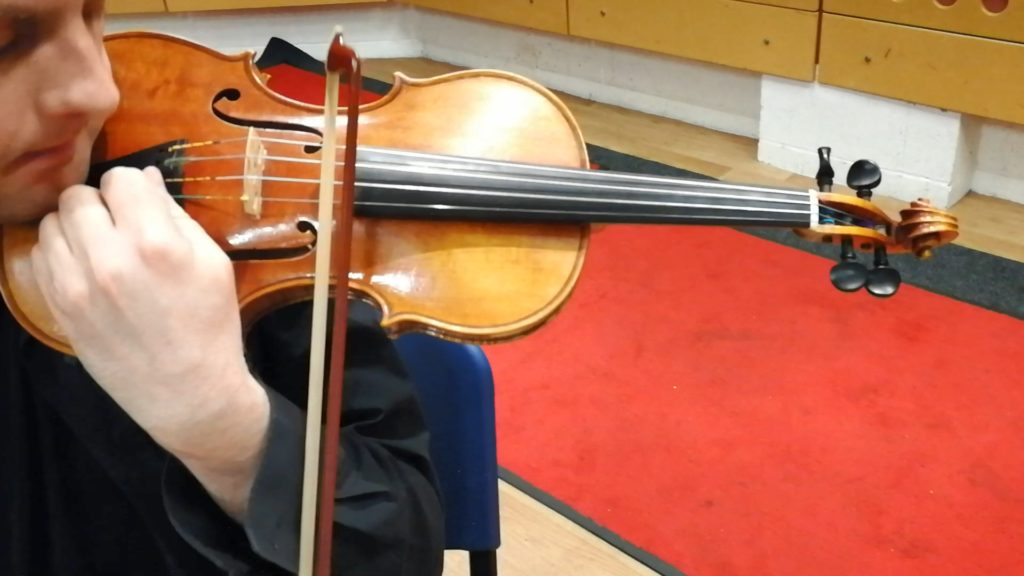
You can then do a second 'round' of tuning (and if necessary, a third!).
Once each string is at approximately the right pitch, you can focus on individual strings and make sure they have precisely the right level of tension (and pitch).
At this point you can also use fine tuners, if you have them!
Remember that a new string can take a while to 'settle' as it gets used to the new level of tension.
Sometimes this can take several days, or even a few weeks! So you are likely to need to tune the new string several times more than usual in the first few hours of playing.
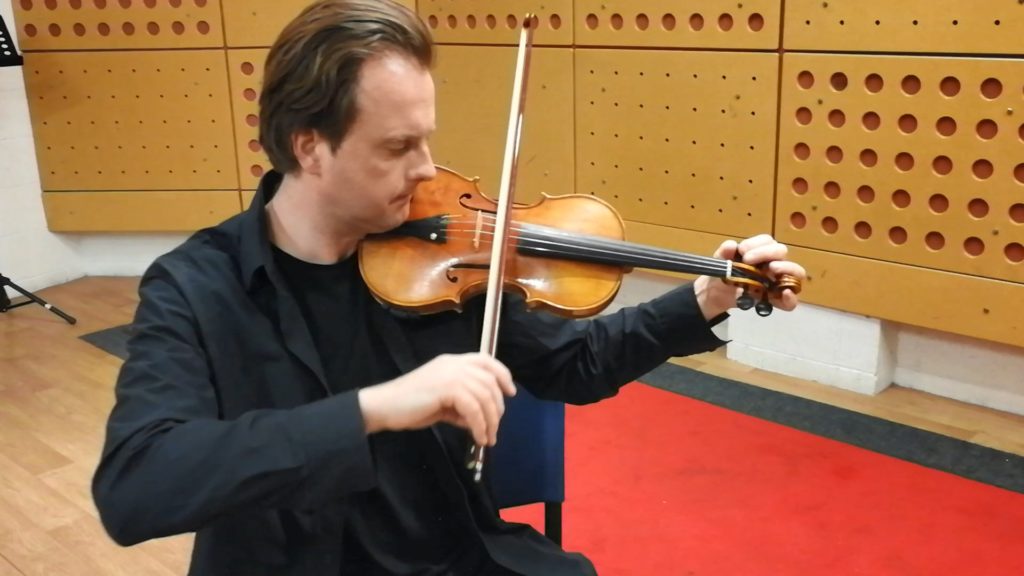
For this reason, it's a good idea to avoid changing the strings just before an important performance.
We also recommend keeping spare used strings in your violin case, as well as spare new strings.
Then if a string breaks just before or during a performance, you can change to a string that's already been stretched and settled on the violin.
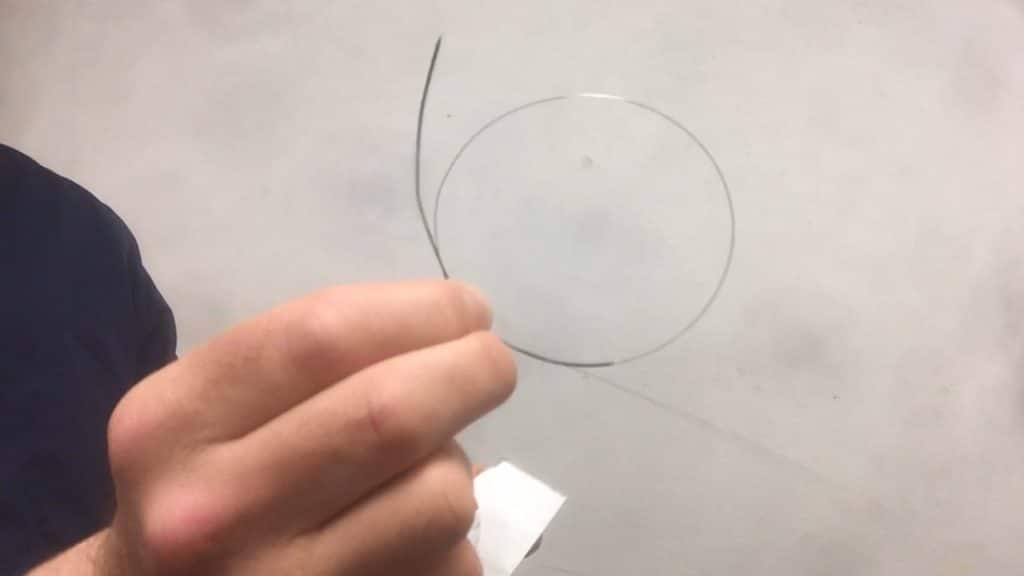
If there's anything else you'd like to know about changing a violin string that's not covered by this feature, just email our Learning Support team at [email protected] and we'll be very happy to help you!
There's a lot to know about getting a violin ready to play!
So if you've found this feature useful, then check out our free course, 'Get Set Up', which covers all the essentials, from finding and selecting a violin to bows and accessories to chin and shoulder rests.
Click here to explore ViolinSchool's free 'Get Set Up' online course!
A | B | C | D | E | F | G | H | I | J | K | L | M | N | O | P | Q | R | S | T | U | V | W | X | Y | Z
Suggest a word
A
A – The musical note, ‘A’, is the sixth degree of the scale of C major. It’s a pretty important note! The ‘Concert A’ has the universal standard of 440Hz, commonly used as the standard for the tuning of instruments … it’s the note that orchestras tune up to. ‘A’ is also the pitch of the second string on the violin (E string = I, A String = II, D String = III, G String = IV).
Accelerando – Becoming gradually faster … accelerating. Usually abbreviated to accel.
Accent – An accent mark (>) means that a note should be given extra emphasis, especially at the initial attack of the sound. Notsues with accents will be louder and more strongly articulated, but not necessarily loud and aggressive! You can also have soft, mellow, singing accents within a quiet dynamic.
Acciaccatura – ‘Crushed note’. The little diddy note or notes, played really quickly and squeezed in before the main note. It’s a type of grace note or ornament, written smaller in the score.
Accidental – These are the signs used for notes that are outside the key signature, or to cancel notes in the key signature. The sharp (♯) raises the note by one semitone, the flat (♭) lowers it by one semitone. The natural (♮) cancels any other accidental. The double sharp (x) and the double flat (?) raise and lower the note respectively by a tone (two semitones).
Adagietto – Slow, but not quite as slow as Adagio. Have a listen to the ‘Adagietto’ from Gustav Mahler’s Symphony No. 5, it’s one of the most sublime things in the universe!
Adagio – To be played slowly, from ad agio, meaning 'at ease'. Many a symphony, concerto, sonata etc. will have a slow movement marked Adagio. Have a listen to Samuel Barber’s ‘Adagio for Strings’, it’s one of the most moving, melancholic things in the universe!
Ad libitum – ‘At liberty’. Usually abbreviated to ad lib. The manner of execution is left to the performer. Freedooooooom! ☺
Affettuoso – Affectionate, moving, emotional, tender. Also an indication of a slower tempo, somewhere between adagio and andante.
Agitato – Agitated, restless.
Alla breve – Meaning ‘double the speed’, or in ‘cut time’, so that, for example, 4/4 is given the effect of 2/2, where the basic time unit becomes the minim and not the crotchet. Often notated as a ‘C’ with a line through it (cut common time).
Allargando – ‘Broadening’. Gradually becoming slower. You’ll often find a crescendo where you find an allargando!
Allegretto – Faster than andante, slower than allegro! Fairly brisk and lively, often a bit lighter in style than allegro.
Allegro – Brisk, lively, bright, rapid. Many a virtuoso violin piece is marked allegro!
Alto Clef – Thankfully, violinists only have the one clef, the treble clef. If, heaven forbid, you decide to play the viola, then you’ll need to learn the alto clef, or C-clef, where the middle line of the stave represents the note ‘Middle C’.
Amabile – Amiable, lovable, pleasant.
Amoroso – Loving, affectionate.
Anacrusis – A note, or a series of notes, taking place before the first complete bar. The notes of an anacrusis form the upbeat (or ‘pickup’), ‘unstressed’ notes that precede the ‘stress’ of the first downbeat.
Animato – Animated, lively.
Andante – A moderately slow tempo, somewhere between adagio and allegretto! Often defined as ‘at a walking pace’ … think gentle stroll in the countryside rather than rush hour in London!
Appassionato – Passionately, impassioned.
Appoggiatura – A type of ornament, it’s a more dissonant note that ‘leans’ on a more consonant note, and takes part of its time value. Naughty, kleptomaniacal things! More often than not, the dissonance is a step above or below, resolving up or down onto the main note.
Arco – ‘With the bow’. Usually used after pizzicato, to tell string players to stop plucking and play with the bow.
Arpeggiando, Arpeggiato – a fun and impressive technique in string playing, where the bow bounces back and forth across the strings on broken chords, with each bounce being on a different string. It’s used stunningly effectively in the cadenza of Felix Mendelssohn’s Violin Concerto in E minor, and maestro Niccolò Paganini based the first of his 24 Caprices around this technique.
Arpeggio – Playing the notes of a chord, one after the other – a ‘spread chord’ or ‘broken chord’ – from the bottom upwards or the top downwards. Don’t forget to practise your arpeggios as well as your scales!! ☺
Articulation – This is like punctuation in language, and like the hardness of consonants vs. the softness of vowels. ‘Articulation’ describes the degree to which notes are separated and the level of ‘attack’ with which they begin and end. This can range from the shortest, spikiest staccato to the smoothest, honeyed legato, and anywhere in between.
Artificial harmonics – Harmonics are produced by touching the string veeeery lightly at one of the harmonic nodes located along the string. This way, when you bow or pluck it, the whole string vibrates, both above and below the finger, producing harmonic overtones. There are two types of harmonics: natural harmonics and artificial harmonics. Natural ones are produced on open strings, with just one finger lightly touching. Artificial ones are produced on stopped strings, with the lower finger pressing down (thus ‘shortening’ the string) and the upper finger lightly touching. Harmonics have a really special tone ‘colour’, a delightfully airy, flutelike quality.
Assai – ’Very’, ‘Much’, e.g. allegro assai, ‘very fast’.
A tempo – go back to the original or previous tempo, after having sped up or slowed down.
Attacca – ‘Attack’. Usually used at the end of a movement to indicate that the next movement should follow without a break.
B
Bar – Music is organised into bars (or measures), separated by vertical barlines, and with each bar containing a certain number of beats. This number is specified in the time signature at the beginning of the stave, or, if you fancy having a different number, at the beginning of the bar itself! By neatly batching up the notes into bars, the music becomes significantly easier to assimilate. It also helps to convey the ‘feel’ of the beat structure: strong beats and weak beats; downbeats and upbeats
Bariolage – A virtuosic bowing technique that involves rapidly oscillating between notes on different strings, with a repeated note (usually an open string) in between. It’s used absolutely brilliantly in the Preludio of Partita No. 3 in E major by Johann Sebastian Bach. There’s also a bedazzling cadenza-like passage of bariolage towards the end of Fritz Kreisler’s Praeludium and Allegro in the Style of Pugnani.
Bartók pizzicato – ‘Slap’ pizzicato. A technique in which the string is pulled away from the fingerboard so that it snaps back percussively onto the fingerboard.
Bass – The lowest of the standard four voice ranges (soprano, alto, tenor, bass). Often refers to the lowest regions of musical pitch, e.g. the lowest note in a chord, or the lowest melodic line.
Beat – The basic unit of time in mensural music – the thing you tap your foot to … the thing the conductor waves her arms to! Beats are ‘felt’ differently depending on where they are in the bar, so, as a general rule: a two-beat bar is strong-weak; a three-beat bar is strong-weak-weak: a four-beat bar is strong-weak-strong(ish)-weak!
Bellicoso – Warlike, aggressive.
Bravura – Boldness, extroversion, virtuosity; great technical skill and brilliance shown in performance. Often used as a performance direction, con bravura, as in, ‘with bravura’.
Breve (double whole note) – A note equal to two semibreves (or two whole notes). Not used very often, except in church music, it’s the longest note value used in modern notation.
Bridge – The ornate, upright, wooden device that holds the violin’s strings in place, supported above the soundboard. It isn’t glued or fixed to the instrument! … it’s kept in place by the pressure of the strings.
Brio – Vivacity, liveliness; e.g. con brio, ‘with fire’, ‘with spirit’.
C
Cadenza – An extended ornamental passage, usually near the end of a concerto movement, usually featuring the soloist alone, usually pretty rhythmically ‘free’, and usually pretty ‘showy-offy’! Some cadenzas are written by the composers themselves, some by the performers themselves, and some by other people.
Cantabile – ‘Singable’, ‘Songlike’. Played in a singing style. The ultimate aim of the violinist … to get as close to the human voice as possible!
Chamber music – Music for smaller ensembles, usually with each person playing their own specific part – duos, trios, quartets, quintets, sextets, septets, octets, nonets, dectets!
Chin rest – The specially shaped device, attached at the front-bottom of the violin, that allows the instrument to be held comfortably under the violinist’s jaw (it should really be called a jaw rest!).
Chopping – A highly percussive technique, in which the bow (at the heel) is struck against the strings to produce a short, sharp, ‘scratch’ tone of indeterminate pitch.
Chord – Two or more notes sounding together – in glorious (or not so glorious) harmony!
Chromatic – The chromatic scale divides the octave into 12 equal intervals of a semitone. Chromaticism involves moving up and down this scale in semitones.
Clef – The symbol at the beginning of the stave tells us what the pitches of the notes on the stave are. The pitch and the octave-register of the notes will be different depending on the clef. Violin music is (almost!) always in treble clef. Instruments that are lower-pitched use the bass clef, and violists, oh those poor violists, have to learn the alto clef! ☺
Coda – ‘Tail’. The concluding passage of a piece or movement, often as an addition to the basic structure or standard form. Rounds things off nicely!
Coffee – An elixir; essential fuel for long and highly productive practice sessions.
Col legno – ‘With the wood’. This tells the string player to strike the string with the stick of the bow (yes … THE STICK!), and not the hair. It produces a wonderfully percussive effect, especially when a whole string section of the orchestra does it! Col legno battuto is when you hit the string with the wood (this is the usual way). Col legno tratto is when you drag the wood across the string (this is the very unusual way!). There’s a fantastic example of col legno in the final movement (‘Dream of a Witches' Sabbath’) of Hector Berlioz’s Symphonie fantastique.
Common time – Another name for 4/4 time, denoted by the letter ‘C’ as the time signature.
Comodo – ‘Comfortable’, ‘Convenient’; e.g. tempo comodo, at a comfortable, moderate speed.
Compound time – A time signature in which each beat is subdivided into three equal parts, e.g. 6/8 (two beats of three quavers each, compound duple time); 9/8 (three beats of three quavers each, compound triple time); 12/8 (four beats of three quavers each, compound quadruple time).
Concerto – A piece, typically in three movements, written for one or more soloists with orchestral accompaniment. Many of the great composers have written violin concertos – Johann Sebastian Bach, Antonio Vivaldi, Ludwig van Beethoven, Alban Berg, Jean Sibelius, William Walton, Johannes Brahms, Dmitri Shostakovich, Edward Elgar, Felix Mendelssohn, Wolfgang Amadeus Mozart, Samuel Barber, Béla Bartók, Sergei Prokofiev, Niccolò Paganini, Max Bruch, Camille Saint-Saëns, György Ligeti, Pyotr Ilyich Tchaikovsky, Benjamin Britten, Antonín Dvořák – to name a few!
Con sordino – ‘With mute’. A direction telling the violinist to use a mute. Usually abbreviated to con sord.
Crescendo – ‘Growing’, ‘Increasing’. Gradually getting louder. Often abbreviated to cresc. The opposite is decrescendo, or, more commonly, diminuendo (dim.)
Crotchet – ‘Quarter note’ in American. Quarter of the value of the semibreve (whole note).
D
Da capo – ‘From the head’. An instruction to go back to the beginning of a piece, often abbreviated to d.c.
Demisemiquaver – ‘Thirty-second note’ in American. 1/32 of the value of the semibreve (whole note). Half the value of the semiquaver (sixteenth note).
Détaché – Each note played with a separate bow stroke. Even though détaché means ‘detached’, the notes should not be separated or disconnected! Move smoothly and seamlessly from one note to the next, even weight and consistent sound throughout.
Diatonic – Notes that belong exclusively to one key without any chromatic alteration.
Diminuendo – ‘Diminishing’. Gradually getting quieter. Often abbreviated to dim. The equivalent of decrescendo, the opposite of crescendo.
Divisi – ‘Divided’. Often abbreviated to div. and very often used in orchestral scores, this is where players reading music from the same parts, from the same staves, are asked to share the notes amongst themselves, dividing them between players. For example, a passage that features two simultaneous lines of music can be divided between two violinists, where double stopping is non-optimal or impossible! One player plays the top note, the other the bottom. Ah, teamwork! ☺
Dolce – ‘Sweet’. To be played softly, tenderly, sweetly. Dolcissimo, very sweet! Mm-mmm! ☺
Dolente – ‘Doleful’. Sad, plaintive ☹
Doloroso – Sorrowful, painful. ☹
Dominant – The fifth degree of the major or minor scale.
Double dot – A double-dotted note is a note with two small dots after it, indicating that it should be prolonged by three quarters of its original length.
Double Stopping – Playing on two strings at the same time to produce two notes at the same time. Even though it’s called double stopping – and ‘stopping’ means to make a note by pressing the string against the fingerboard – one or both of the strings can be open and it’s still called double stopping!
Downbeat – The first, and ‘strong’, beat of the bar. Grrrrr!
Down-bow – Any bow stroke that travels to the right (assuming you are holding the bow in the right hand and the violin in the left hand!!)
Duplet – Two in the time of three. A note-grouping of two, which fits into the length of three of its note-type. Indicated by a little figure ‘2’ placed above or below.
Dynamics – Relating to the volume and the ‘character’ of the sound. The most common dynamic markings are: ppp (pianississimo – very very soft); pp (pianissimo – very soft); p (piano – soft); mp (mezzo piano – moderately soft); mf (mezzo forte – moderately loud); f (forte – loud); ff (fortissimo – very loud); fff (fortississimo – very very loud).
E
Echo – The imitation in music of the natural echo effect; for passages of music that happen twice, the repetition is played with less volume and less force than the original statement.
Energico – ‘Energetic’, strong.
Enharmonic – Refers to notes that have the same pitch, but a different name, e.g. C#/Db, or F/E#. The choice of sharp, flat, double sharp, double flat, is known as the enharmonic spelling of a note.
Ensemble – A group of performers of any size, from just two all the way up to an entire orchestra; usually applied to smaller chamber-music groups. The word ‘ensemble’ is also used to describe how well they play together, as a collective, how unified the timing, balance, style, etc. of the group is.
Equal temperament – A system of tuning the scale so that the octave is divided into 12 equal semitones. This is the standard tuning for the Western 12-note chromatic scale; the way a piano is tuned.
Espressivo – ‘Expressive’. Played with added expression, heightened emotional commitment.
Étude – A piece designed to focus in on one particular instrumental or compositional technique, to train the performer in that technique, and for the performer to then show off that technique! There are a good many books of violin études, such as those by Rodolphe Kreutzer, Jakob Dont, Pierre Rode, Federigo Fiorillo, Henryk Wieniawski, Niccolò Paganini, Heinrich Wilhelm Ernst … but, for the most part, these tend not to be the greatest pieces of music! We need to look to the piano for études that are also transcendentally brilliant pieces – Frédéric Chopin, Franz Liszt, Robert Schumann, Claude Debussy, Alexander Scriabin, Sergei Rachmaninov, György Ligeti – not a bad list!
Expression – Expression is the ‘umbrella’ term for all of the emotionally expressive qualities that go into music making. These include things like dynamics, tempo, rubato, phrasing, articulation, vibrato, timbre, facial expressions! ☺
Extension – An established hand ‘frame’ along the violin’s fingerboard is called a position; reaching backwards or forwards out of this frame, without shifting, is called an extension.
F
Fermata – Another word for ‘pause’. The fermata/pause sign (?) indicates that a note (or a rest!) should be prolonged/stretched at the performer’s discretion (within reason!).
Feroce – ‘Fierce’. Ferociously.
F-holes – The violin family’s sound holes, shaped like the letter ‘f’, helping to project the instrument’s sound more efficiently.
Finale – The last movement of a multi-movement work.
Fine – ‘End’, ‘Close’. Repeat a passage but only to the place marked fine.
Fine tuners – Also called fine ‘adjusters’. Screws (usually metal) attached to the violin’s tailpiece that can be turned to make very small changes to the pitch of the string. Turning clockwise, the pitch becomes higher (the string is under more tension) and turning anti-clockwise, the pitch becomes lower (the string is under less tension).
Fingerboard – The smooth playing surface (usually made of wood) under the violin’s strings. Pressing the string down onto the fingerboard changes the vibrating length of the string and thus changes the pitch of the note produced.
Fingered octaves – Playing a passage of double-stop octaves with an alternating finger pattern, e.g. 1-3 and then 2-4 (as opposed to a non-alternating pattern, e.g. 1-4 and then 1-4, or 1-3 and then 1-3).
Fingering – Which left-hand fingers to use and which string to use them on! In violin playing, we use the 1st, 2nd, 3rd, & 4th fingers on either the G, D, A, or E string. It would be fair to say that there are ‘good’ fingerings and ‘bad’ fingerings: musical and unmusical ones; stylistic and unstylistic ones; reliable and unreliable ones; cheap and expensive ones! More often than not, it’s possible to play the same note on different strings, and so the choice of fingering will greatly affect the timbre, the ‘colour’, of the sound, and the ease with which notes can be played. In fast passages, it is wise to choose ‘economical’ fingerings, minimising movements – like unnecessary shifts and string crossings - that might slow us down and muddy the waters! Most sheet music comes with recommended fingerings, the little numbers above or below the notes. Remember, these are only suggestions, and you should always explore other possibilities. That way, you’ll find the fingering that feels, and sounds, right for YOU!
Flat – The symbol (♭) that lowers the pitch of a note by a semitone. Also used to describe inexact intonation that is on the low side.
Flautando – ‘Flute-like’. To play with a point of contact that is nearer, or ‘over’, the fingerboard in order to produce an airy, fluty, panpipey tone!
Form – The arrangement of musical structures in time, the organisation of the elements.
Forte – Loud, strong. Abbreviated to f. (fortissimo, ff = very loud; fortississimo, fff = very very loud; fortissississimo, ffff = very very very loud!).
Fortepiano – Loud, then immediately quiet. Strong, then immediately soft. Abbreviated to fp.
Funebre – ‘Funereal’. Gloomy.
Fuoco – con fuoco, ‘With fire’. Fast and wild!
Furioso – Furiously.
G
G.P. – General Pause or ‘Grand Pause’. An indication that the entire ensemble has a rest and so nobody should play! Shhhhhhh!
Giocoso – Playful, lively, merry, humorous.
Giusto – ‘Just’, ‘Exact’, (e.g. tempo giusto, in strict time)
Glissando – A slide, upwards or downwards, from one pitch to another. One of the great things about the violin family of instruments is that, unlike the piano, you can play all the microtones between notes by sliding the finger up or down the string. This means you can do a really good glissando! It’s a really expressive device that emulates the natural way we move between notes when we sing. A glissando is notated by a diagonal straight or wavy line connecting the highest and lowest pitches.
Grace notes – Quick little ornamental notes printed in smaller type in the score. Often used to embellish a melody, like putting ornaments on the mantlepiece, decorating it and elaborating on it whilst maintaining the melody's original structure.
Grandioso – ‘Grandiose’, grandly.
Grazioso – Graceful, elegant.
Groove – Steady, replicating, propulsive rhythmic gestures of music that are 'felt' and responded to kinaesthetically.
H
Hairpins – The colloquial word used to describe the crescendo (?) and diminuendo (?) signs.
Harmonic – Very special notes produced in a very special way … revealing the magic of the harmonic series! Harmonics are made by touching the string veeeery lightly, as opposed to stopping it (pressing down). At particular points (harmonic nodes) along the string, 1/2, 1/3, 1/4, etc. specific notes are produced. Try this … choose a string and, whilst bowing, slide the finger up and down its full length. Make sure you touch the string very gently indeed, no pressing down at all. This way you can hear all the harmonics that can be produced on that string. There are two types of harmonic on the violin: 1) Natural Harmonics – these occur naturally along the open string and are made using one finger; and 2) Artificial Harmonics – these are made using two fingers, a lower finger (usually the 1st) that presses down on the string and an upper finger (usually the 4th) that touches lightly.
Harmony – The simultaneous sounding of notes to produce chords and chord progressions. Harmony is the vertical element of music, as opposed to melody, the horizontal.
Heel – The ‘frog’ of the bow; the heavy bit where you hold it (opposite end to the ‘tip’, or ‘point’).
Hemidemisemiquaver – ‘Sixty-fourth note’ in American. 1/64 of the value of the semibreve (whole note). Half the value of the demisemiquaver (thirty-second note).
Hooked bowing – ‘Hooking’ two notes into one bow; each note has its own impulse and there’s usually a stop in between each impulse. This technique is usually used for connecting a series of uneven note values (e.g. dotted rhythms) in order to avoid unintended and unwanted accents on the shorter notes.
I
Improvisation – Composing in real time, extemporaneous music making. The creative act of immediate, spontaneous, ‘in the moment’ composition, with little or no reliance on notated music. Improvisation will usually take place within pre-existing and unifying frameworks, such as chord progressions, melodic lines, stylistic norms, instrumental techniques, narrative arcs, visual imagery, etc.
Interpretation – Deciding how to perform piece of music. The sum of these decisions (conscious and unconscious!) is the interpretation. The score to a musician is like the script to an actor, everything needs interpreting. Musical notation cannot specify everything (or even a tiny fraction of everything!) and so, to realise the intentions of the composer, the meaning of the music, we need to make decisions about how to best communicate. These include choices about tempo, dynamics, phrasing, vibrato, fingerings, bowings, rubato, articulation etc., and large-scale decisions about structure, the pacing of musical climaxes, stylistic integrity, and so on …
Interval – The distance in pitch between two notes.
Intonation – Accuracy of pitch, the quality (the good, the bad and the ugly!) of your tuning. If the pitch is lower than intended then it’s described as flat. If it’s higher, then it’s sharp.
Intro – Introduction, opening section; the musical material at the beginning that precedes the main structural substance of the piece.
Irregular time signature – Time signatures that don’t indicate duple, triple, or quadruple time, and where the beats don’t fall into equal groupings, e.g. 5/4 (five crotchet beats in the bar), or 7/8 (seven quaver beats in the bar).
J
Jeté – ‘Thrown’. A bowing technique (also known as ricochet) in which the bow is dropped onto the string and allowed to bounce several times in order to produce a series of quick notes.
K
Key – The adherence of a passage of music to one of the major or minor scales or tonalities. Most pieces will have a principal key – like C major, Db major, A minor, F# minor – acting like a planet around which everything orbits! If we move to a different key – a different planet! – then that’s called a modulation. The thing that tells us which key we are in – which planet we are inhabiting! – is the key signature.
Key signature – The group of sharp or flat signs at the beginning of each stave (or, if it changes, along the stave) to indicate the key of the music that follows. The positions of the sharp or flat signs tell us which notes, in all octaves, need to be sharpened (raised by a semitone) or flattened (lowered by a semitone). There are 15 diatonic key signatures, each one having a major and a minor version:
The Sharp Keys:
C major / A minor
G major / E minor (F#)
D major / B minor (F#, C#)
A major / F# minor (F#, C#, G#)
E major / C# minor (F#, C#, G#, D#)
B major / G# minor (F#, C#, G#, D#, A#)
F# major / D# minor (F#, C#, G#, D#, A#, E#)
C# major / A# minor (F#, C#, G#, D#, A#, E#, B#)
The Flat Keys:
C major / A minor
F major / D minor (Bb)
Bb major / G minor (Bb, Eb)
Eb major / C minor (Bb, Eb, Ab)
Ab major / F minor (Bb, Eb, Ab, Dd)
Db major / Bb minor (Bb, Eb, Ab, Dd, Gb)
Gb major / Eb minor (Bb, Eb, Ab, Dd, Gb, Cb)
Cb major / Ab minor (Bb, Eb, Ab, Dd, Gb, Cb, Fb)
L
Lacrimoso, lagrimoso – ‘Lachrymose’. Tearfully.
Lamentando, lamentoso – ‘Lamenting’, mournfully
Largo – ‘Broad’. A slow tempo and a dignified style. Have a listen to the ‘Largo’ from Antonín Dvořák’s Symphony No. 9 in E minor, ‘From the New World’.
Leading note – The seventh degree of the scale. So called because of its tendency to rise, or ‘lead’, to the tonic.
Ledger Lines – The little lines placed above or below the stave for those notes that are too high or too low to be placed on the stave itself.
Left-hand pizzicato – Plucking the strings with the fingers of the left hand, as opposed to the usual right. Indicated by a little cross (+) written above or below the note.
Legato – Smoooooooth! Literally, it means ‘tied together’. Legato notes should be totally connected, no hint of a break or silence between them. The opposite of legato is staccato.
Leggiero – Lightly, delicately.
Lento – ‘Slow’. To be performed in a slow tempo.
Lugubre – ‘Lugubrious’. Mournful.
Luthier – Someone who makes or repairs string instruments.
M
Maestoso – ‘Majestic’. Majestically.
Major Scale – One of the most commonly used musical scales, especially in Western music. A type of diatonic scale. The pattern of intervals between the notes of a major scale is: tone, tone, semitone, tone, tone, tone, semitone. The simplest major scale is C major (the ‘white notes’ on a piano), having no sharps and no flats in its key signature. Major scales are often thought of as having a ‘brighter’, happier quality than minor scales.
Malinconico – Melancholic
Marcato – ‘Marked’, ‘Stressed’. Emphasising each note, to be played louder and more forcefully. Often used to indicate a passage that should be given more prominence.
Marcia – ‘March’; alla marcia, in the style of a march; marcia funebre, funeral march.
Martelé – A heavy, detached bow stroke performed ‘on the string’, each note with a biting attack.
Mediant – The third degree of the major or minor scale, so called because it lies midway between the tonic and dominant.
Melody – Another word for ‘tune’. A linear succession of varying pitches (usually including rhythmic variation), organised in such a way as to have a beginning and an end, and with ‘musical shape’ in between. Melody is the horizontal aspect of music (pitches heard consecutively), whereas harmony is the vertical (pitches heard simultaneously).
Mensural music, mensural notation – Terms meaning ‘measured music’ and ‘measured notation’. Music in which each note-type has a clearly defined time value; rhythmic durations can be precisely measured by the numerical proportions between these values (e.g. two crotchets in a minim and two minims in a semibreve, no matter what the time signature).
Metronome – A device (mechanical or electronic) that produces an audible beat, sounding at regular intervals and set in beats per minute (BPM). Many pieces will have a ‘metronome mark’ printed in the score, indicating the tempo of the piece to the performer. For example, a tempo of 60 beats per minute means there will be one beat per second, while a tempo of 120 beats per minute is twice as fast, one beat every 0.5 seconds. The metronome is an incredibly useful practice tool, improving our timing and helping us to stick to a set tempo. It’s amazing what you find out when you practise with a metronome! ☺
Mezzo-piano – Abbreviated to mp. ‘Half quiet’, ‘Half soft’; i.e. moderately soft; louder than piano, quieter than mezzo-forte.
Mezzo-forte – Abbreviated to mf. ‘Half loud’; i.e. moderately loud; louder than mezzo-piano, quieter than forte.
Microtone – Any interval that’s smaller than a semitone.
Minim – ‘Half note’ in American. Half the value of the semibreve (whole note) and double the value of the crotchet (quarter note).
Minor scale – One of the most commonly used musical scales, especially in Western music. A type of diatonic scale that has its third degree lowered. Minor scales are often thought of as having a ‘darker’, sadder quality than major scales. There are three types of minor scale:
1) Natural minor – assuming you start on an ‘A’, it follows the pattern of the ‘white notes’ on a piano: tone, semitone, tone, tone, semitone, tone, tone.
2) Melodic minor – this scale is different on the way up than it is on the way down (tricksy!). The sixth and seventh degrees are raised on the way up, the sixth and seventh degrees are lowered on the way down: UP – tone, semitone, tone, tone, tone, tone, semitone / DOWN – tone, tone, semitone, tone, tone, semitone, tone.
3) Harmonic minor – this scale has an augmented 2nd (three semitones or tone+semitone) between the sixth and seventh degree, giving it its unique and special flavour: tone, semitone, tone, tone, semitone, tone+semitone, tone.
Misterioso – Mysteriously. Oo-er!
Moderato – ‘Moderate’. At a moderate tempo. Often used as a qualifier; for example, allegro moderato is fast but not too fast!
Mood, Setareh – Effervescent, tender-hearted, multilingual yogi; the point of contact for all your violinistic needs.
Mordent – A type of ornament; the single rapid alternation of a note with the note immediately below it (lower auxiliary note, the lower mordent) or above it (upper auxiliary note, the upper mordent) in the scale.
Morendo – ‘Dying’. Fading away.
Moto – ‘Motion’; e.g. con moto, ‘with motion’; andante con moto, faster than andante.
Movement – The substantial self-contained sections of a larger work are called movements, usually separated by a pause. Used in connection with musical forms such as sonata, concerto, symphony, string quartet, etc.
Multiple Stopping – Playing more than two, and up to four, notes at the same time. Two notes is called double stopping. Three notes is triple stopping. Four notes is quadruple stopping.
Music – That which contains elements of pitch and/or rhythm and/or timbre, perceivable in some way, and in some way organised, or ‘framed’.
Mute – A device (usually made of rubber or metal) that is attached to the bridge of the violin, dampening the vibrations and softening (‘muting’) the sound. There are two types of mute: standard mute and practice mute. Standard mutes are used to change the timbre of the sound for musical reasons, reducing the volume and making it ‘darker’, more mellow. Practice mutes (‘heavy mutes’, ‘hotel mutes’) are used for more practical reasons, greatly reducing the volume of the sound so you can practise all night without disturbing the neighbours!
Muzak – Background music played in public spaces to create a soothing atmosphere. Horrible stuff! ☺
N
Natural – The unaltered pitch of a note, neither raised (sharpened) or lowered (flattened). The natural sign (♮) cancels out a sharp (♯) or a flat (♭) and restores the note to its natural pitch.
Niente – ‘Nothing’. Often used to indicate a diminuendo that fades away completely (a niente, ‘to nothing’) or a note that fades in from silence (dal niente, ‘from nothing’).
Nobile, nobilmente – ‘Nobly’. In a noble fashion.
Notation – The methods of writing down music to indicate how sounds and silences should be produced. What to play and how to play it!
O
Octave – The eighth degree of the diatonic scale. The interval of an octave is the most consonant interval there is, having the effect of duplicating the same note at a higher or lower pitch. Truly a magic property of the universe! An octave above a note is one that has exactly twice the frequency of the original, and an octave below is exactly half (e.g. A = 220Hz, A=440Hz, A=880Hz).
Open string – The fundamental note of the unstopped, full string. In other words, the string when you aren’t pressing down any fingers on it! The open strings of the violin are typically tuned to the pitches G, D, A, and E.
Opus – ‘Work’. Shortened to Op. The opus number, or ‘work number’, is given to a composition or a set of compositions to show the order in which they were created. A composer’s first piece will be opus 1, or Op. 1; their second piece, opus 2; etc. It’s really useful and interesting to be able to place a particular piece within the composer’s output as a whole, helping to trace and track their compositional development over time.
Ordinario – ‘Ordinary’. Usually abbreviated to ord. Instruction to return to the normal way of playing after having employed a special technique. Stop doing what you’ve been doing and resume business as usual! Often used to cancel out extended techniques such as sul ponticello, sul tasto, or col legno. Writing ‘naturale’ or nat. serves the same function.
Ornaments, ornamentation – The decoration of a melodic line (or, less commonly, harmony line) by adding musical flourishes … frilly bits! Ornamentation doesn’t disturb the fundamental structure of the musical line, it only ‘embellishes’ it, adding interest and variety. Examples include trills, turns, mordents, passing notes, grace notes, appoggiaturas, acciaccaturas, glissandos.
Ossia – A passage of music provided as an alternative to the original passage. An ossia part may be easier (or harder!) to play, and, depending on how brave you feel, you get to choose!
Ostinato – ‘Persistent’. A melodic, rhythmic, or chordal phrase that repeats continuously throughout a piece or section.
P
Pause – A pause (or fermata) sign (?) indicates that a note (or a rest!) should be prolonged/stretched at the performer’s discretion (within reason!).
Pegs, tuning pegs – Used to hold the strings in the pegbox of the violin, and turned in order to tune the instrument. Turning the peg tightens or loosens the string, changing the pitch produced when the string is played.
Pesante – Forceful, heavy, weighty (bordering on ponderous!). With emphasis.
Phrasing – Musical phrases are the clauses, sentences and paragraphs of music. The way we interpret these phrases, how we express them, shape them, sculpt them, is called phrasing. In order to communicate the structure, direction, emotion, drama of a phrase, we use changes in tone, tempo, dynamics, articulation, gesture, vibrato, etc.
Piano – Quiet, soft. Abbreviated to p. (pianissimo, pp = very quiet; pianississimo, ppp = very very quiet; pianissississimo, pppp = very very very quiet; pianississississimo, ppppp, very very very very quiet; pianissississississimo, pppppp, very very very very very quiet!).
Pitch – The quality of a sound that makes it possible to hear it as ‘higher’ or ‘lower’. This is based on the perception of the frequency of vibrations. The measurement of frequency is in cycles per second, or Hertz (Hz).
Più – ‘More’; e.g. più forte, louder; più allegro, faster.
Pizzicato – ‘Plucked’. Abbreviated to pizz. Plucking the strings with the fingers, rather than using the bow. We usually use the right hand to pluck the string. Left-hand pizzicato is indicated by a little cross (+) written above or below the note.
Poco – ‘A little’, ‘rather’; as in, poco rit., slowing down a little; poco lento, rather slow; poco vib., a small amount of vibrato. Poco a poco means ‘little by little’; e.g. poco a poco cresc., a long, slow, gradual crescendo.
Point – The tip of the bow, opposite end to the heel.
Portamento – ‘Carriage’, ‘Carrying’. Like glissando, the process of gliding, upwards or downwards through intermediary pitches, from one note to another. Often abbreviated to port. It’s an expressive device that emulates the inflections of the human voice.
Portato – ‘Carried’. A smooth, pulsing effect. Successive notes are gently rearticulated within a continuous bow stroke. Pulsation, not separation! Usually notated using dots or tenuto lines on each note within a slur.
Positions – This refers to the placement, or ‘position’, of your hand (in most cases, the left hand!) along the fingerboard. As the whole hand moves up a note, it moves up by one position. Moving the hand between positions is called shifting. A note played outside of the normal compass of a position, without any shift, is referred to as an extension
Presto – ‘Quick’. A quick tempo, even faster than allegro. Prestissimo means extremely quickly, as fast as possible.
Pulse – the underlying ‘heartbeat’ of music, a regular and reoccurring emphasis, or beat. ‘Sensing’ the pulse, or ‘feeling’ the beat, makes us react kinaesthetically: we tap our feet, we clap our hands, we nod our heads, we dance!
Q
Quasi – ‘As if’, ‘Almost’, ‘Resembling’.
Quarter tone – Interval of a quarter of a tone, i.e. half a semitone.
Quartet – An ensemble of four singers or instrumentalists. The string quartet consists of two violins, a viola, and a cello.
Quadruplet – Four in the time of three. A note-grouping of four, played in the length of three of its note-type. Indicated by a little figure ‘4’ placed above or below.
Quaver – ‘Eighth note’ in American. An eighth of the value of the semibreve (whole note). Half the value of the crotchet (quarter note)
Quintuplet – Five in the time of four or three. A note-grouping of five which – in simple time – fits into the length of four of its note-type; and, in compound time, fits into three. Indicated by a little figure ‘5’ placed above or below.
R
Rallentando – ‘Becoming slower’, ‘Slackening’. Gradually decreasing in speed. Abbreviated to rall.
Relative keys – Major and minor scales that have the same key signatures. Every key has a major and a minor version – the relative major and the relative minor. The relative minor of a particular major key is always three semitones lower, e.g. C major/A minor. The relative major of a particular minor key is always three semitones higher, e.g. B minor/D major.
Rest – A symbol that indicates the absence of a note, the momentary absence of sound. Every note value has a corresponding rest symbol that tells us how long the silence should last.
Restez – Remain in the same position (as in, left-hand position, 1st pos., 2nd pos., 3rd pos., etc.) for the duration of the passage marked restez.
Rhythm – The perceptible organisation of musical events in time. The long and short of it!
Ricochet – ‘Rebound’. The drop, or ‘throw’, of the bow onto the string, causing it to bounce several times and producing a series of rapid staccato notes.
Risoluto – ‘Resolute’, energetic.
Ritardando – Gradually becoming slower, the same as rallentando. Abbreviated to rit.
Ritenuto – ‘Held back’. An immediate reduction of speed. Different from ritardando and rallentando in that it is not gradual.
Ritmico – ‘Rhythmical’. Whatever you do, don’t mess about with the rhythm!
Rosin – Made from pine sap and having magical friction-increasing properties, we rub blocks, or ‘cakes’, of rosin onto the bow hair so that it ‘grips’ the strings and makes them vibrate clearly, thus allowing the sound to ‘speak’.
Rubato – ‘Robbed time’. The expressive shaping of music through rhythmic freedom. Elongating and shortening notes within a constant pulse, or, speeding up and slowing down the pulse. If you steal time, then you need to give it back. If you give time away, then you need to steal it back again!
S
Sautillé – A bowing technique for playing fast notes with separate bows, making use of the natural ‘bounce’ of the bow, the natural flexibility and springiness of the stick. The bow hair retains some contact with the string, but the stick of the bow bounces, helping to clearly articulate each individual note. Sautillé is achieved when the bow bounces ‘by itself’, without you having to actively lift and drop it.
Scale – A sequence of musical notes, ascending or descending stepwise in pitch. Very important things to practise!
Scordatura – ‘Mistuning’. Altering the normal, standard tuning of the instrument. Tuning one or more of the strings to a different note (hopefully without snapping the string!)
Scroll – The decoratively carved ‘head’ of the violin, the fancy twirly bit at the top! Typically in the shape of a volute (a rolled-up spiral). Sometimes human or animal heads!
Semibreve – ‘Whole note’ in American. Half the value of the breve (double whole note) and double the value of the minim (half note).
Semitone – Half a tone. A ‘half step’. The smallest interval in common use in Western music.
Semiquaver – ‘Sixteenth note’ in American. 1/16 of the value of the semibreve (whole note). Half the value of the quaver (eighth note).
Semplice – ‘Simply’. Play in a simple, uncomplicated, unaffected, even ‘plain’, manner.
Sempre – ‘Always’; e.g. sempre legato, the whole thing should be smooth; sempre p, the whole thing should be quiet.
Senza sordino – ‘Without mute’. If you have the mute on, take it off! Usually abbreviated to senza sord.
Sextuplet – Six in the time of four. A note-grouping of six, played in the length of four of its note-type. Indicated by a little figure ‘6’ placed above or below.
Sforzando – ‘Forced’. Indicates a forceful accent. Usually abbreviated to sfz.
Sharp – In music, it means higher in pitch. In music notation it means, specifically, higher in pitch by one semitone. Represented by the hashtag symbol! # Also used to describe inexact intonation that is on the high side.
Shift – In string playing, the movement of the left hand from one ‘position’ to another. The position is the place where the left hand is anchored along the string: 1st position, 2nd position, 3rd position, 4th position, etc. Moving between these positions is called shifting.
Shoulder rest – An accessory that is attached to the back of the violin, helping you to comfortably hold the instrument in place. Some violinists don’t use a shoulder rest; these days, most do!
Sight-Reading – The term used to describe the reading and performing of music without any previous preparation; to sight-read is to play, or sing, or 'hear in our heads' (audiation), the notated music we see ... at first sight! It’s an incredibly important skill: the better you can sight-read, the quicker you can learn new pieces, the more music you can play! It also means that you can focus more on technique, interpretation and performance practice instead of merely note-learning and rhythm-deciphering! The aim is to sight-read with such accuracy, musicality and conviction that the listener, real or imaginary, has no idea that you are sight-reading. It should sound as if you've been practising it for months! And, it's not only the pitches and the rhythms that need to be right. Every aspect of the notation needs to be realised – dynamics, articulations, tempo markings, performance directions, bowings, etc. And, many (many, many, many) aspects of music making are not notated but rather 'felt' – character, style, emotion, atmosphere, phrasing, etc. – these aspects should also be realised as fully and convincingly as possible.
Simile – ‘Similarly’. Continue with the same performance direction, applying it to the following music. Usually abbreviated to sim. Writing sim. saves ink! e.g. for a long passage of staccato notes, rather than putting a dot on every single note, you only need dots on the first few notes and then the word sim. that tells you to keep calm and carry on dotting!
Simple time – A time signature that has a binary subdivision, each beat can be divided into 2. For example, 2/4 and 3/4 and 4/4, in which the crotchet beat can be divided into halves (quavers), quarters (semiquavers), etc.
Slur – Two or more notes played within a single bow stroke, as opposed to separate bows, are said to be ‘slurred’. The symbol is a curved line placed over or under a group of notes.
Sostenuto – ‘Sustained’, ‘Sustaining’.
Sotto voce – ‘Under the voice’. Very very quietly; hushed tone quality, almost a whisper.
Spiccato – A bowing technique in which the bow ‘bounces’ lightly upon the string. It’s used so that each note is distinct and clearly articulated. The bow drops and lifts, on and off the string, with an individual impulse for each note.
Spirito, spiritoso – ‘Spirit’, ‘Spirited’; con spirito, ‘with spirit’, inject some extra life and energy into the music.
Staccato – ‘Detached’, the opposite of legato (smooth). Notated by a little dot written above or below the note. A staccato note is shortened in duration, separating it from the following note by some degree of silence.
Stave – The horizontal lines (usually 5 of them) on, and in between, which notes are placed. Also called a ‘staff’. A clef is placed at the beginning of the stave to tell us the pitch (the letter name) of each note. Notes that are outside the pitch range of the stave are written on ledger lines.
Stringendo – ‘Squeezing’, ‘Tightening’, ‘Narrowing’. Gradually getting faster, a pressing forward of the tempo.
Subdominant – The fourth degree of the major or minor scale. The subdominant is a 5th below the tonic (hence, ‘sub’), whereas the dominant is a 5th above the tonic.
Subito – ‘Suddenly’, ‘Immediately’. Often abbreviated to sub. For example, sub. f means you should become instantly loud, without there being a crescendo.
Subdivide – To divide a beat, or rhythmic unit, into smaller, equal rhythmic units. The smaller unit is called the 'subdivision'.
Submediant – The sixth degree of the scale. The submediant is a 3rd below the tonic (hence, ‘sub’), whereas the mediant is a 3rd above the tonic.
Sul – ‘On’. Often used to tell the violinist which string to play a note or a passage of notes on; e.g. sul A, sul E, sul D, sul G.
Sul tasto – ‘On the touch’. A direction to play ‘over the fingerboard’, i.e. further away from the bridge and beyond the fingerboard’s edge. This produces a softer, gentler tone; a more airy, whispery timbre.
Sul ponticello – ‘On the bridge’. A direction to play very near the bridge. Often abbreviated to sul pont. This produces a distorted, ‘glassy’ sound.
Supertonic – The second degree of the major or minor scale, i.e. one step above the tonic.
Syncopation – The displacement of the normal musical accent from a strong beat to a weak beat. This places the rhythmic ‘stresses’ where they wouldn’t normally occur.
T
Tacet – ‘Is Silent’. A direction to indicate that you should remain silent. DO NOT PLAY!
Tailpiece – The component of the violin that anchors the strings in place, opposite the pegs around which they are wound.
Tempo – The speed of the underlying beat, the pace at which a section of music is played. It is the ‘speedometer’ of music. Tempo is indicated in two ways: by a metronome mark (e.g. ♩ = 80, which means there are 80 crotchet beats per minute); and, less precisely, by a tempo marking (often in Italian) such as adagio, andante, allegretto, allegro, presto. You can gradually slow down the tempo, or speed it up, indicated by terms like ritardando (rit.) and accelerando (accel.).
Teneramente – ‘Tenderly’.
Tenuto – The tenuto marking is the little line that appears above or below a note. It literally means 'held' (from the Italian tenere, 'to hold'). The problem is that this little line can be interpreted in quite a few different ways (we count at least five!). Its function and its meaning are contextual (aaargh!) The most common definition of tenuto is: notes marked tenuto should be held for their full time-value. This is true ... tenuto notes (almost always!) should be held for their full duration! (Often, before rests and when surrounded by shorter notes, composers, fearing the worst, will mark notes with tenutos in order to warn performers not to cut them short!). The tenuto line can also be interpreted as: notes marked tenuto should be held ever-so-slightly longer than their full time-value! :-/ This is a subtle form of rubato – a slight stretching of the note to give it extra significance, extra expressivity. As well as the duration element of the tenuto, there is also the volume element, in that it can also be used to indicate mild dynamic emphasis. This is often described as ‘leaning’ on the note, a way for composers to say, “This note is extra special, make it sing out, give it some love!” This stretching and slight dynamic accentuation (and perhaps the use of a more sumptuous vibrato), can be used together to give tenuto notes a greater degree of expressive power ... like adding honey to porridge ... marshmallows to a hot cup of cocoa! The tenuto is also used to avoid confusion where notes of the same pitch occur within a slur. The little line makes it absolutely clear that the notes are not tied together, and should therefore be rearticulated. Tenutos within slurs are also used to indicate portato, a smooth and gentle pulsing effect. And, lastly, tenutos are very often used together with staccato markings – a line and a dot – to indicate that the note should be played short, but not too short – 'long-short' instead of 'short-short'!
Tessitura – The term used to describe the position of notes within the overall compass, or ‘pitch range’, of the instrument. Usually expressed as either ‘high, ‘low’, or ‘medium’.
Tie – A curved line used to join two successive notes of the same pitch, indicating that they should be played as a single note that lasts for the duration of their combined values.
Timbre – The character or quality of a sound. The ‘colour’ of the sound. It is the timbre, distinct from pitch and intensity, that allows us to distinguish between different types of sound production, e.g. violin vs. viola; nightingale vs. duck-billed platypus.
Time Signature – The numbers (usually two numbers, one above the other) that tell us how many beats are in each bar (the top number), and the note value that is equivalent to one beat (the bottom number). The time signature is written at the beginning of a piece (after the clef and key signature), or, if it changes, at the beginning of a bar during the piece. For instance, 3/4 means three crotchet beats per bar; 6/8 means six quaver beats per bar.
Tone – The interval of two semitones (i.e. a major 2nd, also known as a ‘whole tone’). The word ‘tone’ is also used to describe the quality (or lack thereof!) of a musical sound; for example, “Rubin produces a powerful, full-blooded tone from his tiny violin!”
Tonic – The first degree of the scale. Combines with gin to form a light, refreshing drink.
Tranquillo – ‘Tranquil’. Calmly, peacefully. Chilled out!
Transpose – to raise or lower the pitch of a sequence of notes, all by the same interval. In tonal music, this means playing or notating music in a different key to that of the original.
Treble clef – The clef is the symbol used to indicate the pitches of notes written on the stave. The treble clef is the one that we violinists use, the delightfully twirly thing that looks like this – ?
Tremolo – ‘Trembling’. A special technique where you move the bow up and down really really quickly to create a kind of 'trembling' effect, a rapid reiteration of the note.
Trill – The rapid alternation between two notes, usually a tone or a semitone apart.
Triplet – Three in the time of two. A note-grouping of three, played in the length of two of its note-type. Indicated by a little figure ‘3’ placed above or below.
Tritone – An interval of three whole tones (i.e. the augmented 4th or diminished 5th). Exactly half an octave. It is a somewhat dissonant, jarring interval, and acquired the nickname diabolus in musica (‘the Devil in music’) in the early 18th century. Many composers have made a feature of this interval in order to depict the dark forces of evil in their music! For example, Franz Liszt uses it to suggest Hell in his Dante Sonata. And, Camille Saint-Saëns uses it in his Danse Macabre, where the solo violinist’s E string is tuned down a semitone (scordatura tuning) to create the tritone.
Tutti – ‘All’. Everybody. Refers to an ensemble as a whole, as opposed to the soloist or soloists, or the individual members of the ensemble.
U
Unison – The simultaneous sounding of the same music at the same pitch. This can be at the same octave or at octaves apart. Rhythmic unison is the term used when the rhythms are exactly the same but the pitches can be different.
Upbeat – The ‘weak’ beat or beats of the bar, anticipating the first, ‘strong’ beat of the following bar (the downbeat).
Up-bow – Any bow stroke that travels to the left (assuming you are holding the bow in the right hand and the violin in the left hand!!)
V
Vibrato – ‘Shaken’, ‘Vibrating’. An oscillating fluctuation of pitch. It warms, enriches, intensifies the tone, and helps to give the sound a ‘singing’ quality, closely emulating the expressivity of human voice. Vibrato can originate in the fingers, hand, and arm, or a combination of all three.
Vigoroso – ‘Vigorous’, strong.
Virtuoso – A performer of exceptional ability; bedazzling technique and bewitching artistry!
Vivace – ‘Brisk’, ‘Lively’. A quick, upbeat tempo. Vivacissimo, very lively.
Viola – A big violin.
Violin – The best musical instrument in the world!
V.S. – short for volti subito, ‘turn over quickly’. Often used as a warning when there’s very little time to turn over the page!
W
Worswick, David – Highly caffeinated Liverpudlian whose primary function is to create, and inspire the creation of, wonderful music.
Wolf note – A particular note on a particular string (usually high up on the G string) that is unstable, precarious, lacks focus, sounds ‘woolly’. Pesky little things!
X
Xylophone – Token entry for the letter ‘X’.
Y
Yodel – A type of singing (if you can call it singing!) characterised by the frequent and rapid alternation between low and high registers of the voice (between normal voice and falsetto). Most associated with the Alpine areas of Austria and Switzerland.
Z
Zigeunerweisen – ‘Gypsy Airs’. An absolutely amazing, highly virtuosic piece for violin and orchestra written in 1878 by the Spanish violinist and composer Pablo de Sarasate.
Suggest a Word
